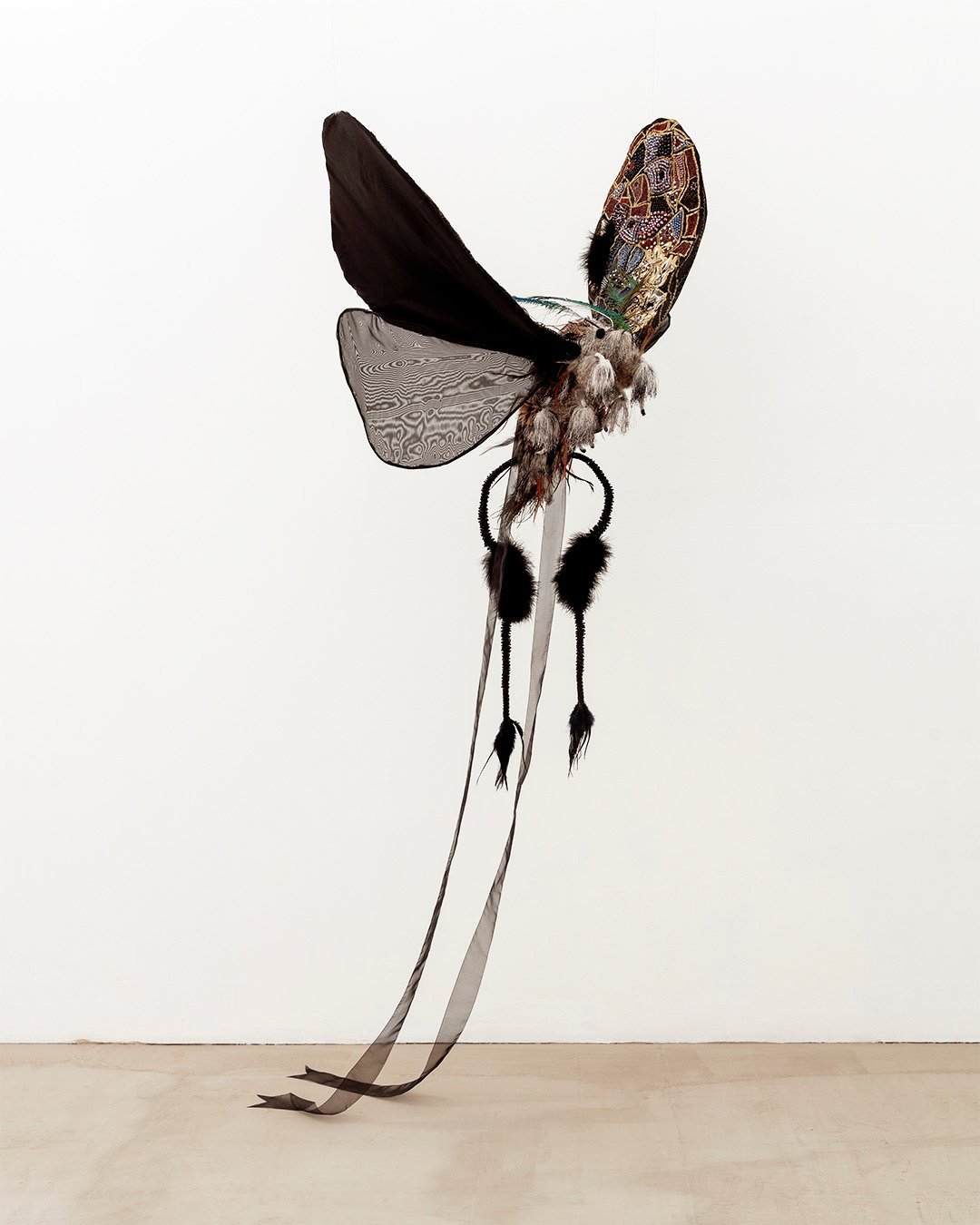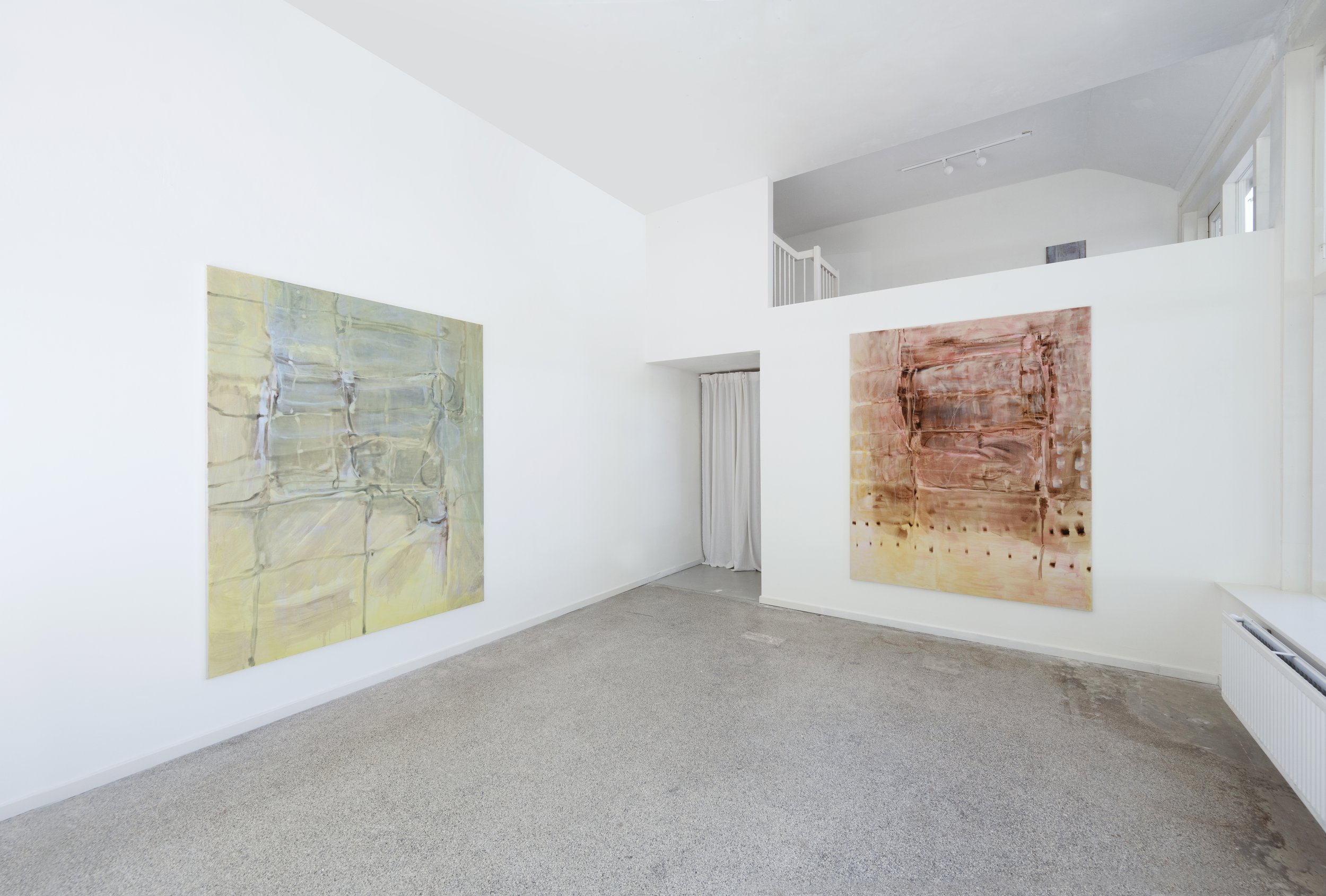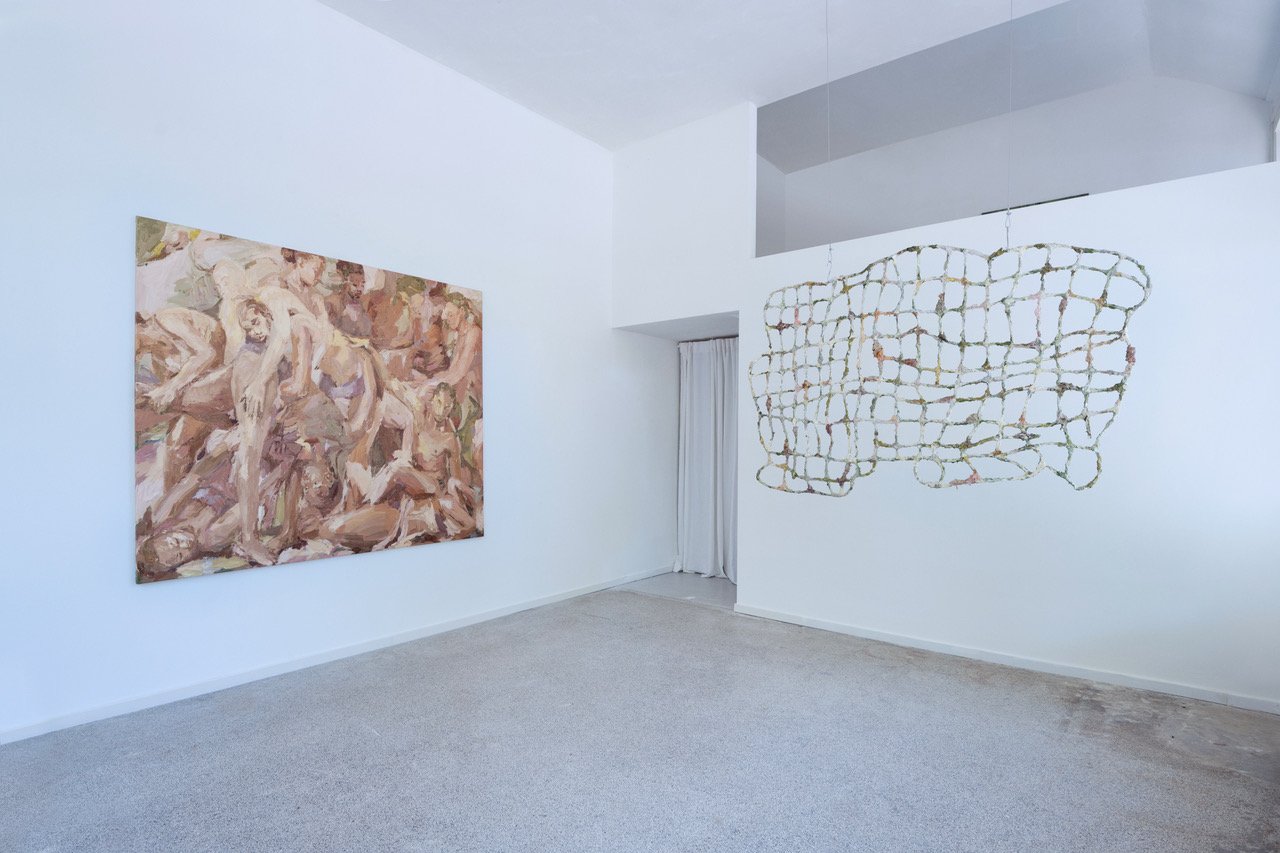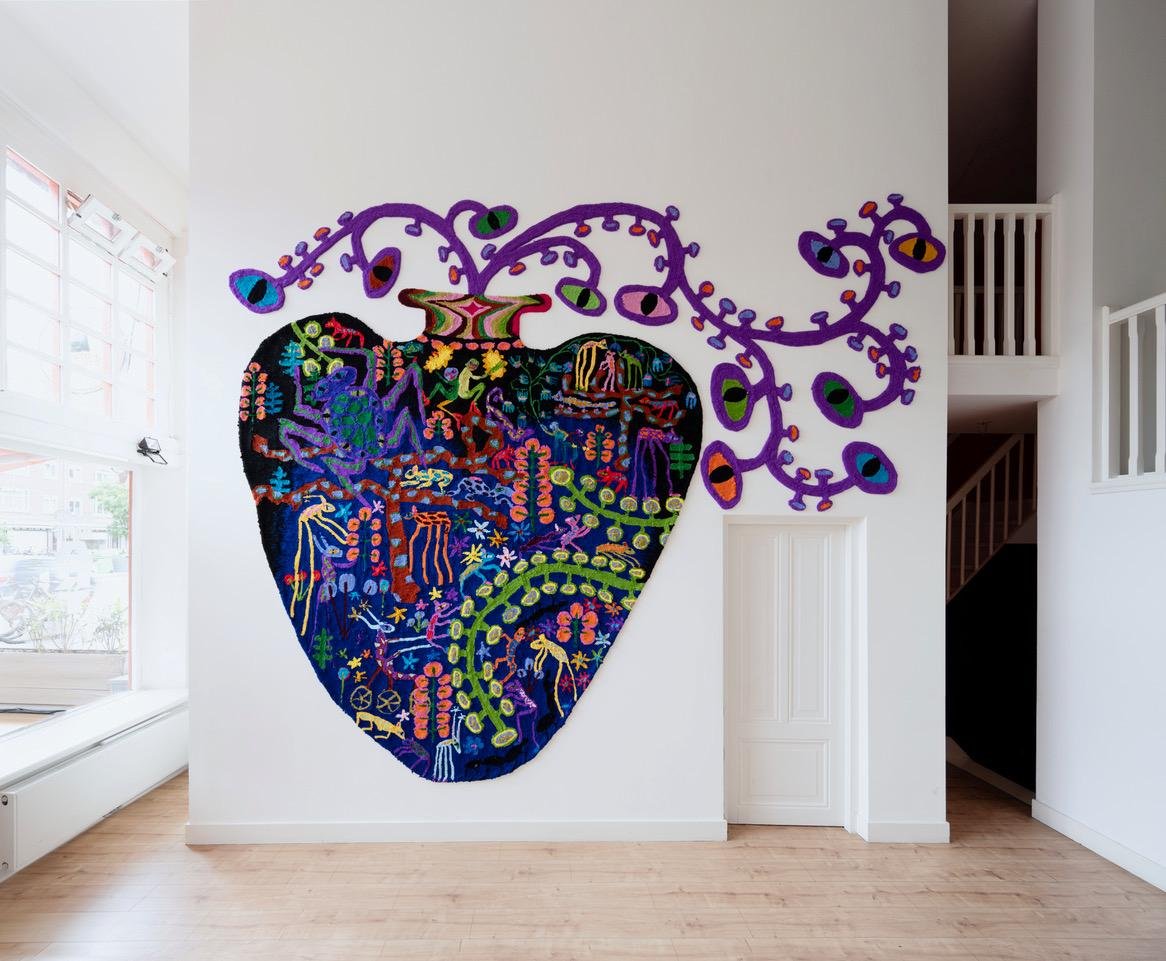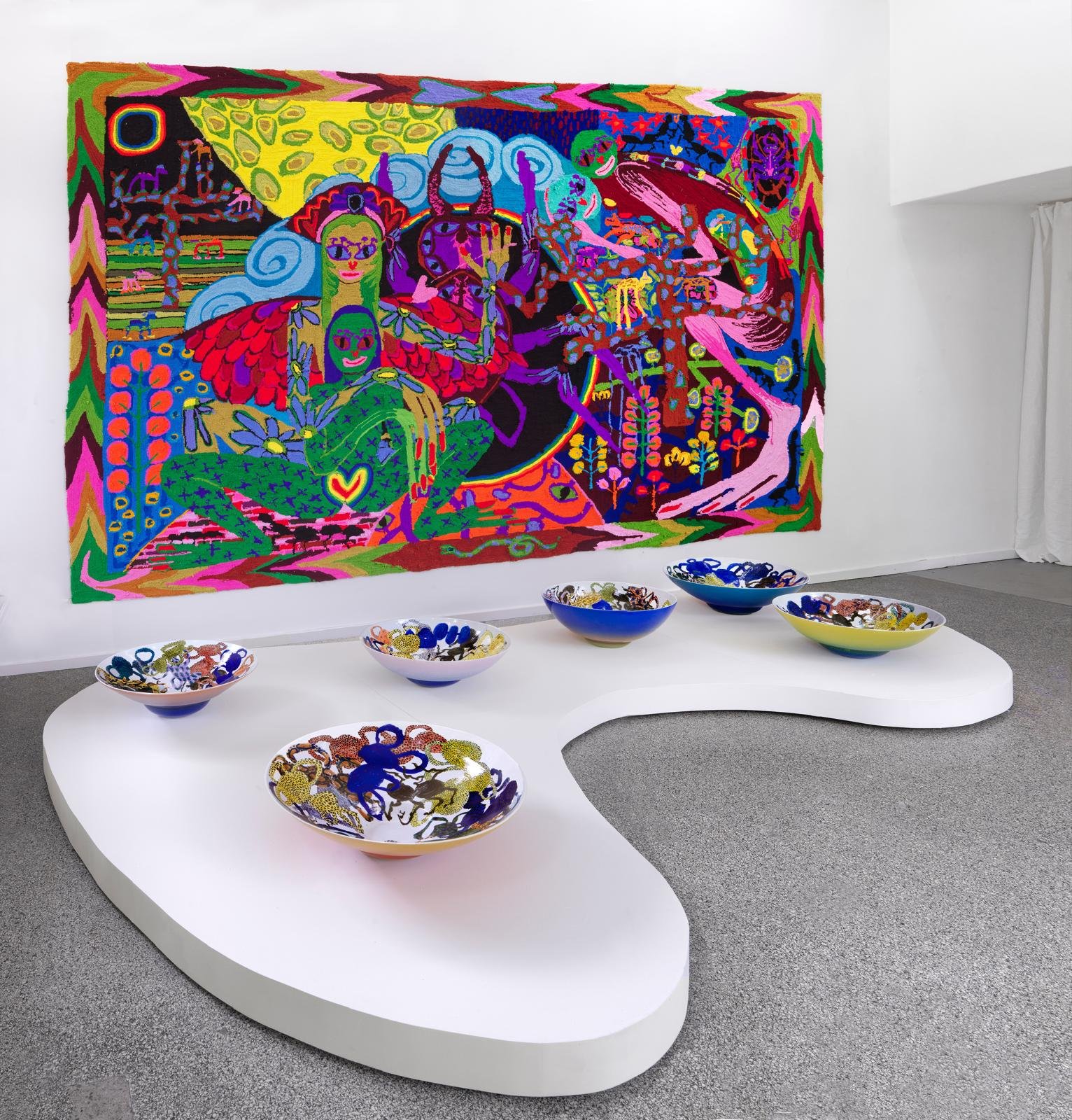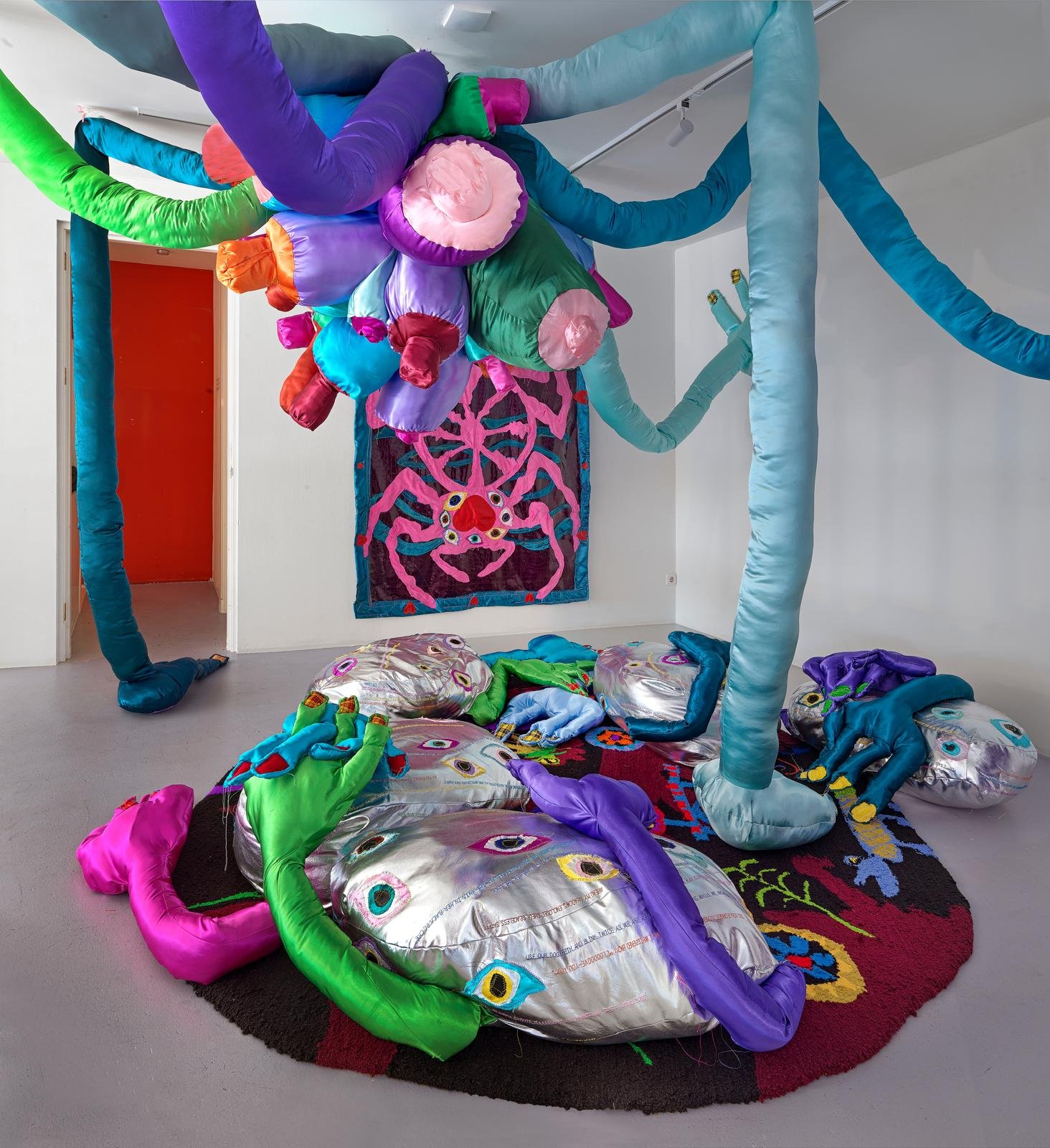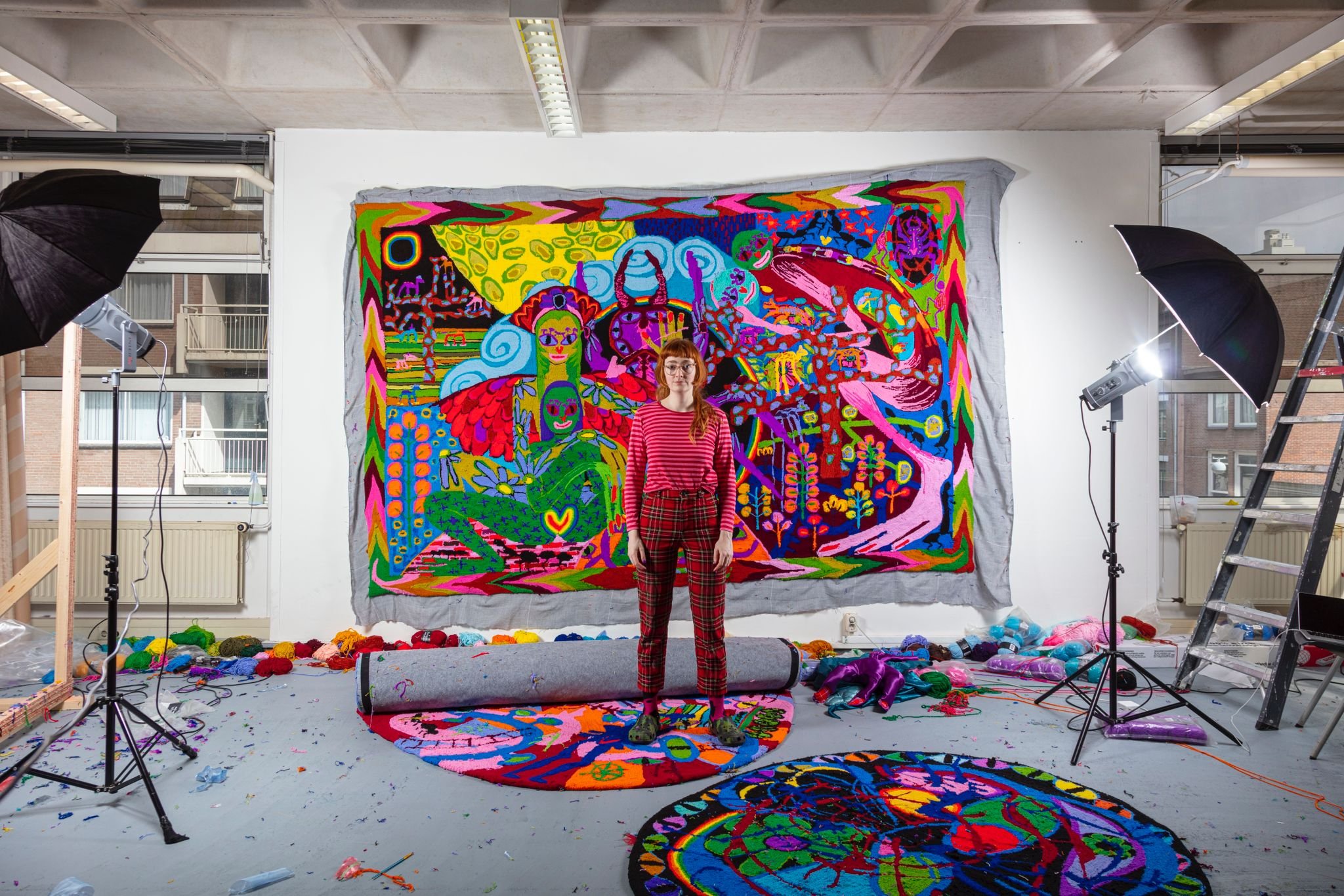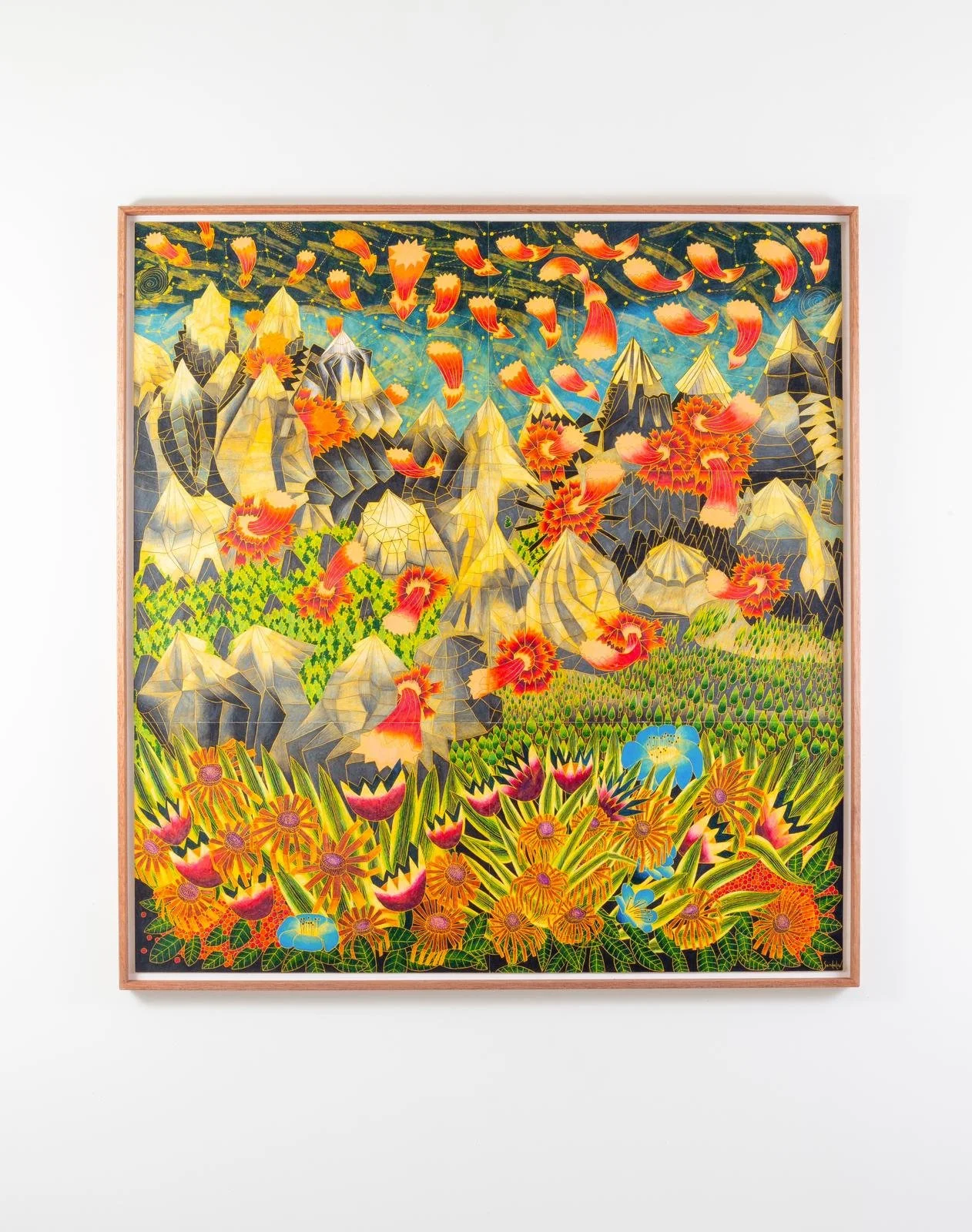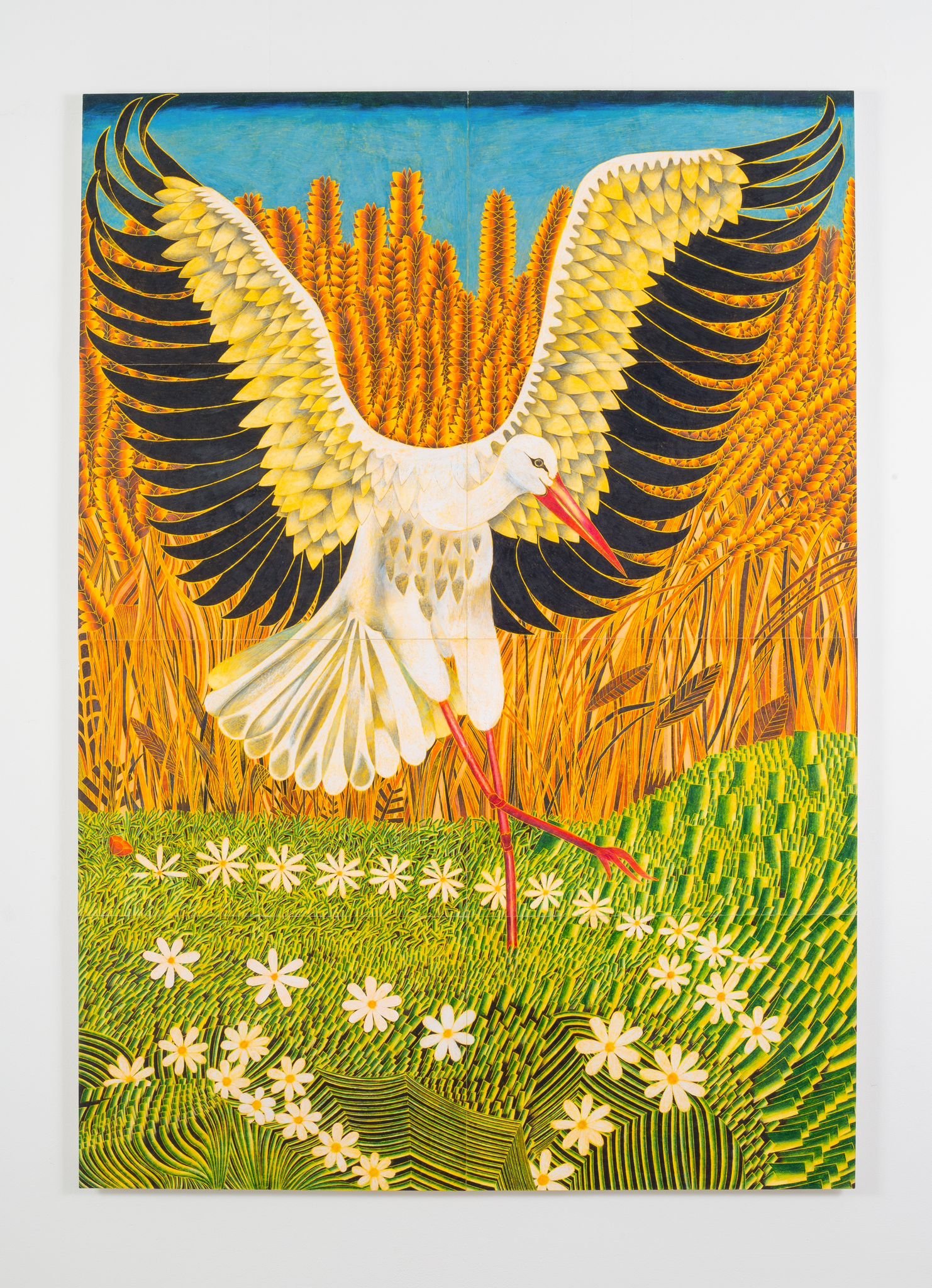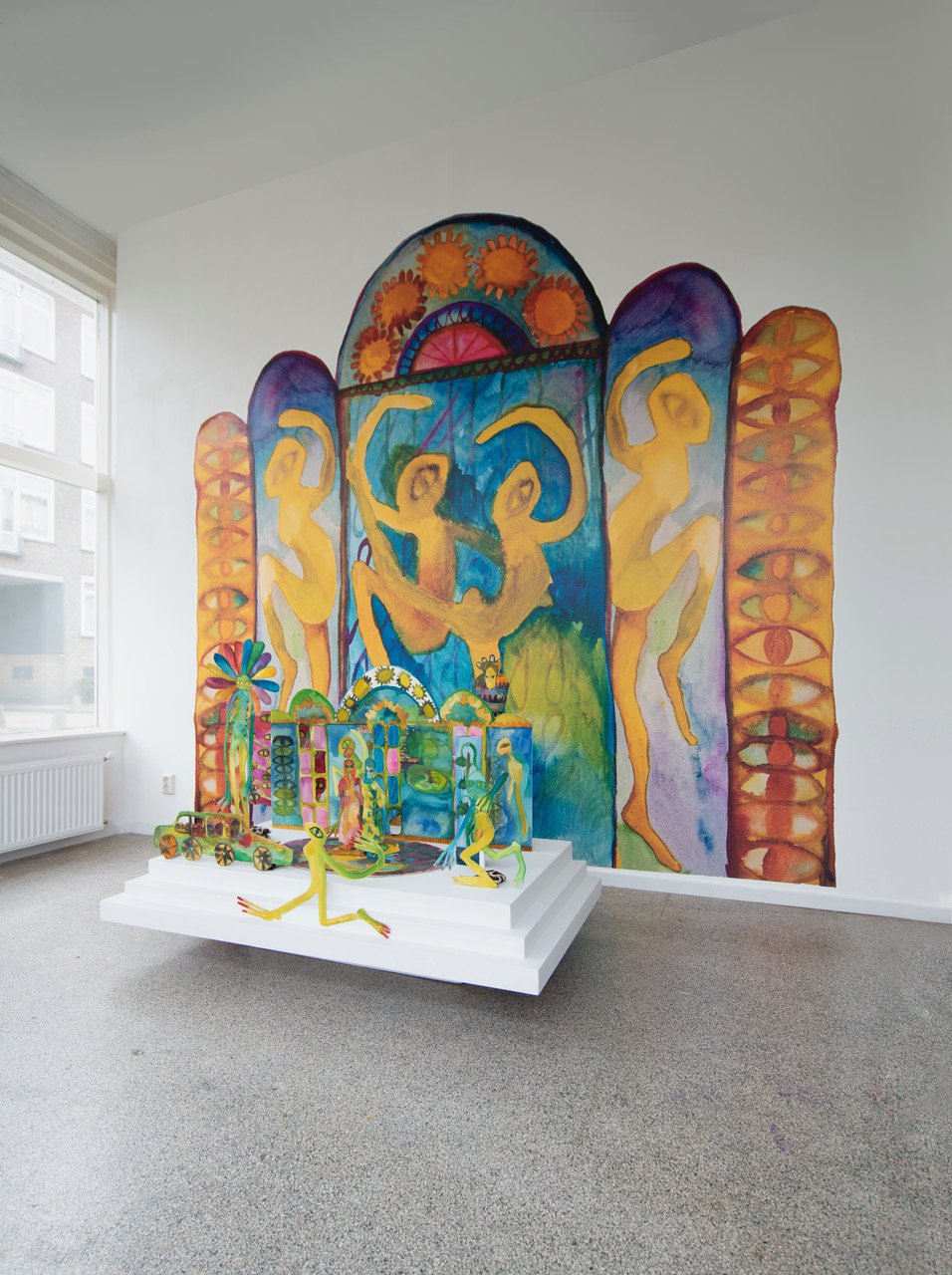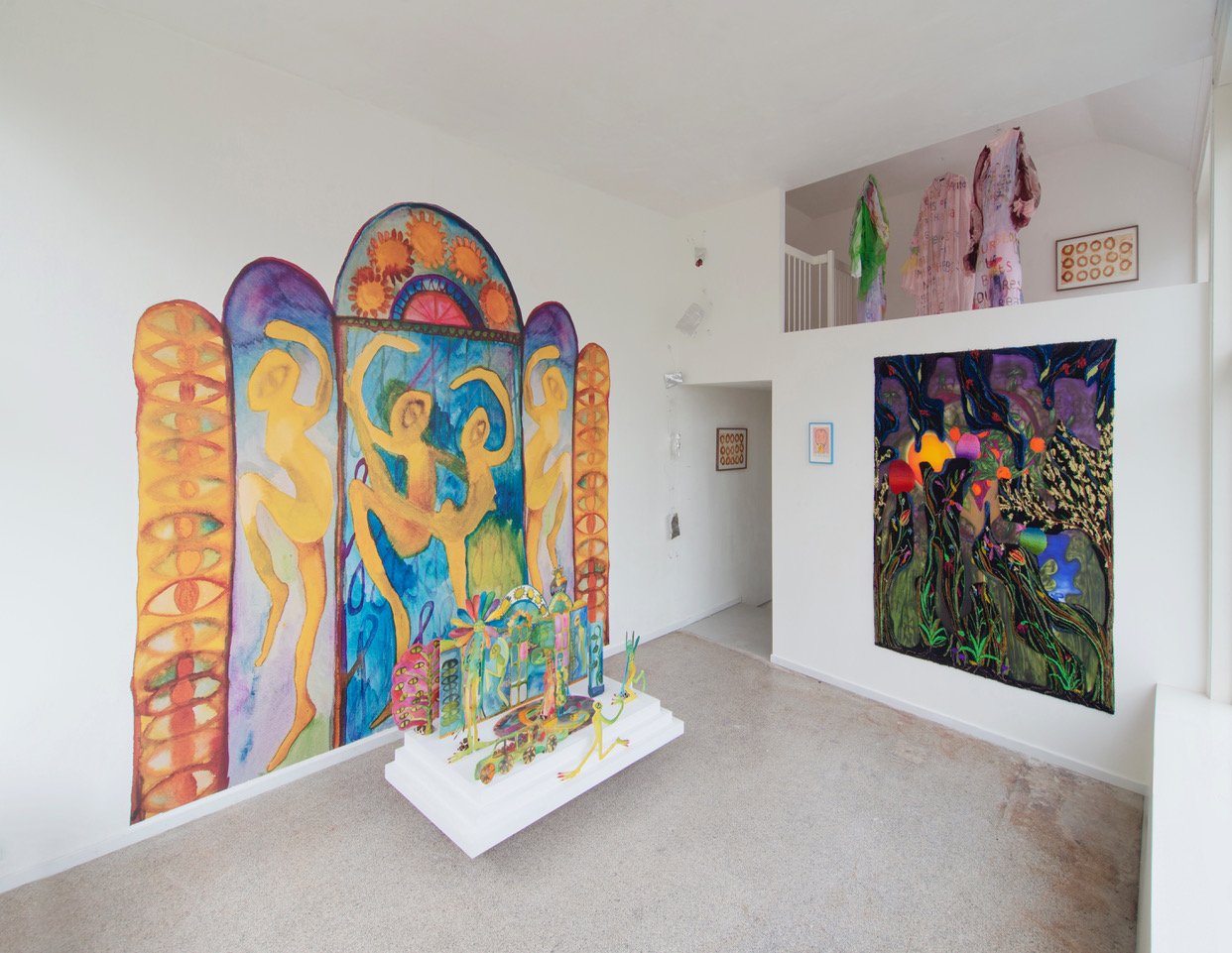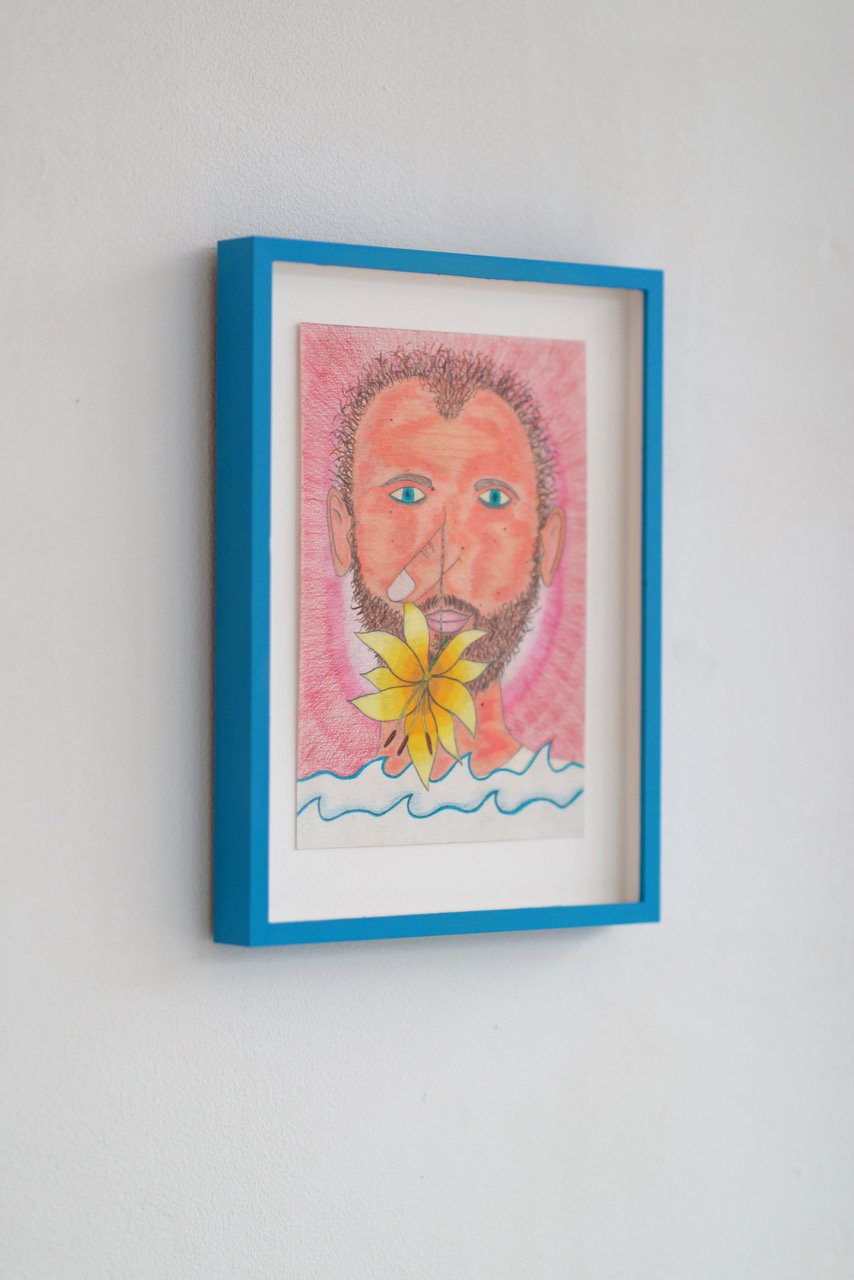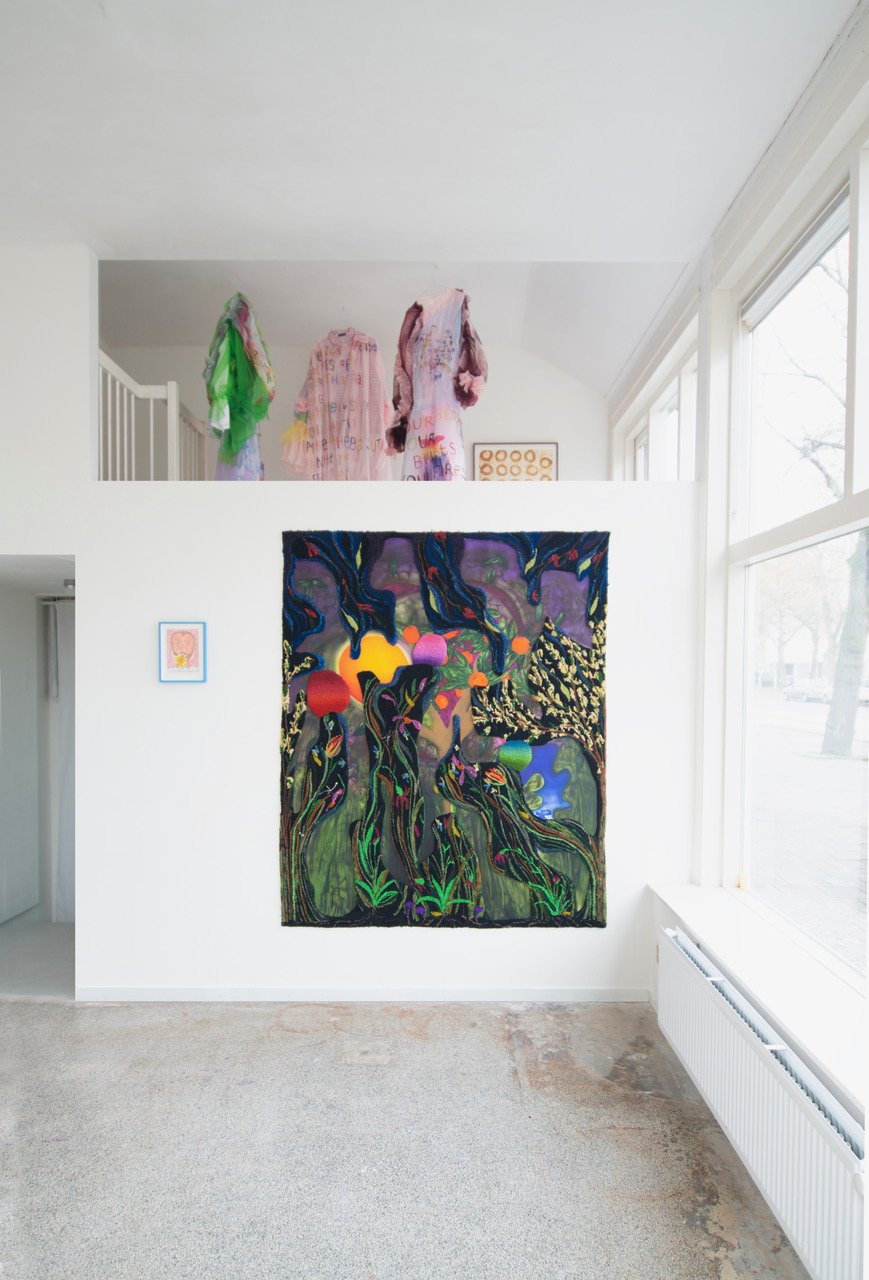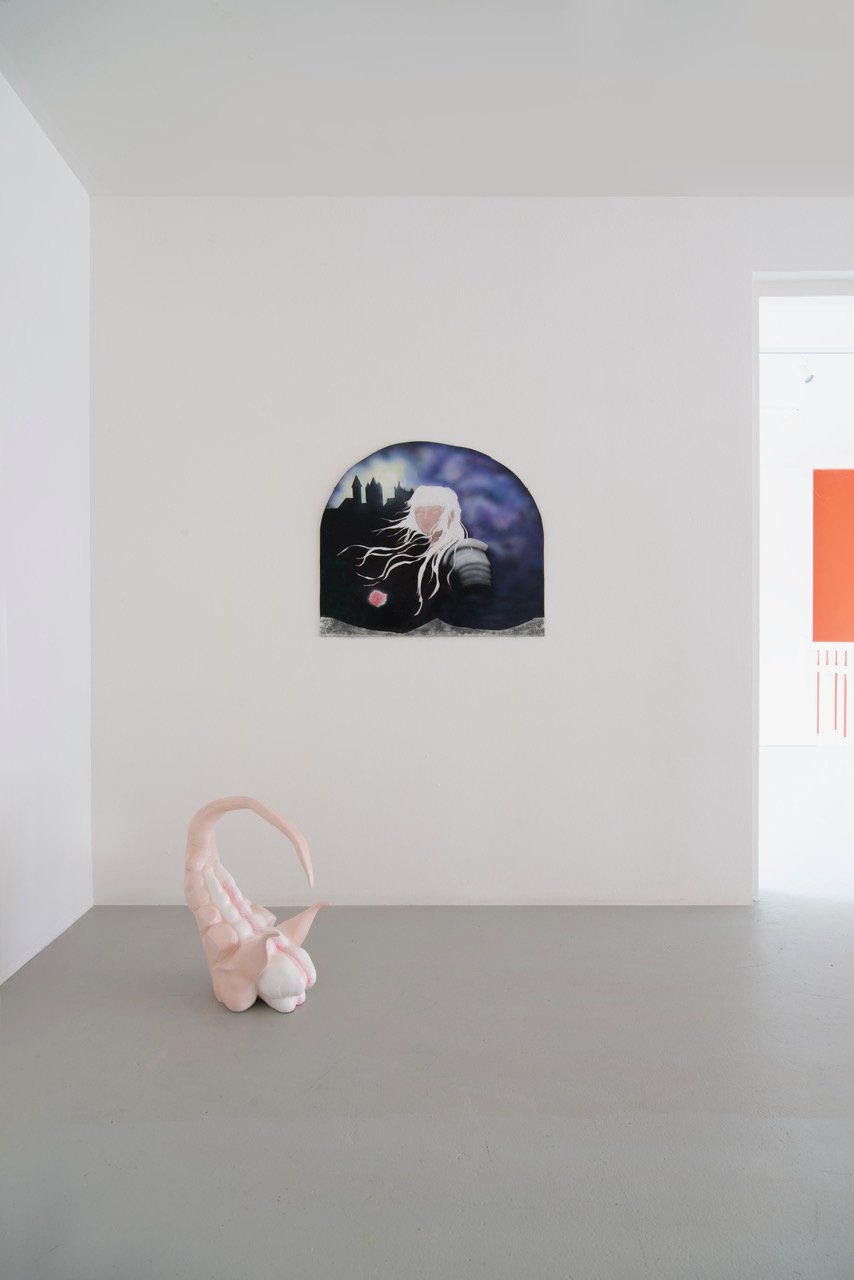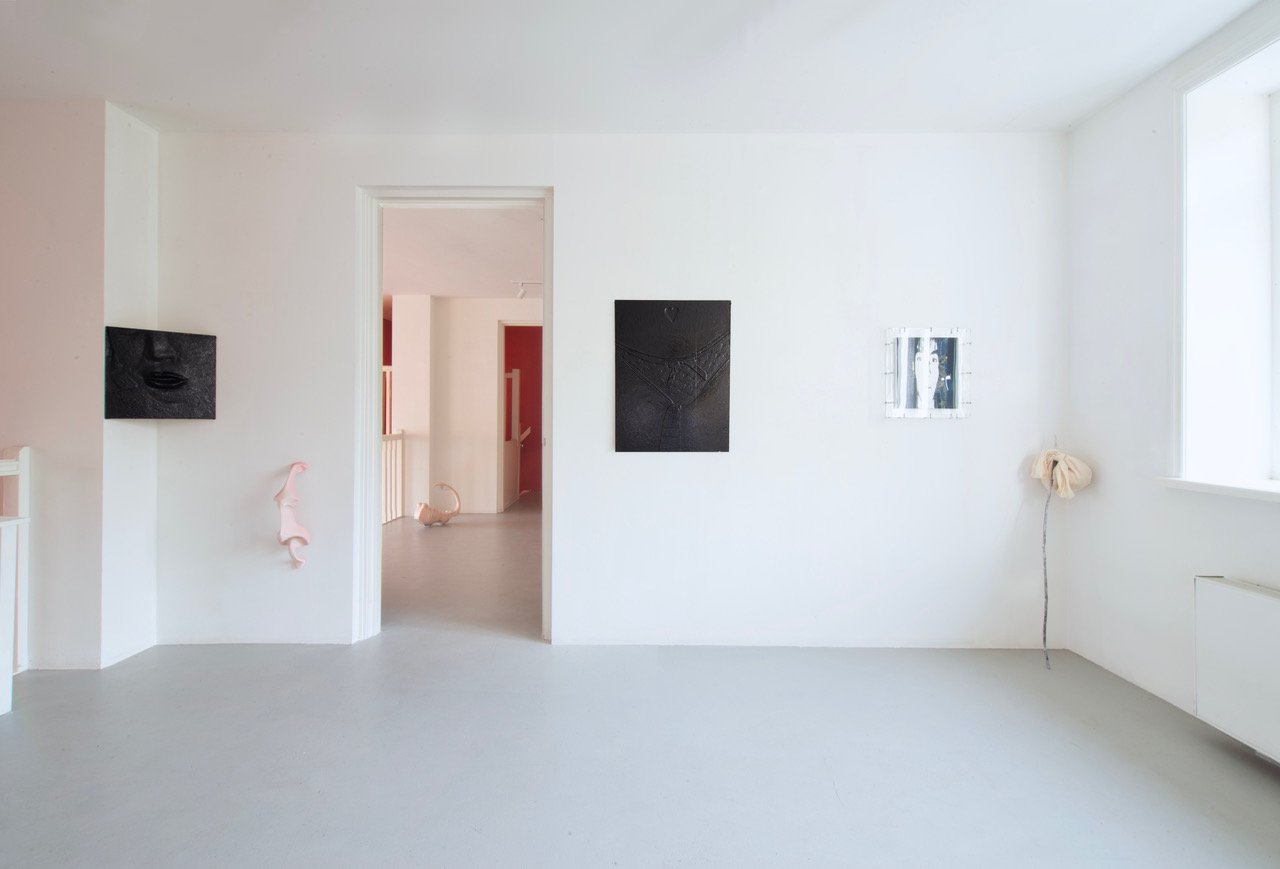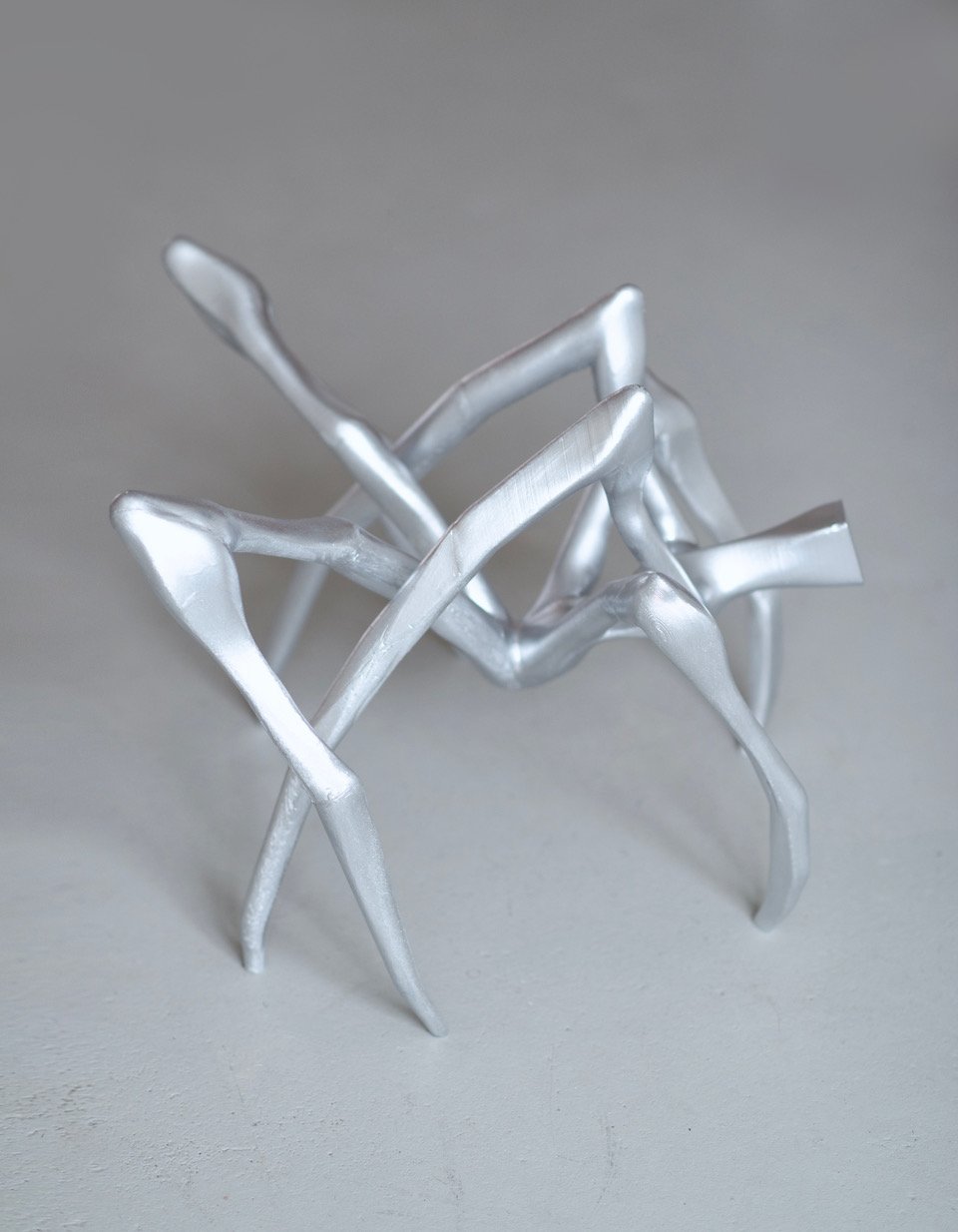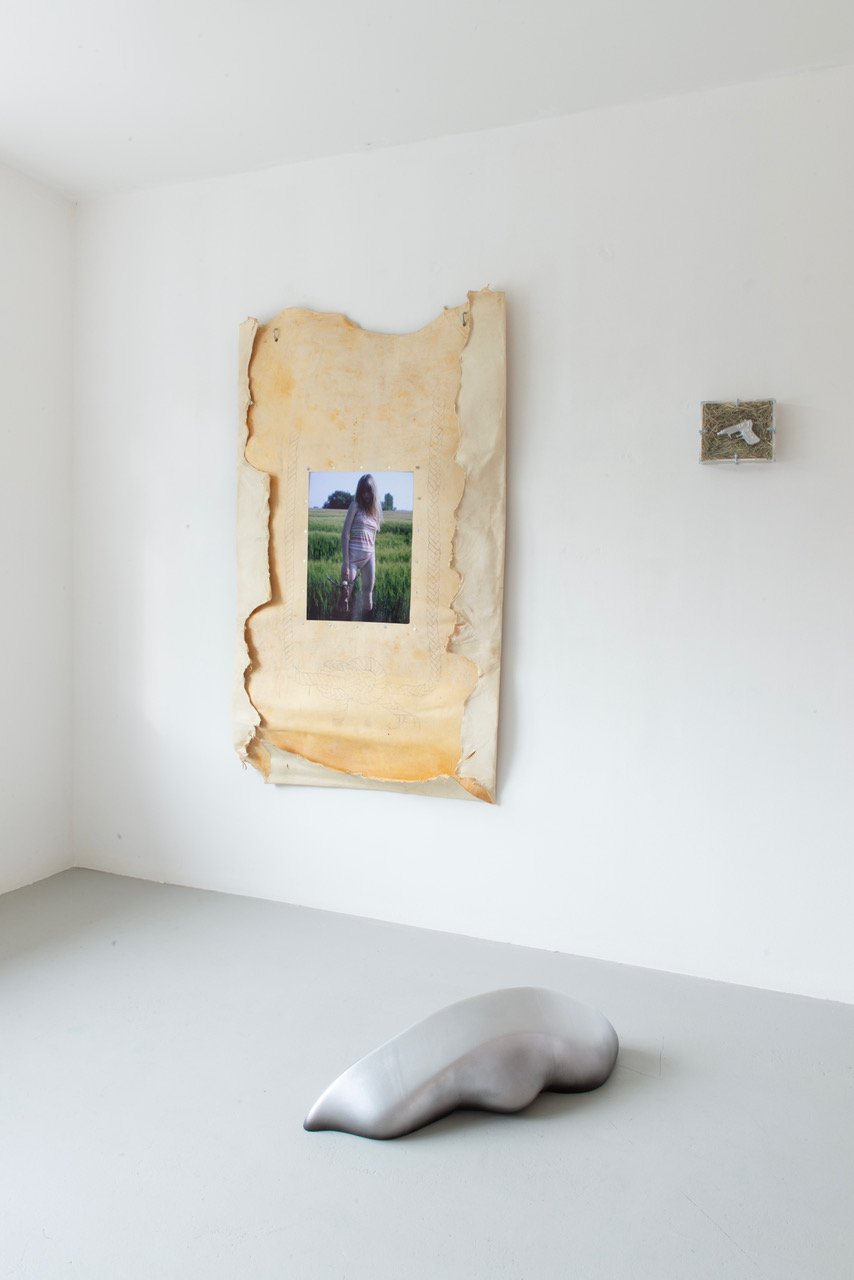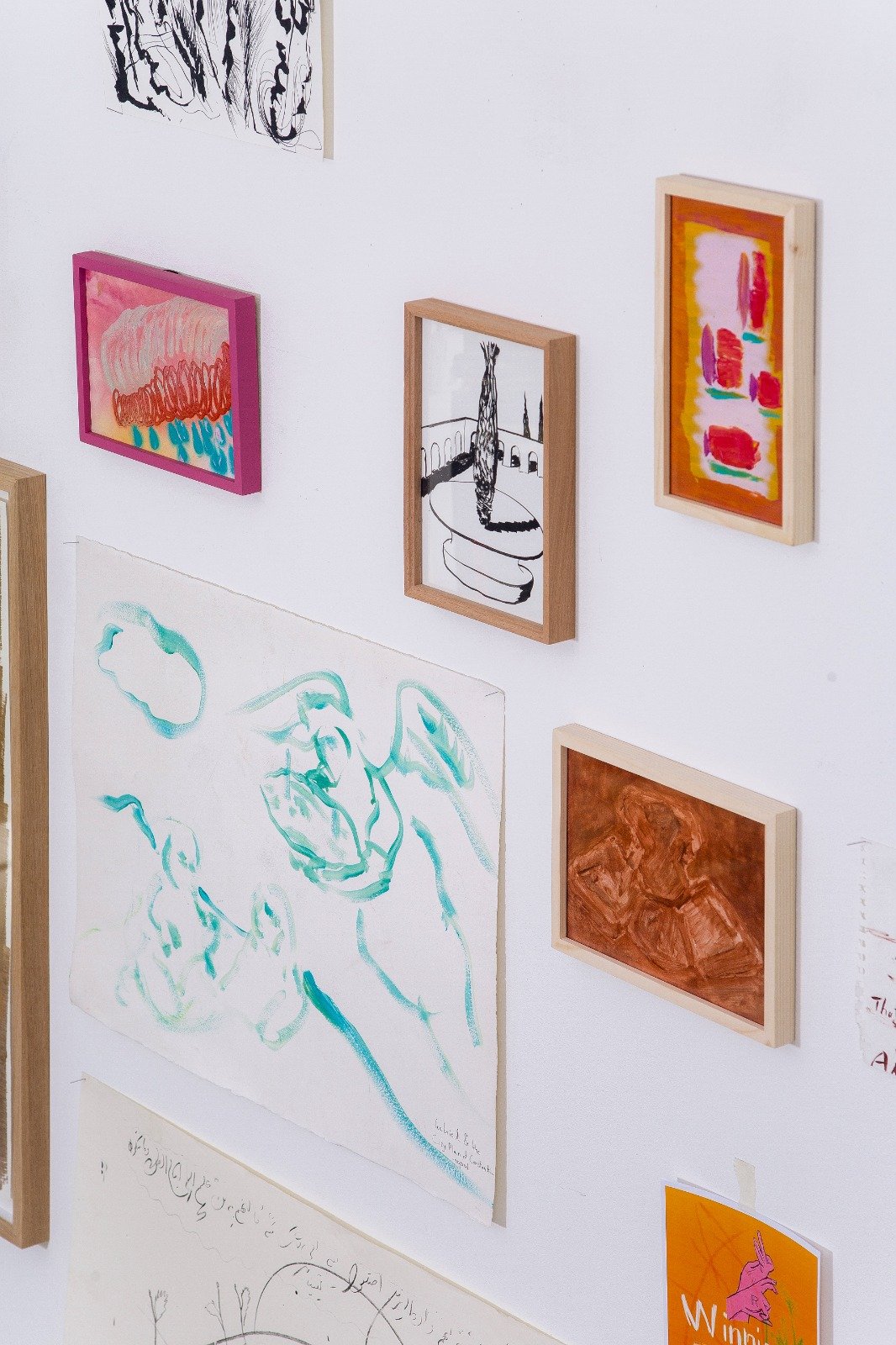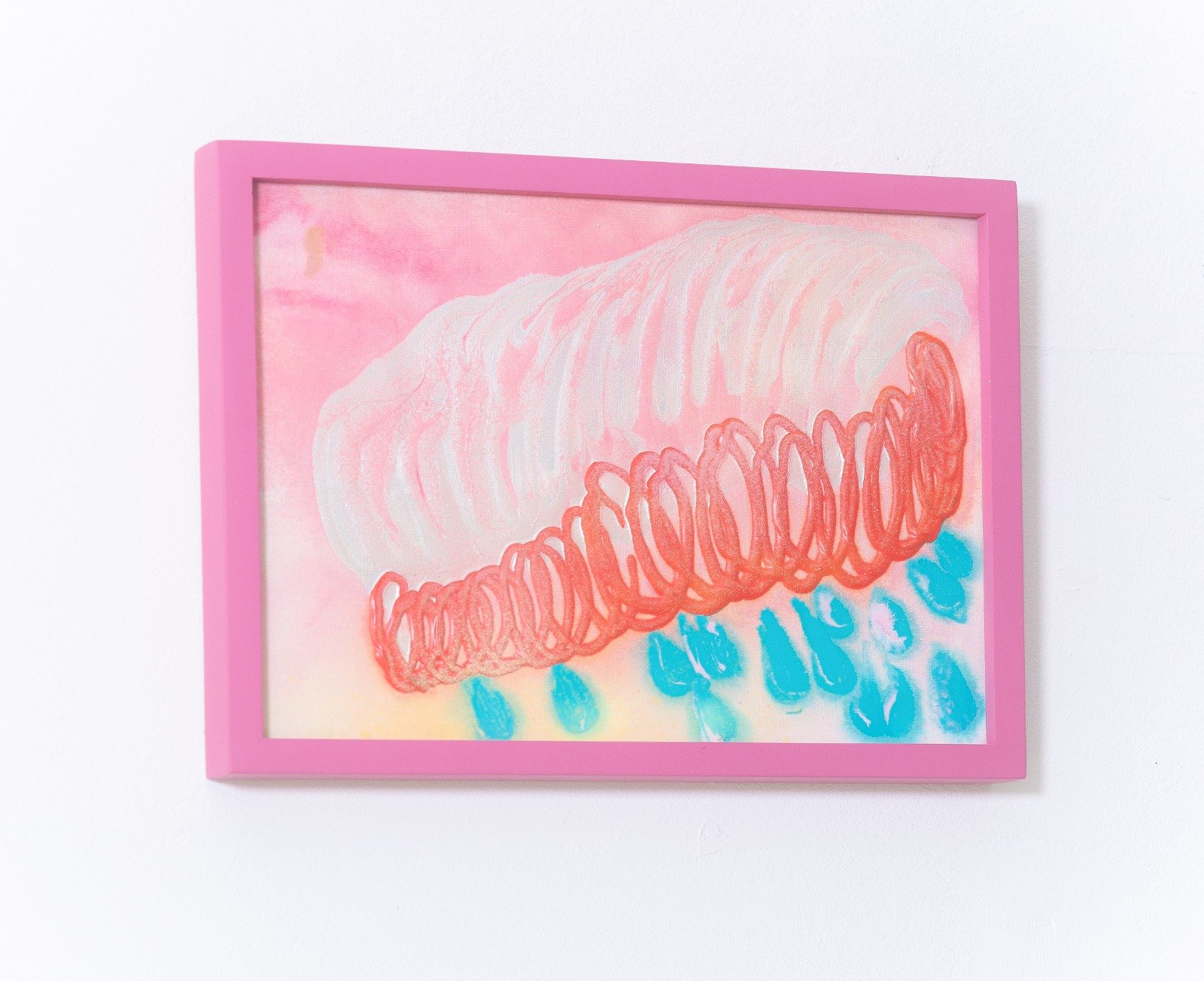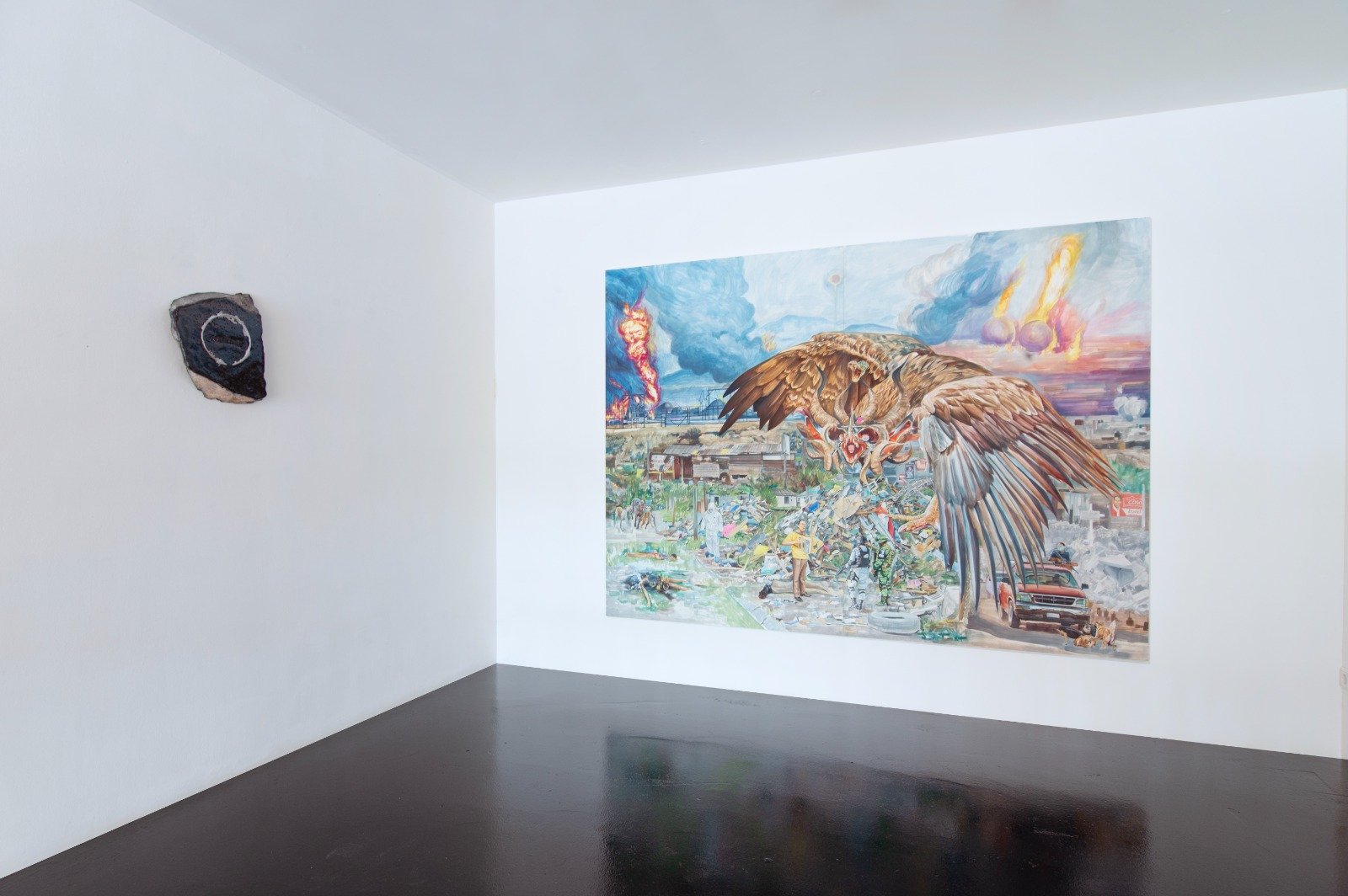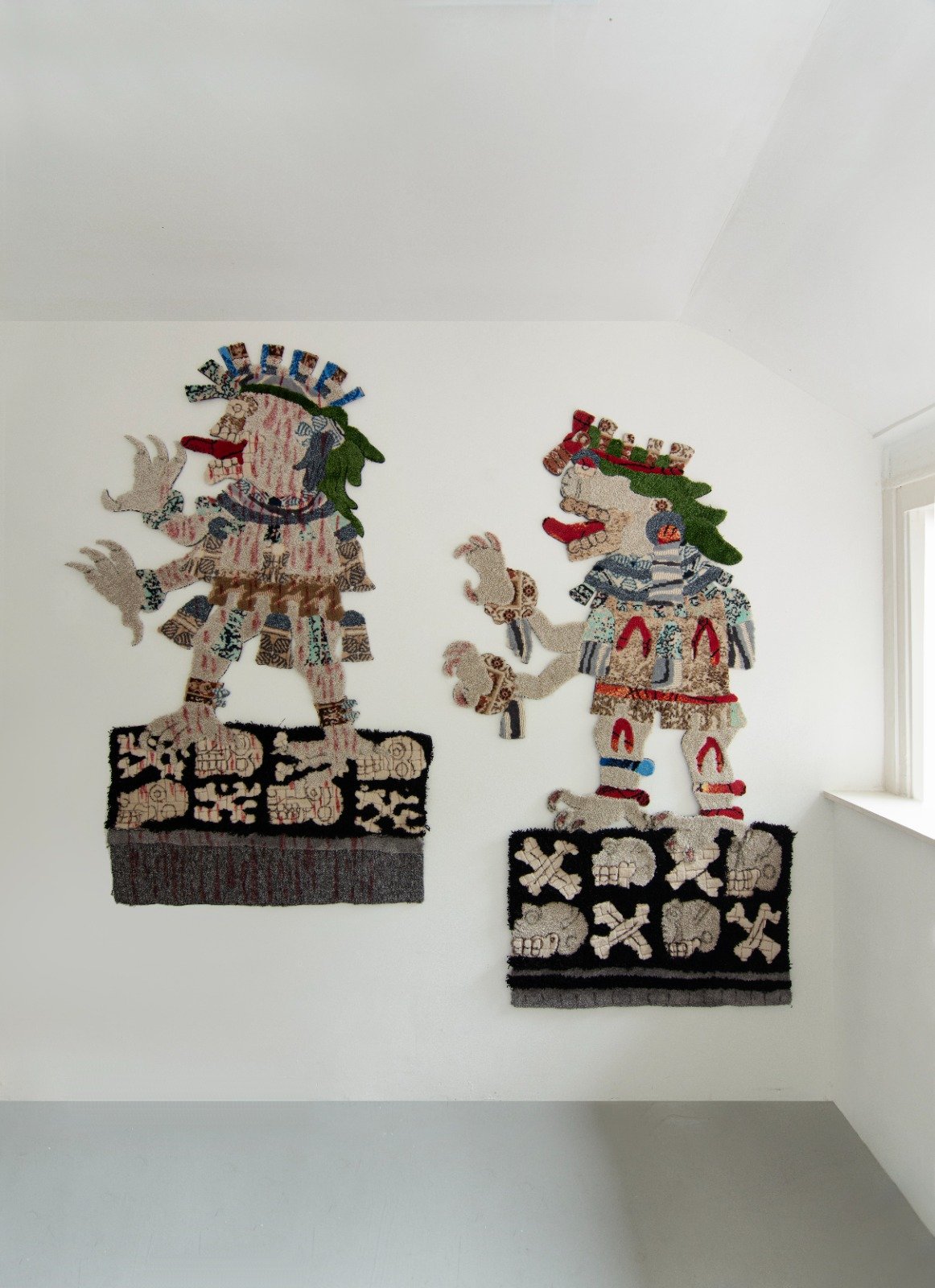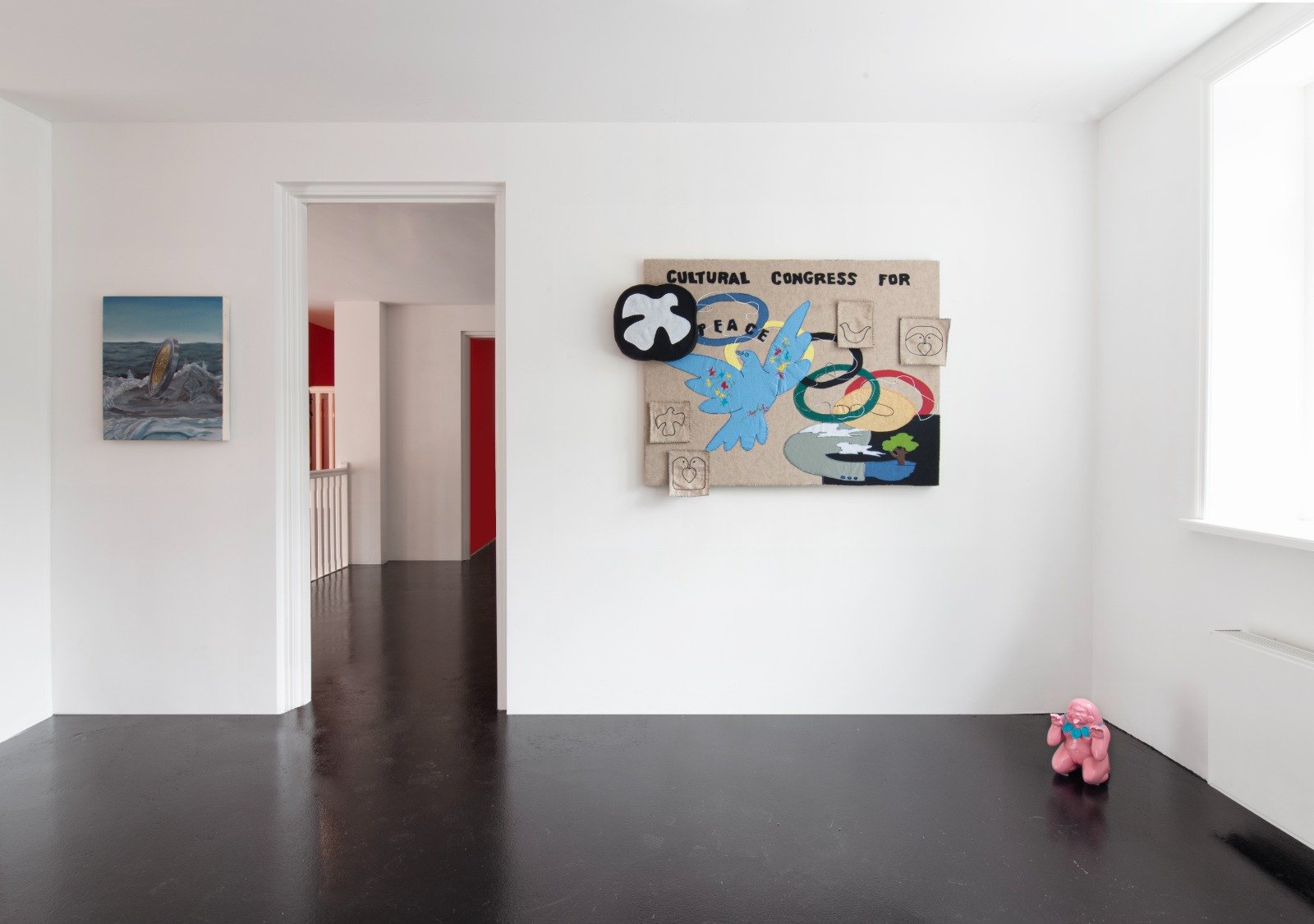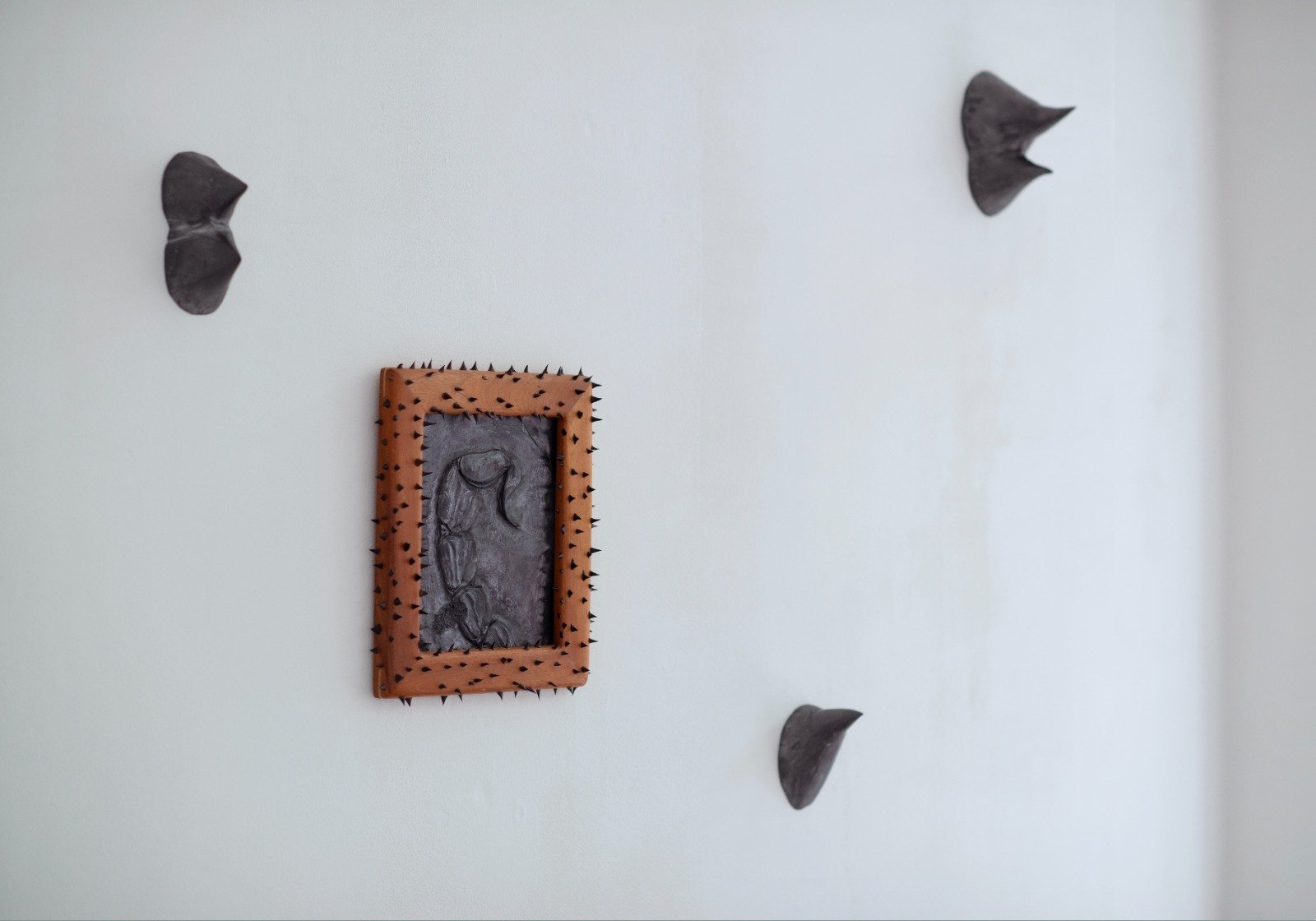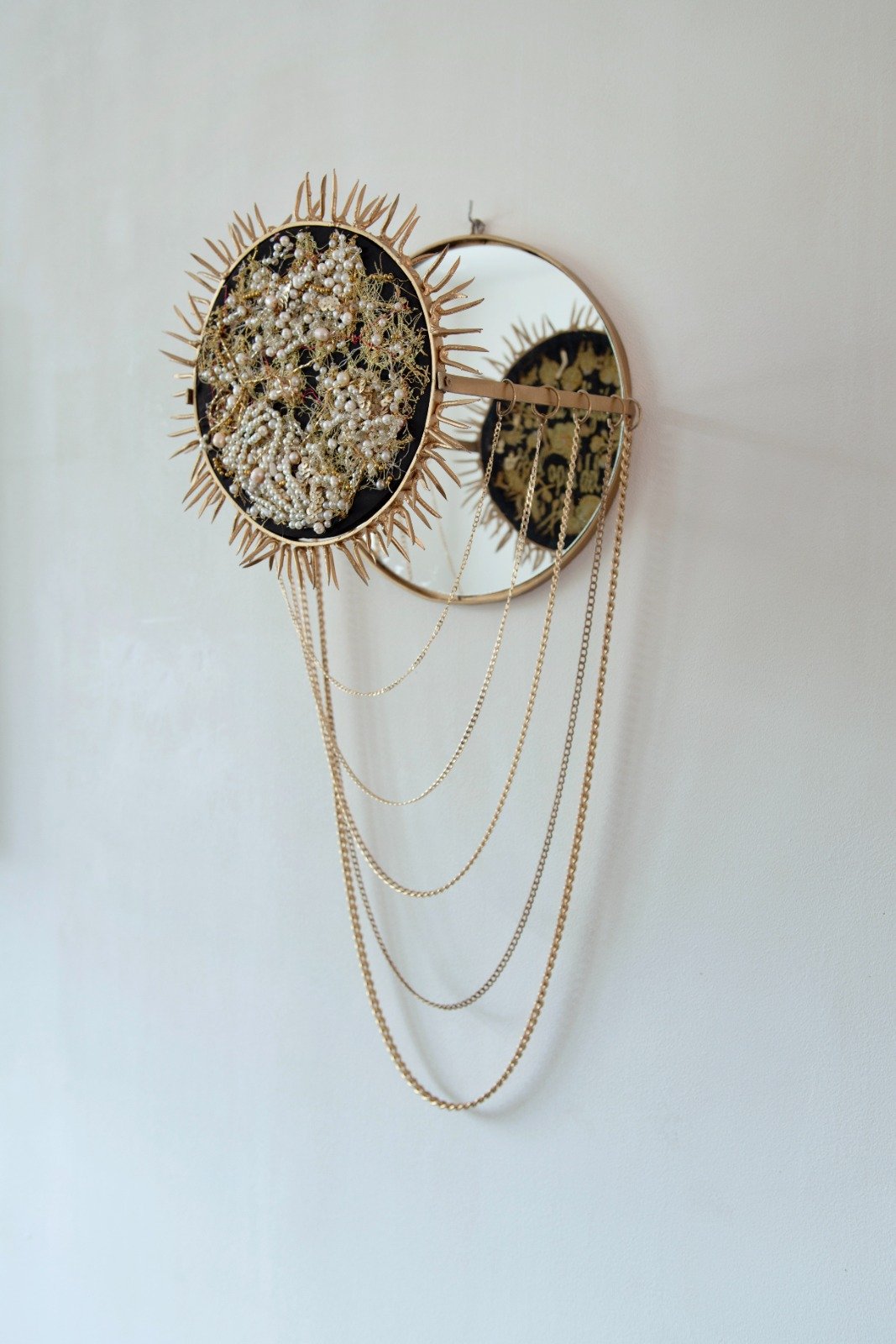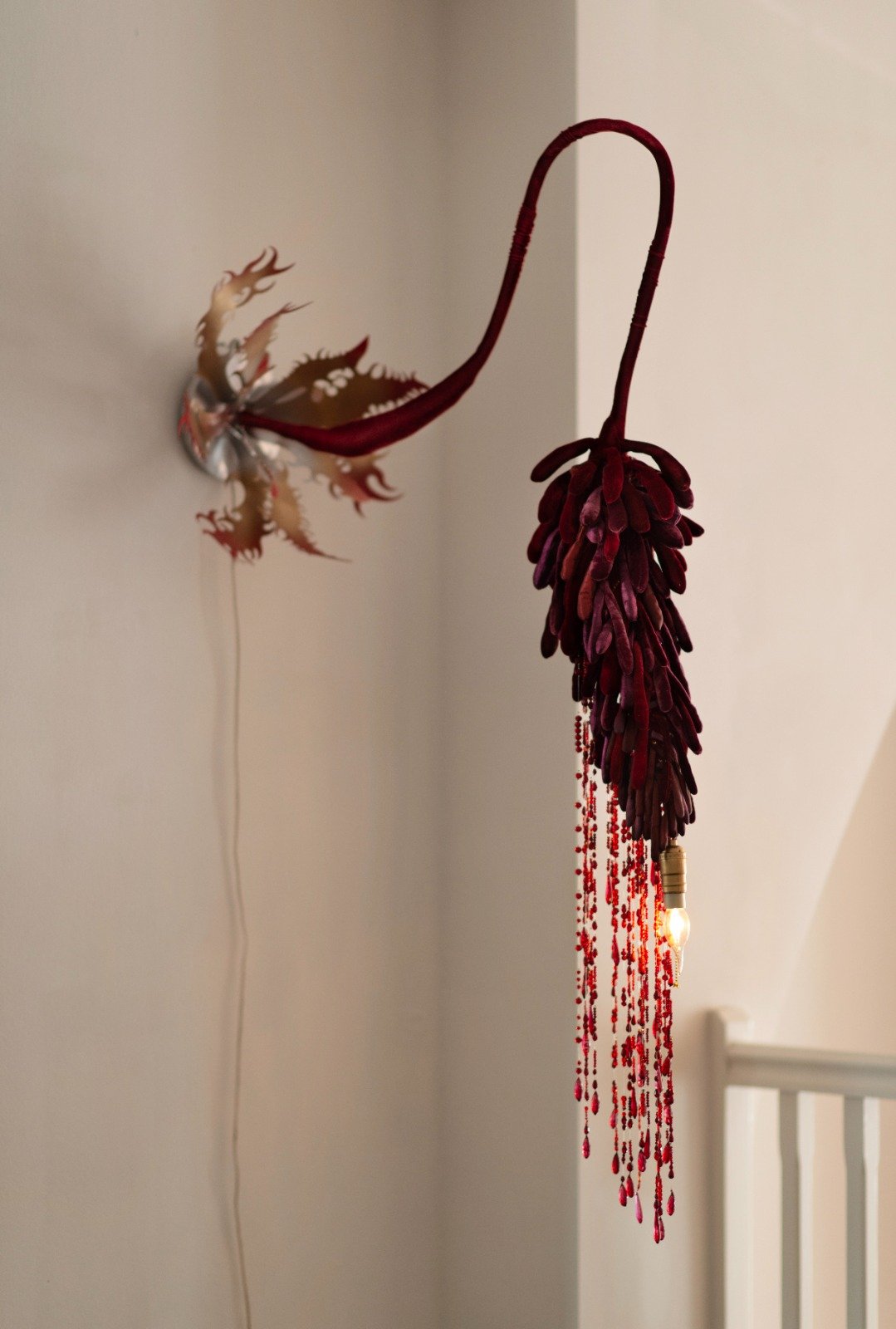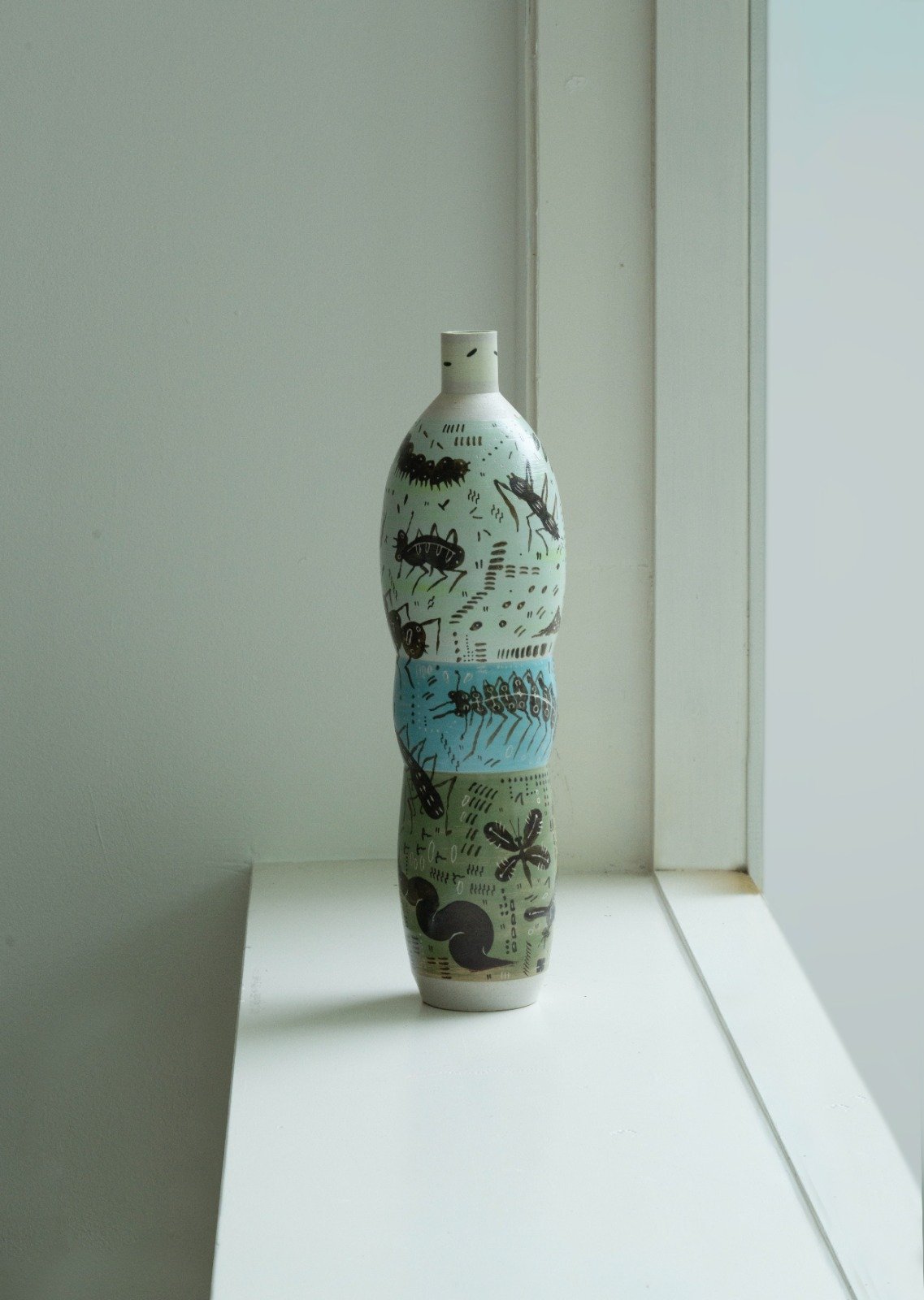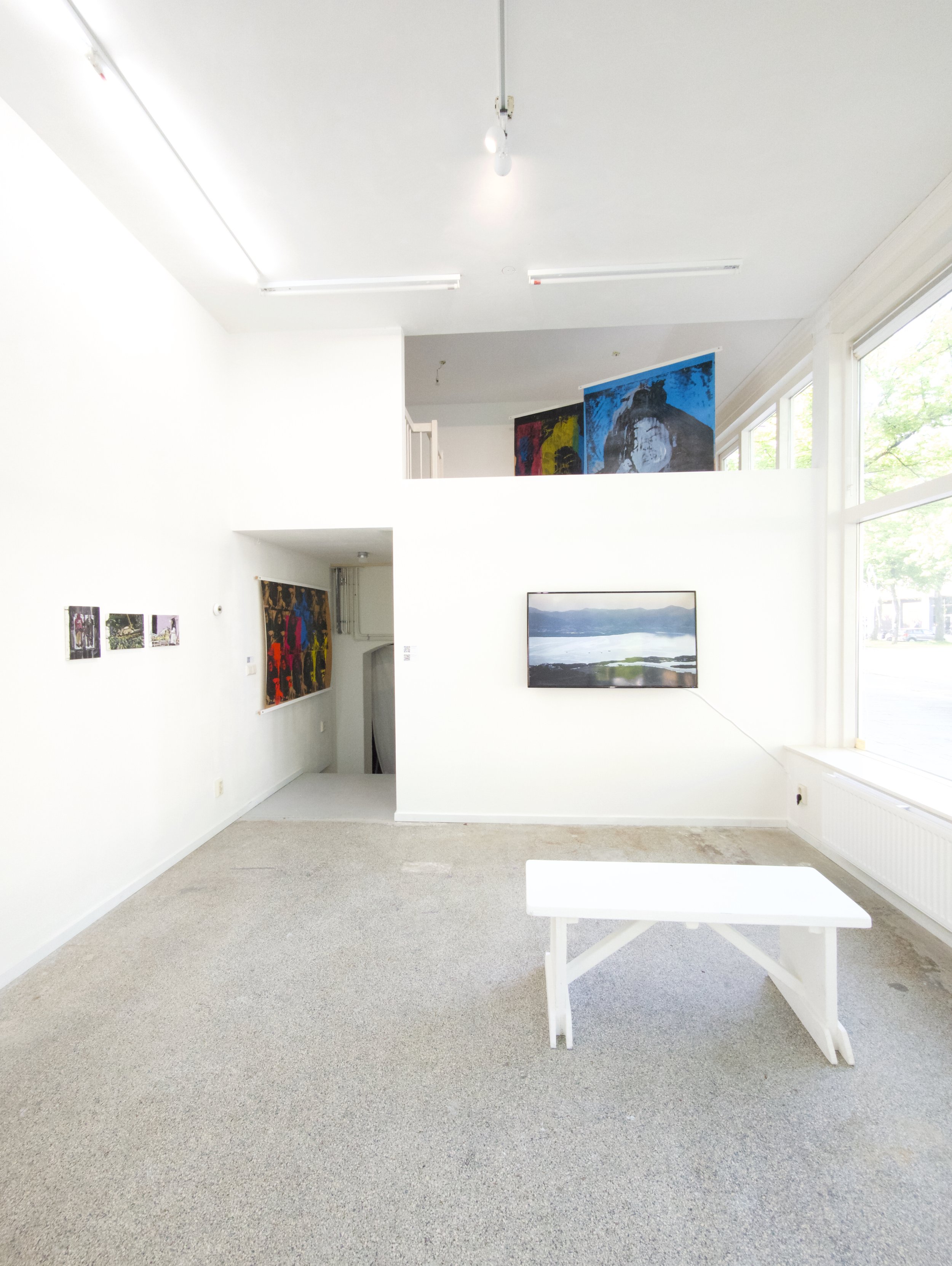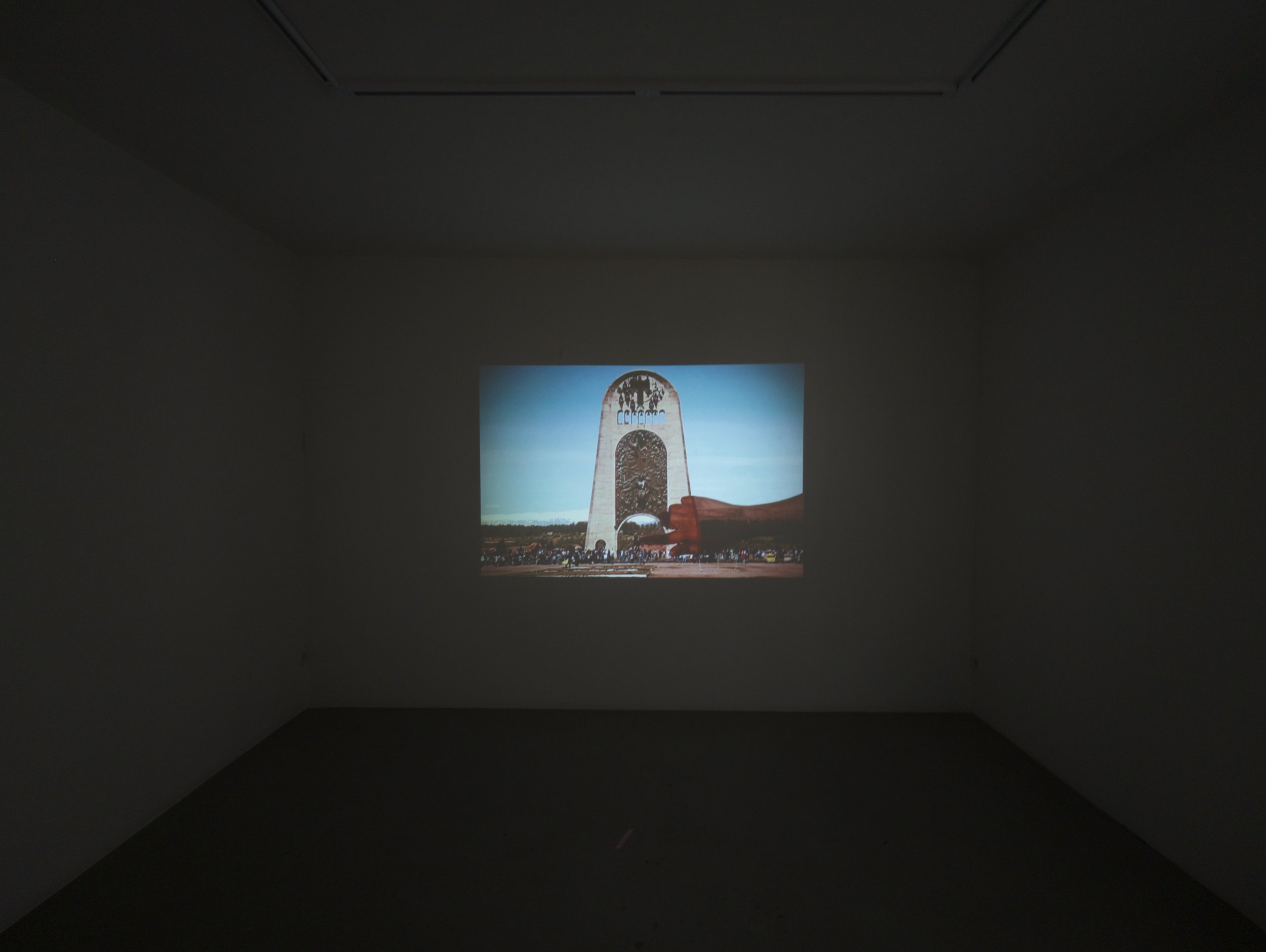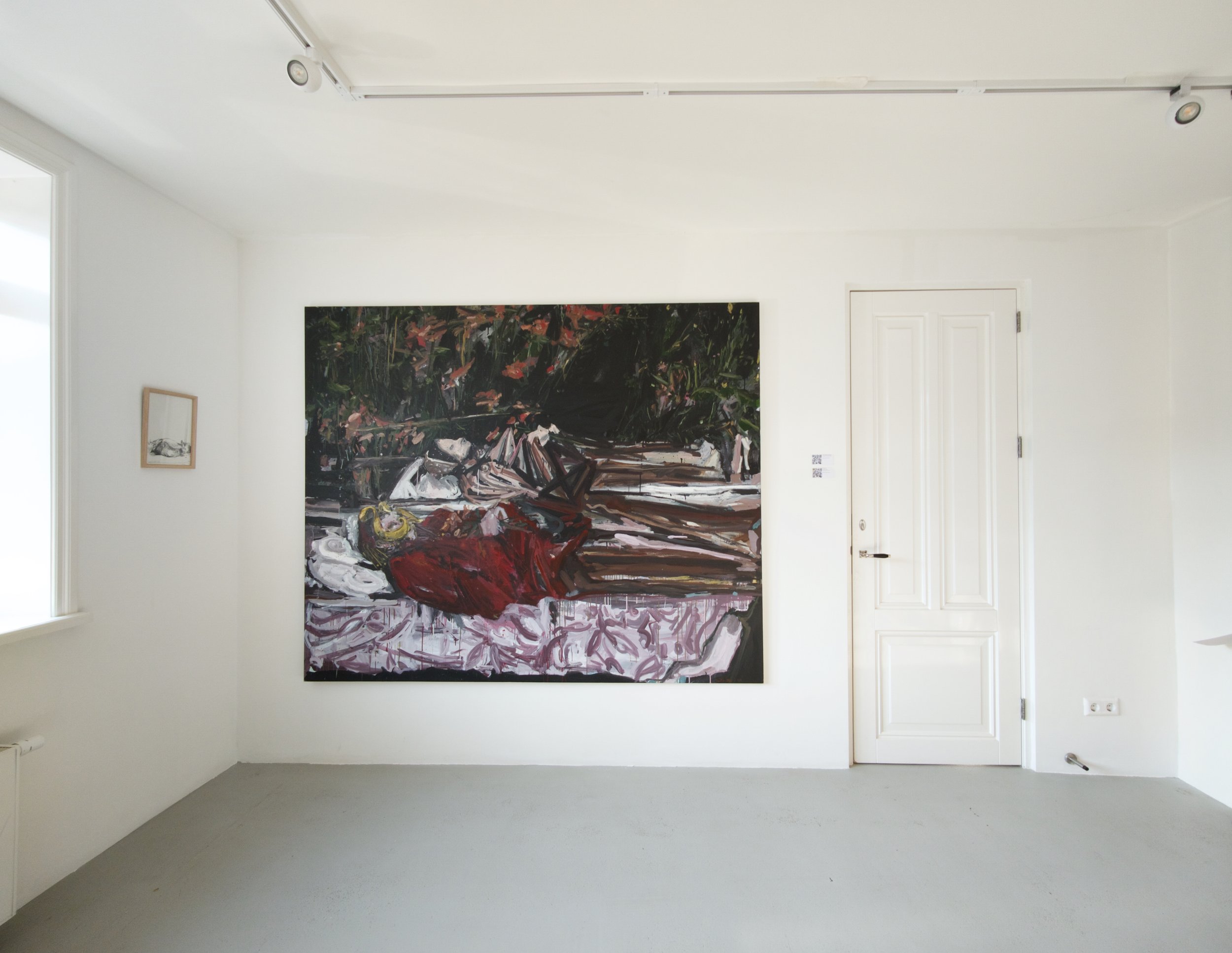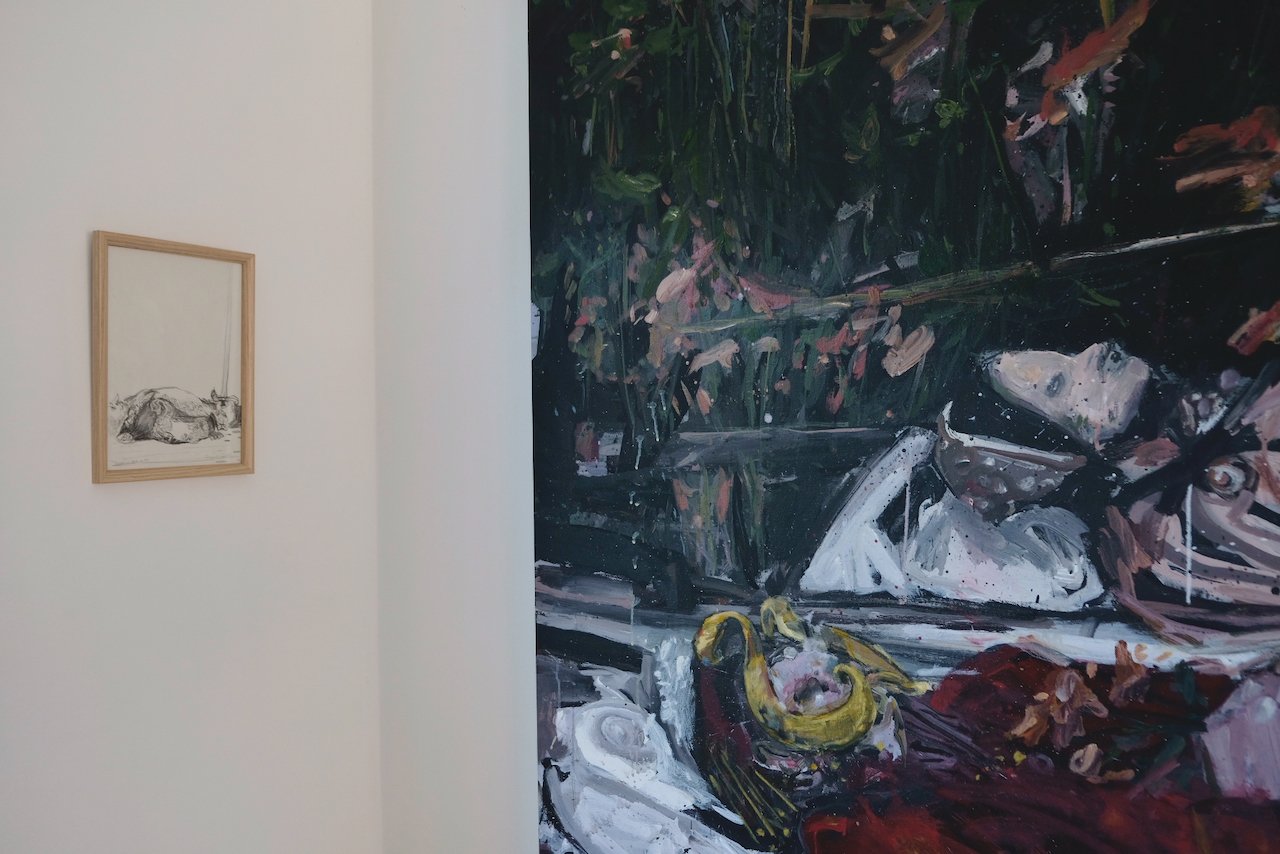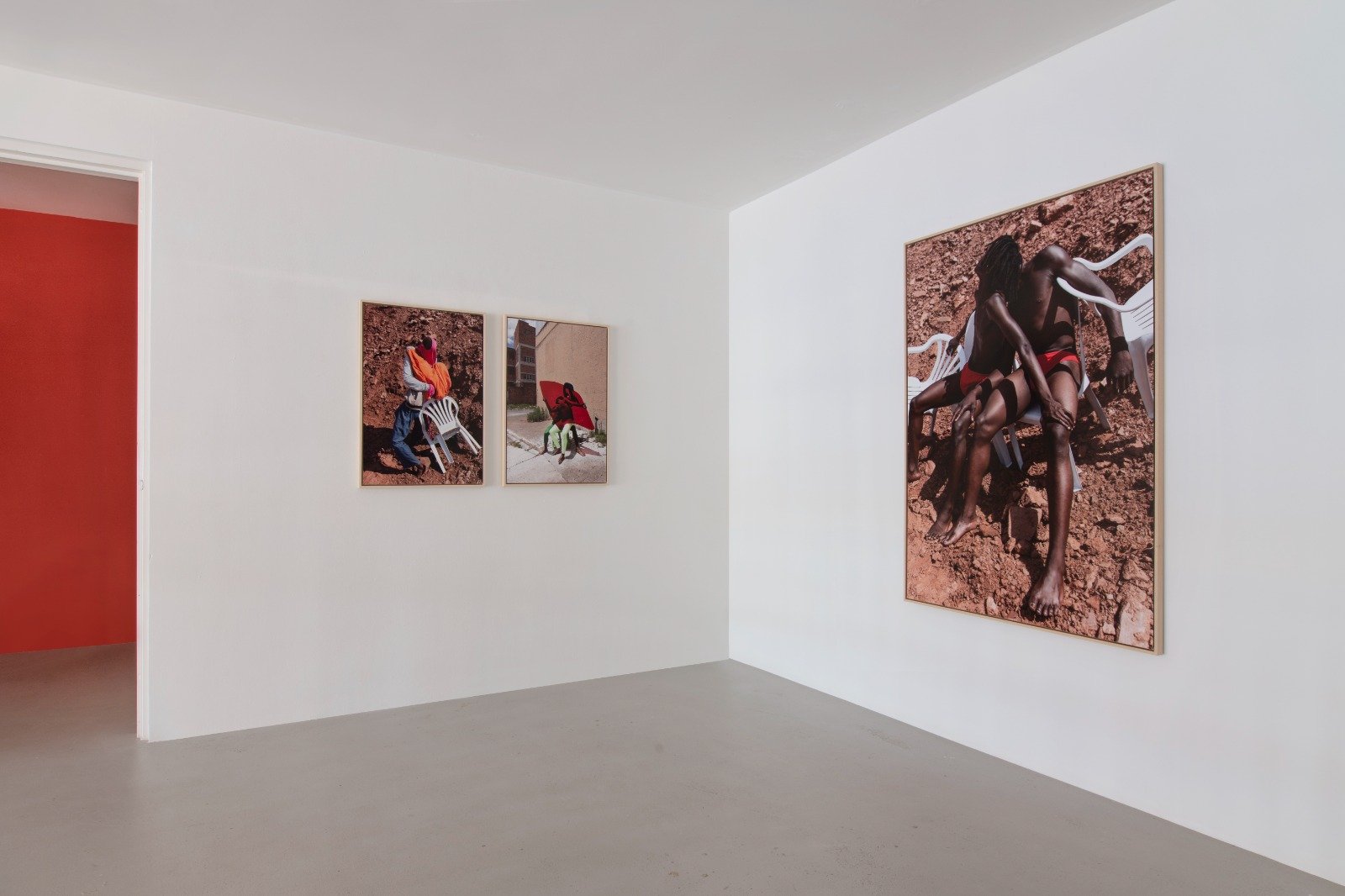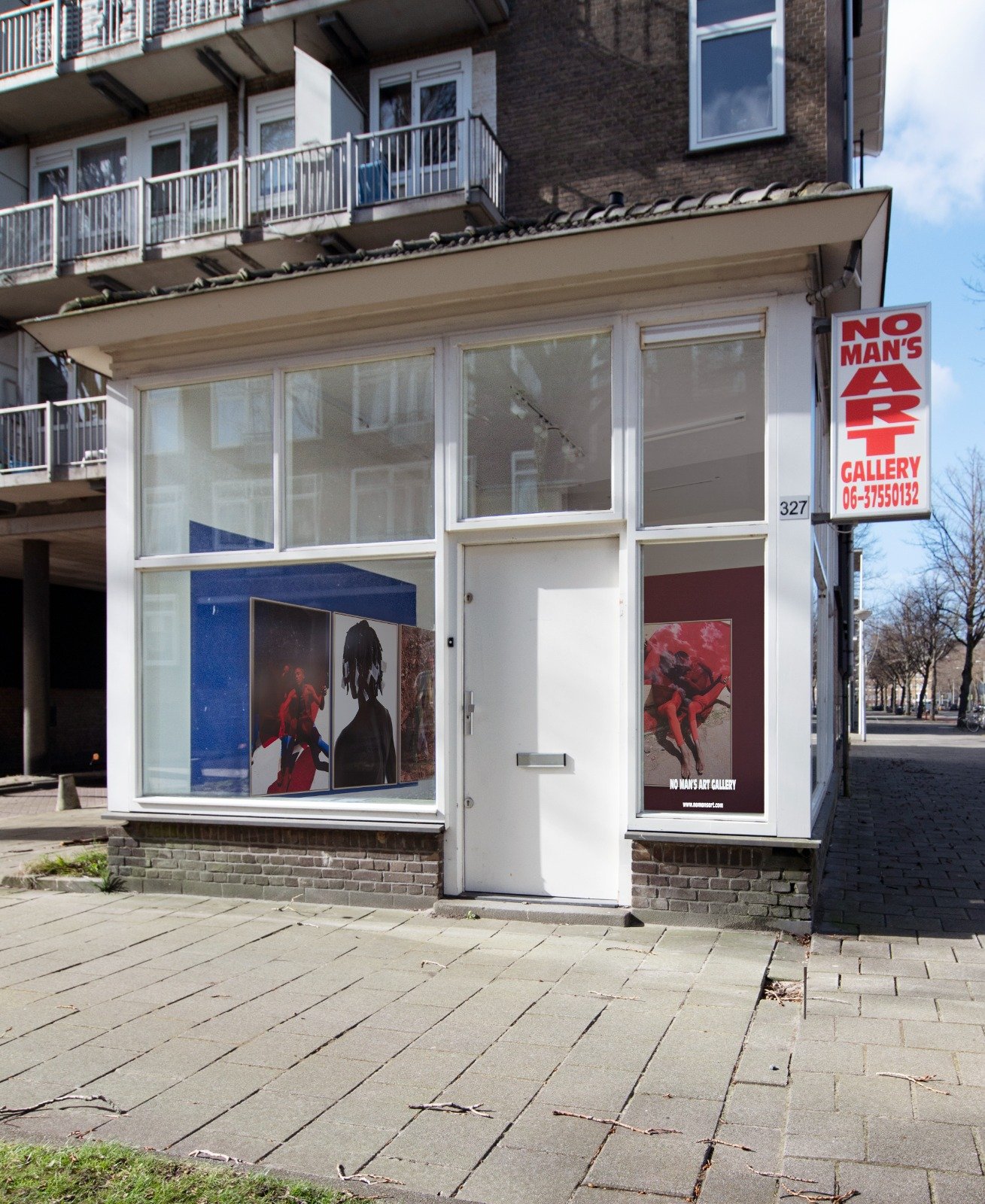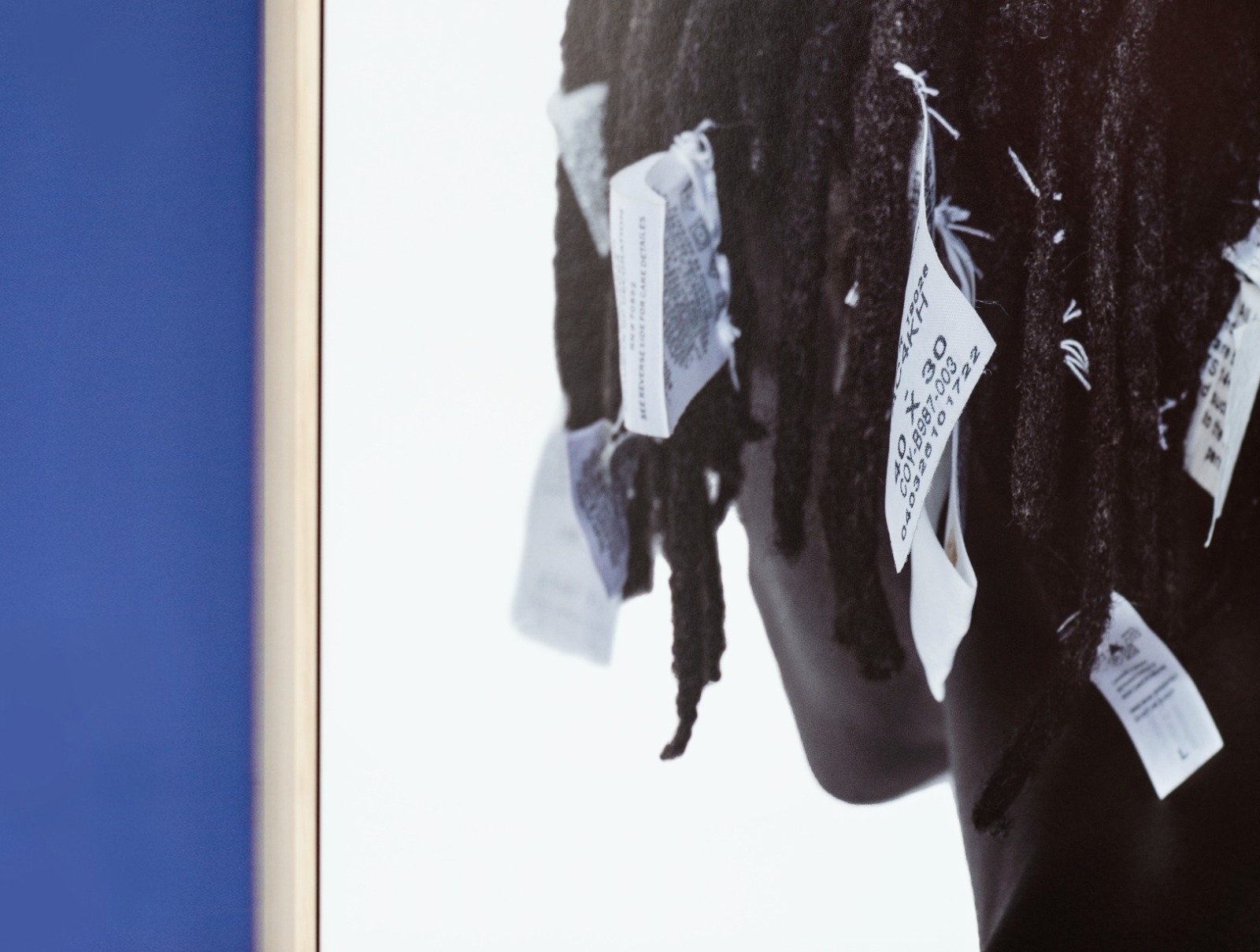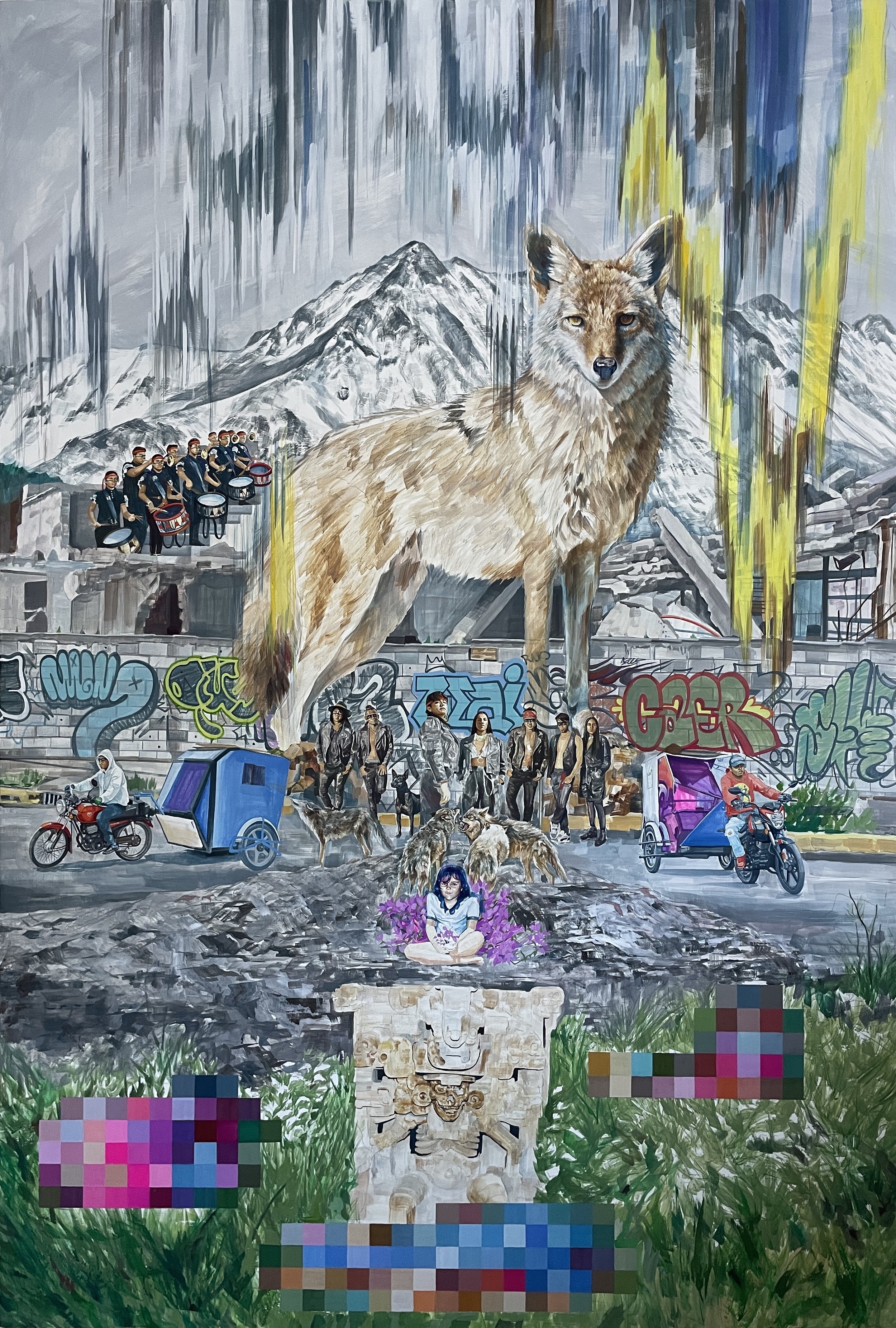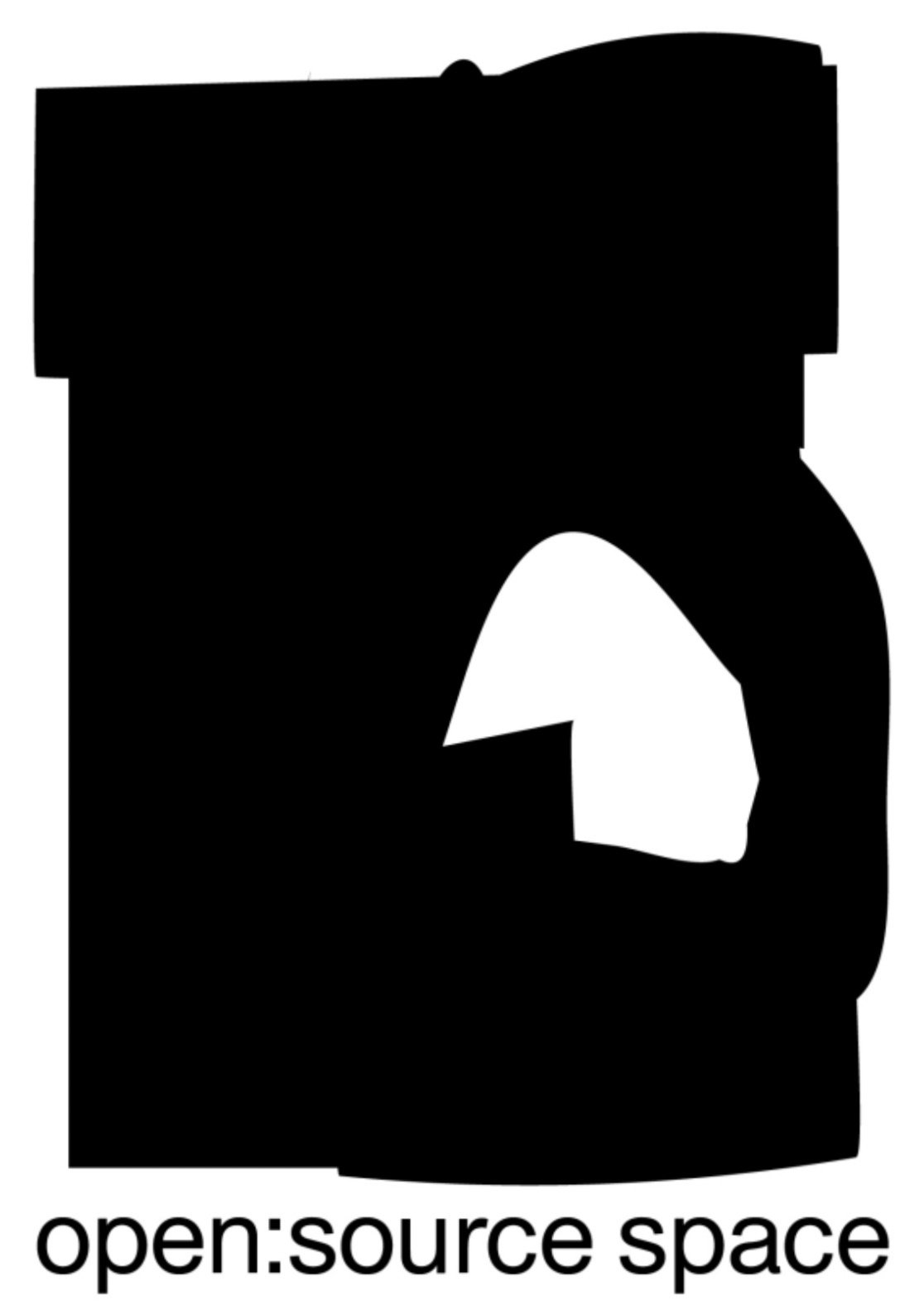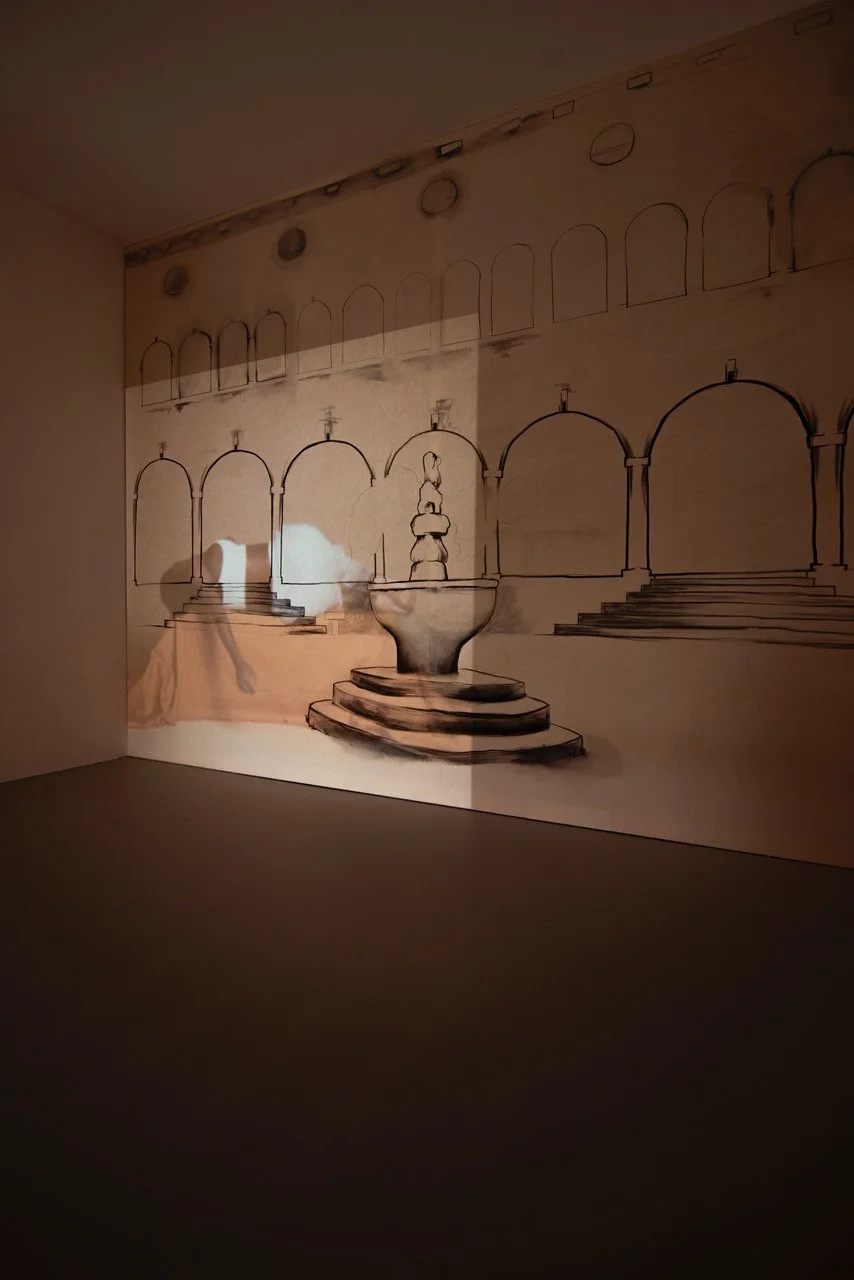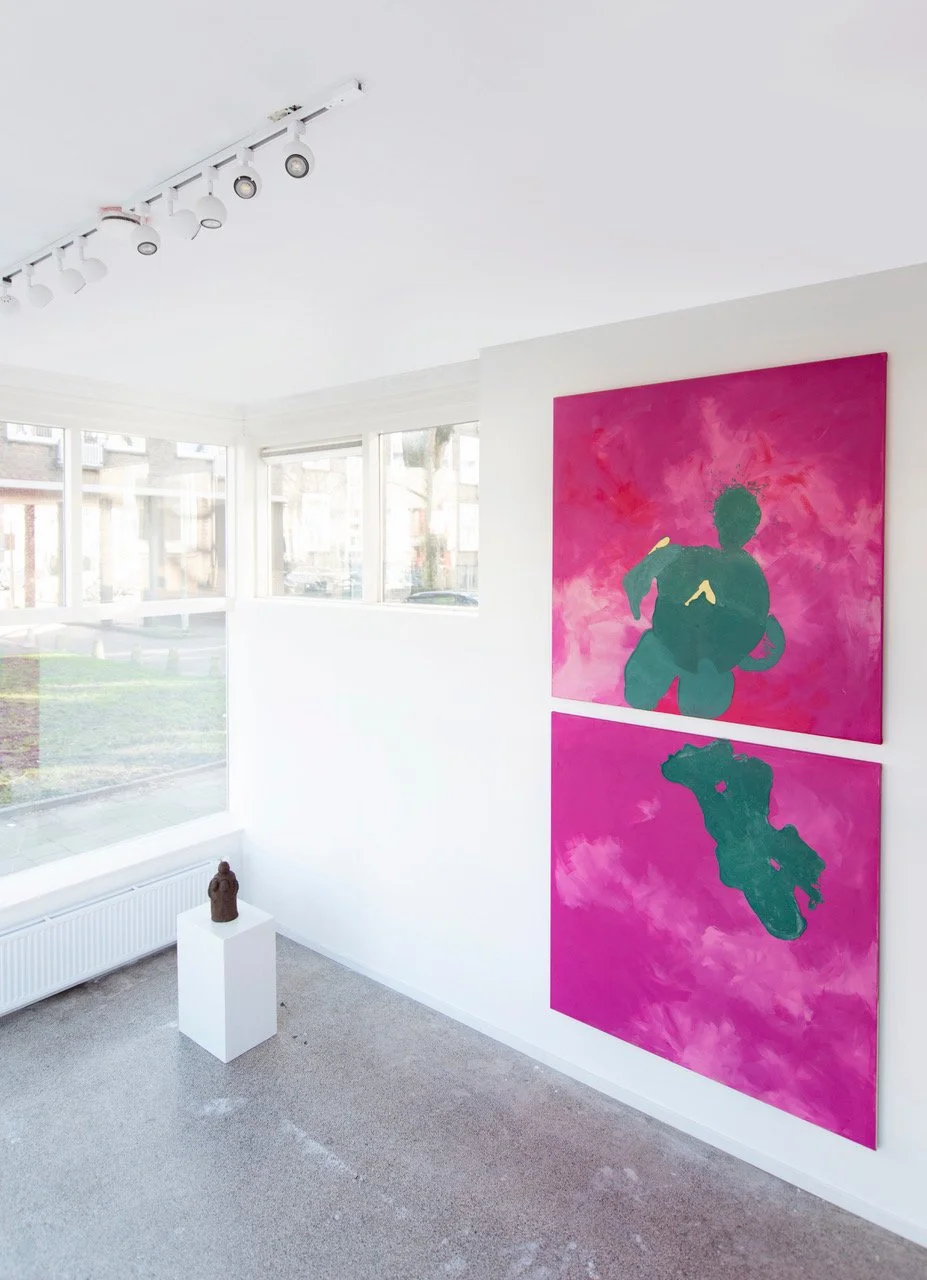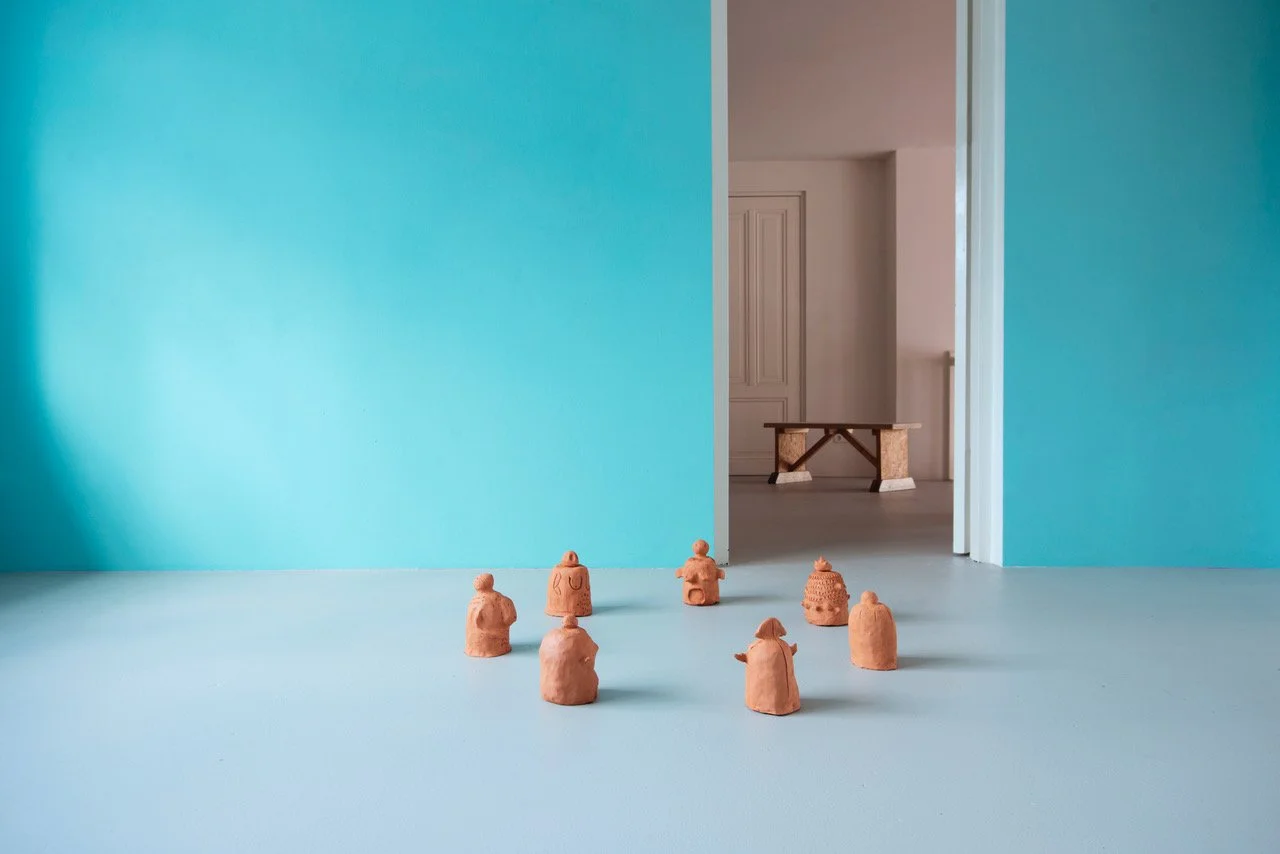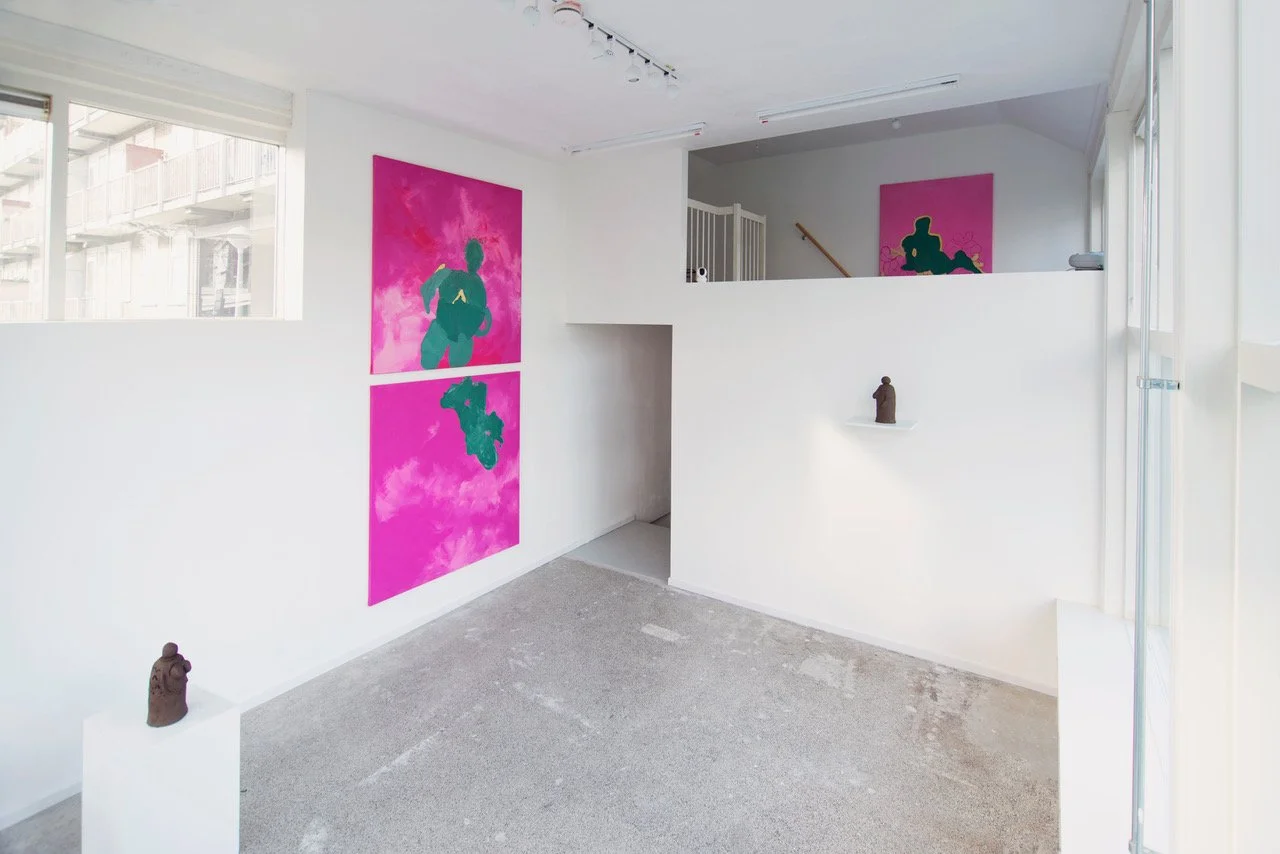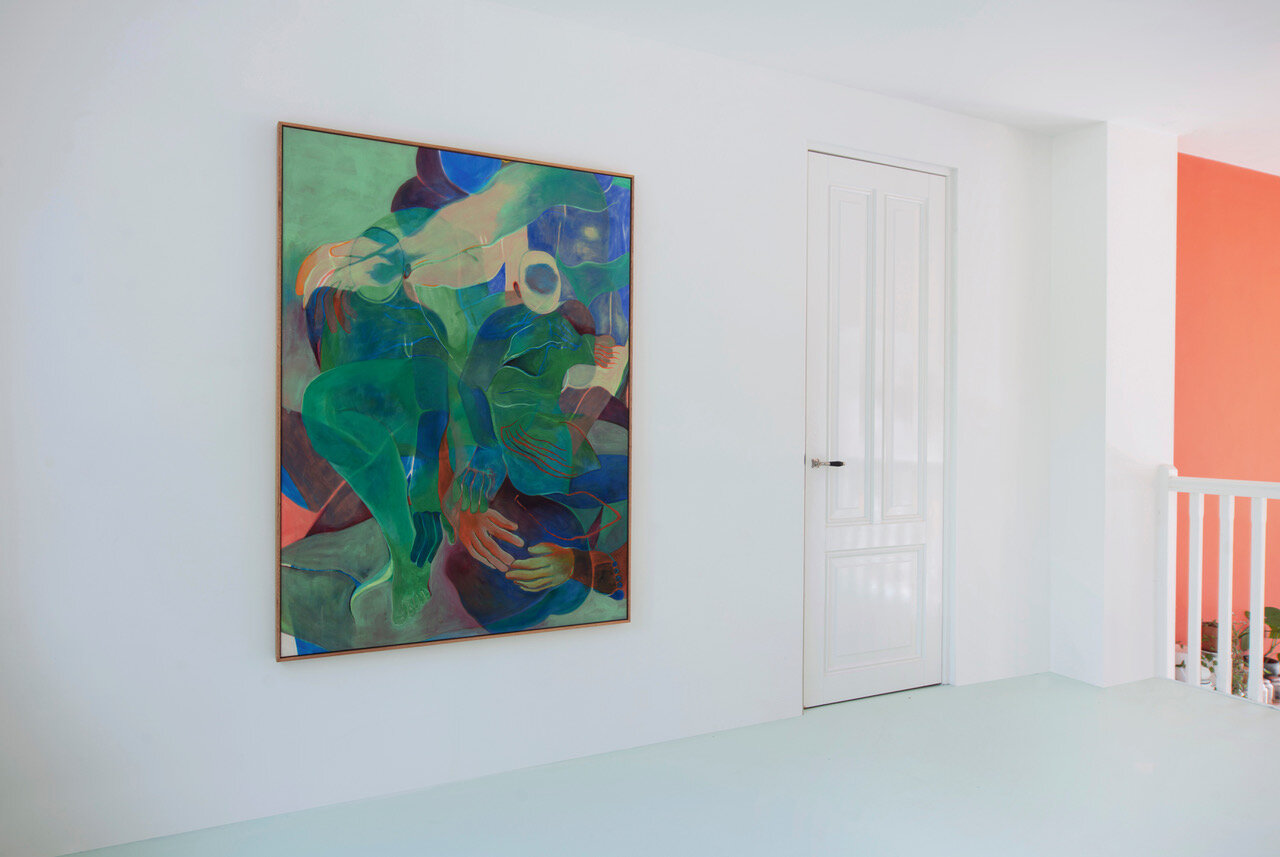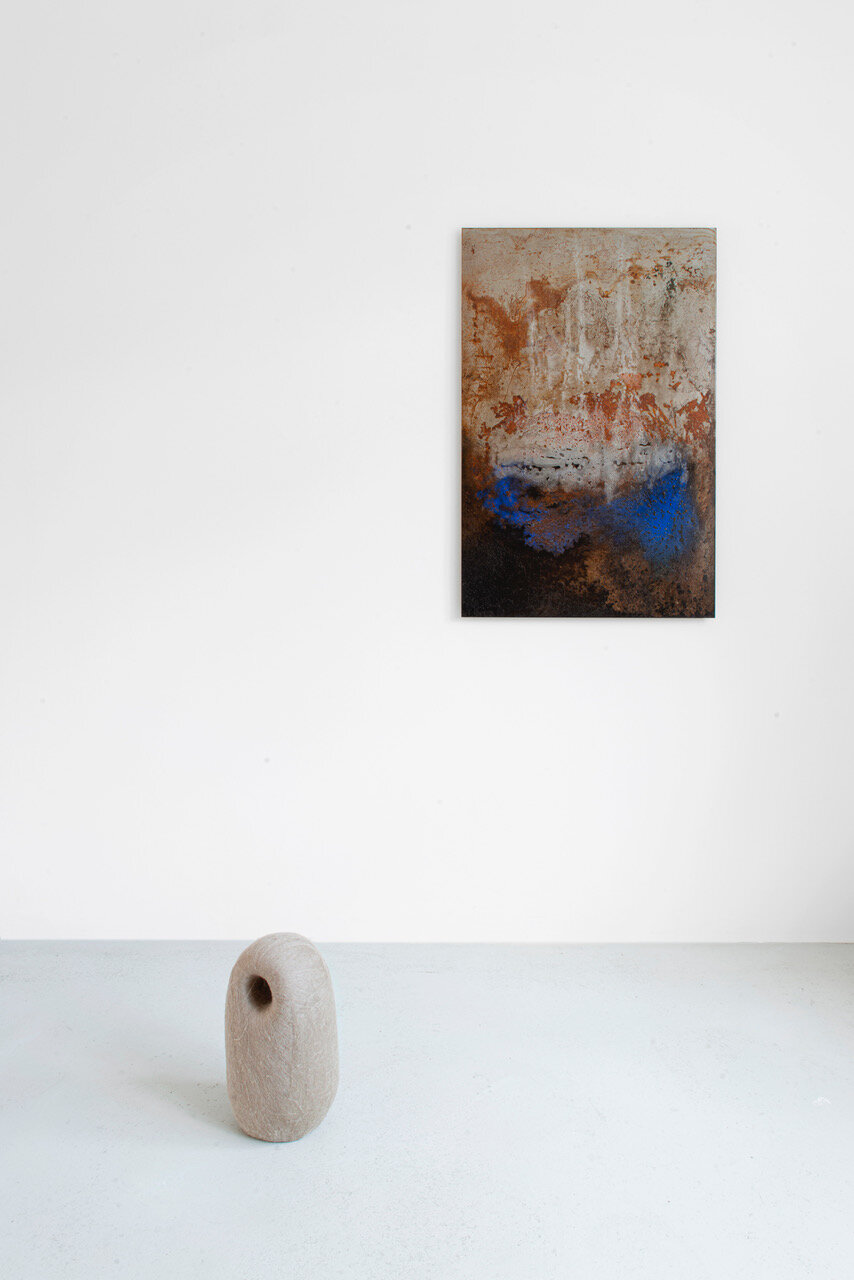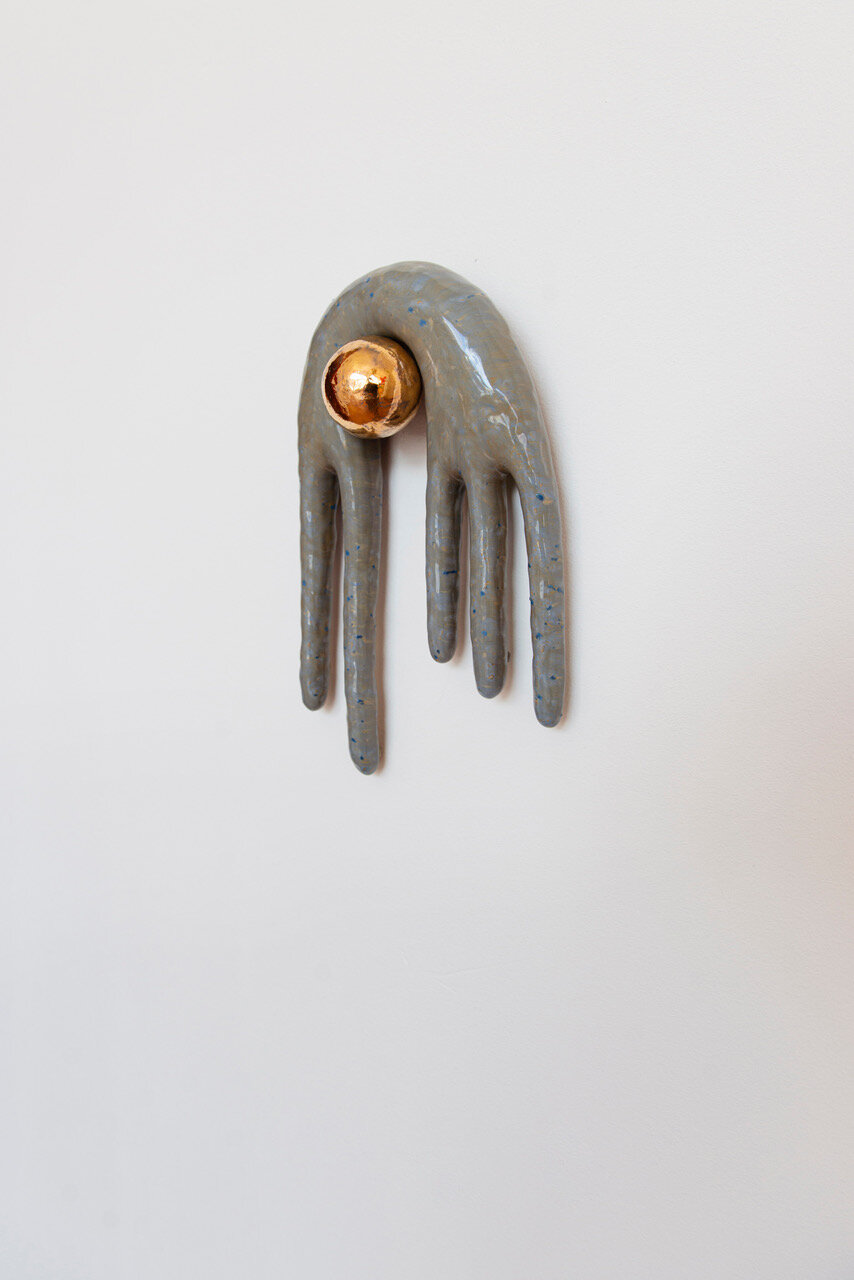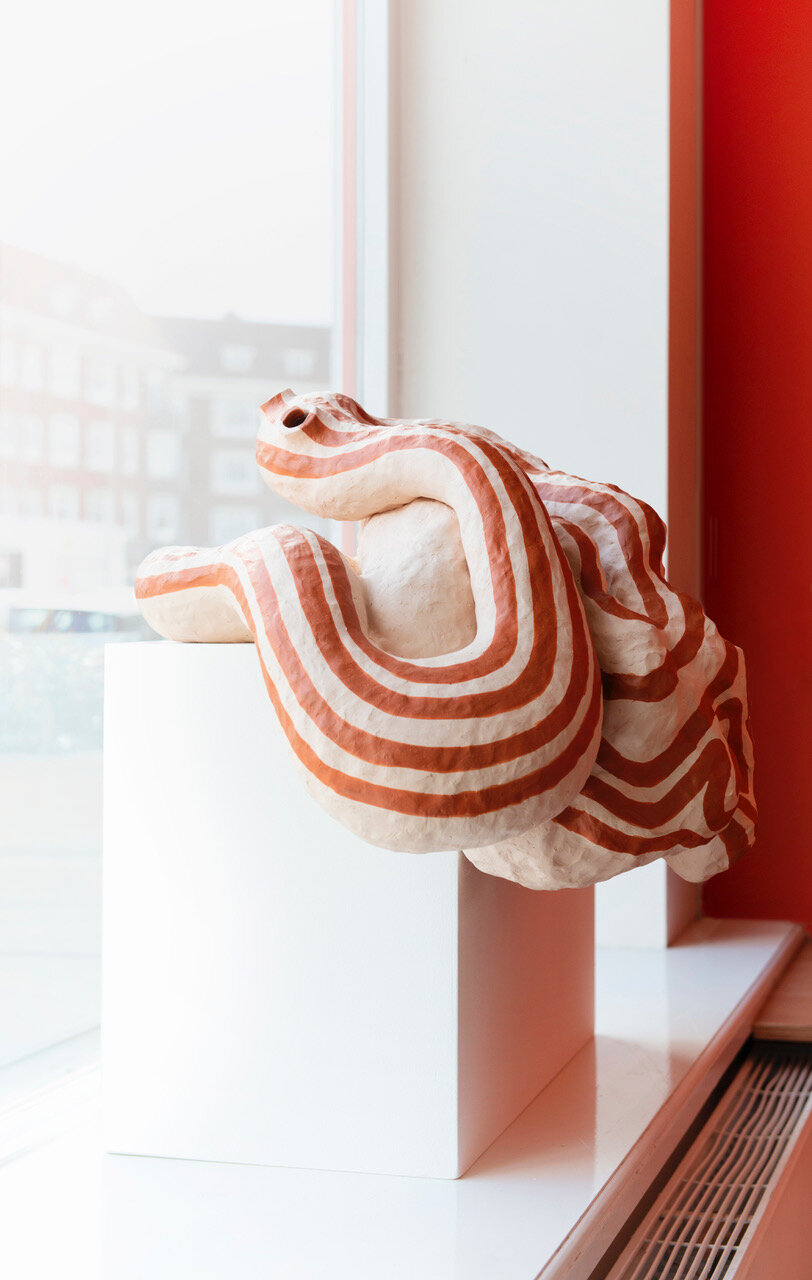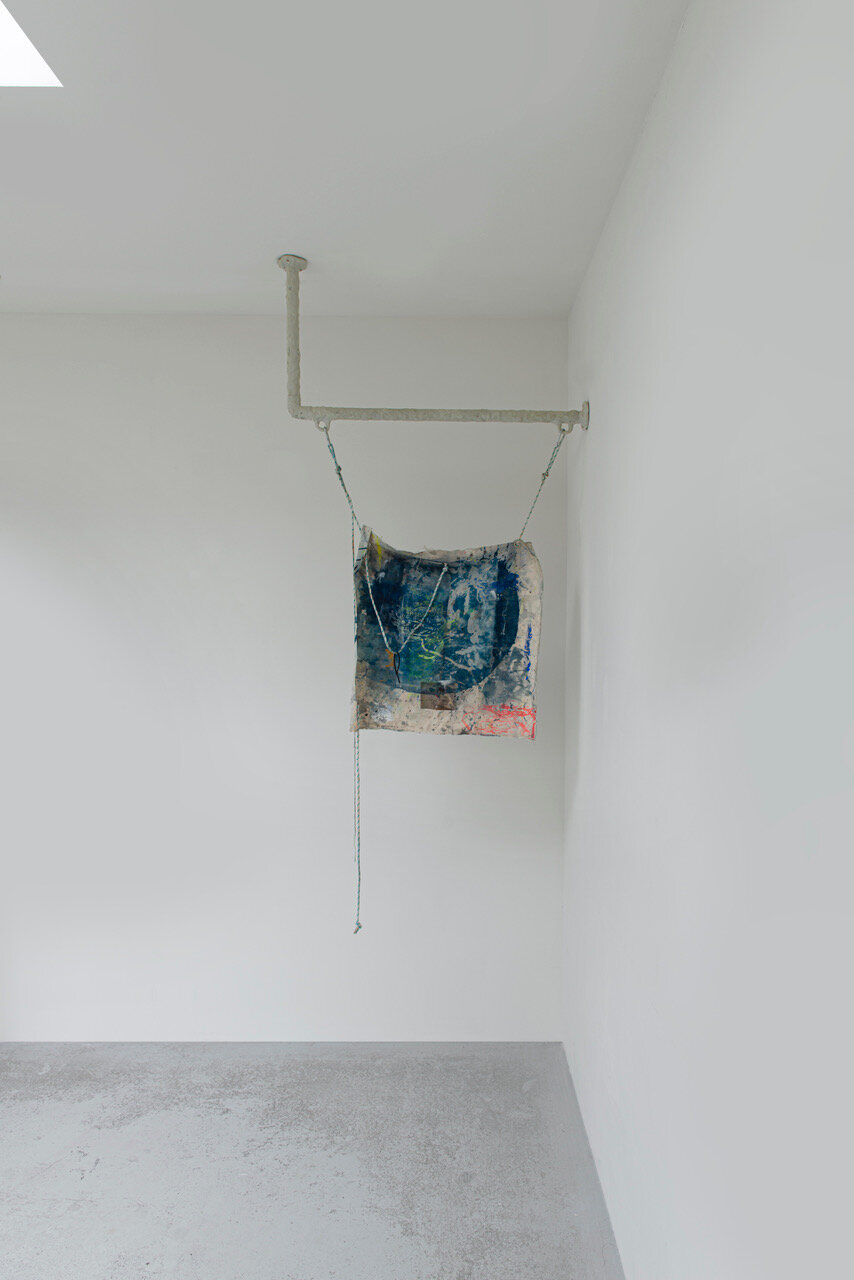A foot between the door | Benjamin Francis
online catalogue
Press:
A correction of the norm, in Art Rotterdam article, March 2025
22.03.2025 - 20.04.2025
Opening Saturday March 22nd from 5 - 8 pm
For his debut solo exhibition with the gallery, Benjamin Francis sought to create a space filled with windows, fences, and thresholds that function as both portals to another realm and barriers that exclude. They are more than mere architectural forms; they embody the contradictions of boundaries, shaping access while simultaneously denying it.
A Foot Between the Door is an act of staking a claim. Literally translated from a Dutch saying, it is used to assert presence in spaces that exclude, whether through physical barriers or institutional structures. It stands for the negotiation required to inhabit and navigate spaces where identity is regulated, challenged or contested.
A work that pauses the visitor upon entering the exhibition space is The Smell of Boundaries (2025), a large-scale installation that explores the visceral, almost instinctual response one has to dirt and cleanliness. Dirt is something one is conditioned to be repulsed by, not necessarily through rational understanding, but through deep-seated social and biological instincts. Cleanliness is more than hygiene; it is a ritual that purifies a space, setting it apart from dirt and contamination. This distinction is not only physical but also symbolic.
In The Right to Opacity, the writer and poet Édouard Glissant rejects rigid borders, seeing them as fluid and liminal spaces of exchange. The Smell of Boundaries (2025) echoes this idea, where decay defies containment, seeping through divisions. Dirt, sweat, and rot reveal a hidden truth: borders are not just seen or felt but inhaled and carried within us.
Francis plays with transparency and opacity and befouls his works with greasy fingerprints, petroleum jelly, mold-like overgrowth, dead branches and fish eyes; materials that clash with the sterile, hyper-regulated confinements that hold them. They expose the tension between organic chaos and imposed order and act as metaphors for bodies existing outside the norm, resisting erasure in certain settings.
Incorporating these ideas, the exhibition does not seek to collapse borders but to animate them, making supposedly neutral objects more alive. What happens when that which should remain outside begins to infiltrate windows, walls, and doorways? A Foot Between the Door challenges the audience to confront these borderlands: between inside and outside, purity and contamination, life and decay. Francis transforms the space into a site of tension and negotiation, and invites us to rethink the politics of exclusion and belonging.
Benjamin Francis (b. 1996, SR&NL) graduated from the Fine Arts programme at ArtEZ BEAR, University of the Arts with Base for Experiment, Art, and Research, in Arnhem in 2020. As a multidisciplinary artist, Francis combines installative object-based work with experimental and participatory performances. Within his practice, he reflects on his lived experience of being corrected for spelling mistakes, due to dyslexia. These dissonances or errors are carefully corrected in our current-day society, as anything outside the norm is deemed unproductive and therefore excluded.
Both in his performances and object-based works, the audience is placed in unexpected situations, thus becoming a part of the artwork. Through this interactive process, Francis aims to challenge the dichotomy between ‘right’ and ‘wrong,’ and undermine dominant systems of knowledge. As a result, he seeks to expose the hidden dynamics of power structures. Key questions within his practice consider what such systems are rooted in and who is in the position to dictate them. As such, the recurring themes in Francis’ work include dirt, cleanliness, pedagogy, discipline, authority, and power relations.
Francis often starts from ‘the other’ — (marginalized) bodies that are more heavily subjected to the normative workings of society. He draws from his own experience of being constantly corrected which created a tense relationship with authority figures, such as teachers. The tension between the normative society and his position as a queer person of color is an underlying tendency that intensifies this experience. The ‘cleaning up’ of mistakes, decay, and the dissection of something (both physically and verbally) is — in Francis’ view — what art is fundamentally about.
Since graduating from ArtEZ BEAR, Benjamin has shown at No Man’s Art Gallery, NL; Christine König Galerie, AU; Art Antwerp, BE; Luther Museum, NL; PuntWG, NL; Ballroom Project #6, BE; Hotel Maria Kapel, NL; If I Can’t Dance, Kunsthuis Syb, Het HEM, P/////AKT, NL; W139, NL; MÉLANGE, DE; Rencontres internationales, DE; SECONDroom, BE; and Mutter, NL, amongst others.
Photos Neeltje de Vries
Art Rotterdam 2025
ART ROTTERDAM
Solo/Duo Section
Booth D10
27 - 30 March 2025
We are thrilled to present a duo presentation by Benjamin Francis and Tobias Thaens on the solo/duo section of Art Rotterdam 2025.
Envelope, 2024, Tobias Thaens, Oil on linen, 20 x 35 cm

Zona Maco, Mexico City 2025
Online Catalogue
Zona Maco 2025
Booth EJ22
5 - 9 February 2025
We are thrilled to debut at Zona Maco 2025 in Mexico City, showing a duo presentation by Alan Hernández and Tobias Thaens on the emerging EJES section.
NMAG’s participation at Art Antwerp is supported by Mondriaan Fonds.
Escorpión (el que pica con la cola), 2025, Alan Hernández, Fabric, metal, hair, light, delcron, sponge, 150 x 190 x 90 cm
Orquídeas, 2025, Alan Hernández, Fabric, glass beads and pearls, wire, epoxy resin, cold porcelain, delcron, 110 x 63 x 114 cm
Sound of a Seam, 2024, Tobias Thaens, Oil and acrylic on canvas, 180 x 140 cm
Photos by Natanael Guzmán
Untitled Art Fair Miami Beach 2024
online catalogue
Untitled Art Fair
Booth A22
4 - 8 December 2024
Alan Hernández
Sam Samiee
NMAG’s participation at Untitled Miami Beach is supported by Mondriaan Fonds.
Polilla, 2022, Alan Hernández, mixed media, 110 x 90 x 40 cm
Gay Prometheus Unchained Erects Monuments for a World that Will Never Be, 2024, Sam Samiee, Acrylic on canvas, 150 x 205 cm | | 59 x 80 3/4 inches
Photos by Gabriele Abruzze

Dedicated To Becoming
NETA asher goshen | UNA CICAREVIC | Nara Kim | Abel Ruben | florian sigl | Sofie thijs
28.11 - 12.01 2025
Opening
Thursday November 28th from 5 - 8 pm
Location: NMAG, Bos en Lommerweg, 88, Amsterdam
Nara Kim, Hesitating I, 2024, Oil on Canvas, 90 x 110 cm | Photo credit: Jordi de Vetten
jiuba art space presents Dedicated To Becoming, featuring 6 artists from the Gerrit Rietveld Academie. The structure of the exhibition follows a model in which all participants vote for each participant assigning them with a fellow participant as the subject of a dedicated work. Exploring themes of democracy and dedication, each artwork functions as both a personal dedication and a reflection on the broader subject matter of these themes.
jiuba art space is an is an offshoot of No Man’s Art Gallery, providing a space for spontaneous, joyful and experimental programming on an informal basis with young and emerging artists. As a mostly online space, jiuba will function as an accessible art marketplace that will have occasional physical expressions such as this show.
Overview Dedicated To Becoming. Photos Jordi de Vetten
A scallop has two hundred eyes; twelve paintings on what they might see | Tobias Thaens
ONLINE CATALOGUE
14.09.2024 - 27.10.2024
Opening Saturday September 14th from 5 - 8 pm
Gallery Season Afterparty 8pm - late
No Man’s Art Gallery is honoured to present A scallop has two hundred eyes; twelve paintings on what they might see, the first solo exhibition by Dutch painter Tobias Thaens with the gallery. Affirming the continuous interconnectedness of the natural and the artistic, Thaens builds androgynous worlds, wherein organic matter becomes interwoven in the threads of sensitivity and vulnerability.
As butterflies drink the tears of crocodiles, turtles, and birds, the observer is invited to an intimate meeting between two different entities - nature and culture, biology and poetry - all trying to make sense of the reality surrounding them. In a macrocosm and on canvas, through his painting practice, Thaens instils a shade of romance in the vastness of the everyday.
Drawing inspiration from Canadian poet Anne Carson, Thaens aligns himself with the author in an attempt to “entertain a question, without conclusion but not without interest,” to break free from the code that instrumentalises how we describe and perceive the world. While Carson’s practice lies in the realm of language, for Thaens, it is in imagery. Upholding the idea of broadening a space for poetry and for art, whereby one is able to make connections beforehand invisible, is the thread that pulls Thaens to Carson’s writing and allows him to perform a transfer of an in-between space – the space betwixt blossoming and decaying – from page onto canvas, from a word to a brushstroke, from a memory to a landscape.
Thaens finishes his paintings without ever finishing them; he constructs them amidst juxtapositions and parallels, worlds and entities, and leaves them to breathe, to continue their cycle of existence right then and there. They allude to a multiplicity of meanings and beings. This fluid world of the in-between, is an invitation to an indwelling dialogue between the artist and that which is being painted; oftentimes enveloping nonhuman creatures, such as arthropods, crustaceans, and fungi, encouraging conversations between dissimilar others.
Whether a friend’s bag or the colour of their hair, the details embedded in his mental archive open up the doors to the artist’s exploration of viscerality, ephemerality, and intimacy, in an attempt to broaden, extend, and stretch. For Thaens, this necessitates a process whereby he imagines the nonhuman others perceiving, experiencing, and remaining just as he perceives, experiences, and remains. In Whisper (Lieveling), he paints a scene upon which he imagines how a bat would see with echolocation. By and of itself, the abstract nature of Thaens’ paintings requires the viewer to look for points of departure, or rather – the entities of departure, so as to grasp fibres of familiarity and existence with the work. Red strokes flowing through a friend’s hair inch close towards vesicles travelling in the intercellular fluid, while the texture of their bag edges onto an enchanting exoskeleton. And yet, if the work does not contain the initial object anymore, what does it become?
As a landscape of eyes touching eyes and layers peeking at layers, A scallop has two hundred eyes; twelve paintings on what they might see can be read through the imagery of skin. Shimmering, translucent, reflecting light just as scales, singing in rubato, peeling layers of comfort, injecting a meeting of others, demanding an inquisitive gaze.
Text by Zuzia Szatkowska
A scallop has two hundred eyes; twelve paintings on what they might see extends to both gallery locations: Willem de Zwijgerlaan 327 and Bos en Lommerweg 88 and runs until October 27th 2024. For more information or inquiries contact info@nomansart.com
Photos by Neeltje de Vries
Tobias Thaens (Eindhoven, NL, 1999) is a painter who graduated with a Bachelor of Fine Arts at the AKI Academy for Art & Design, Enschede, the Netherlands, in 2021 and completed his residency at De Ateliers, Amsterdam, in 2023. Thaens’ paintings offer the artist’s reflections on the hard contrasts between form and function, which dissolve into one another uninterrupted, revealing the fluidity of existence and the interconnectedness of distinct energies.
Through a deep fascination with animals utilising camouflage, the artist brings to light a shared visual language of organisms within an ecosystem, where colours and shapes follow each other and the agency they hold changes over time. An androgynous world where nature dynamically alters its skin pattern and colour, a series of perceptive and emotional depths lay ahead. This exploration bleeds out into the intimate experience, blurring the line between biology and poetics. Through this permeation, Thaens instils in the viewer a lasting curiosity for the discourse of perception and interpretation.
Since graduating from AKI, Thaens has participated in exhibitions at Ballroom Projects, BE, Woonhuis, NL, De Ateliers, NL, and Gerard Hofland (NL).
Tobias Thaens in his studio, 2024
Cutting Silk | Mia Chaplin
ONLINE CATALOGUE
25.07.2024 - 08.09.2024
Opening Thursday July 25th from 5 - 8 pm
No Man’s Art Gallery is honoured to present Cutting Silk, the third solo exhibition by South African painter Mia Chaplin with the gallery. Through expressive paintings and sculptures characterised by rich impasto surfaces and visible brushwork, Cutting Silk celebrates resilience, metamorphosis, and the ability to find beauty in brokenness.
One of many myths in Ovid’s Metamorphoses tells the story of the goddess Diana, who enjoyed her sanctuary in the heart of a secluded forest—a space she fiercely protected. One day, the young hunter Actaeon accidentally stumbled upon her bathing with her nymphs. Diana, upset by the intrusion, turns Actaeon into a deer, stripping him of his human identity and ability to defend himself. His own hunting dogs, failing to recognise their master, chased and killed him.
Chaplin references this myth through "Losing, Finding, Losing Again" (2024), the first painting encountered upon entering the main gallery. This contemporary rendition of Titian's Diana and Actaeon shows oil-painted bodies that disintegrate and blend into their surroundings. The intruder's body is left out of the frame, as if the artist makes the viewer complicit, while the bodies of the bathers themselves become fluid and concealed, hiding by morphing into each other.
The act of breaking down something, to form something new, lays the foundation for Cutting Silk, drawing parallels with the adaptive camouflage of insects and animals that safeguard themselves through transformation. Chaplin’s bodies evolve into landscapes and landscapes engulf bodies. “Much like the giant leaf-tailed gecko blending with its branch or the silkworm cocooning itself during transformation, these works illustrate how vulnerability can find safety through the act of becoming something new.” (Mia Chaplin).
The eponymous large sculptural painting, suspended from the ceiling and almost dripping with paint residue, alludes to a fisherman’s net freshly pulled from the sea, with its remnants clinging to it. Moving around the piece, one grapples with one’s own role in relation to it. Am I the one caught in the net, or am I the predator? Chaplin plays with the tension between these roles throughout the show. She seduces us with scenes of intimacy, fragility and of apparent captivity on the brink of a shift.
Simultaneously, the net and wired works are reminiscent of a veil, an object often used in art history to symbolise a divide between public and private sphere, evoking mystery and concealment as well as the unknown. It denotes transition as a passage between different states of consciousness. The veil, as a symbol for psychological layers, can convey hidden aspects of emotions and experiences, much like a fishing net thrown deep gathering both catch and bycatch.
Cutting Silk highlights feminine identities that, amidst the ongoing patriarchal need to conquer and control, remain eternally fluid and elusive - ephemeral and challenging to possess - as their forms lack clear beginnings and endings, borders and boundaries. It illuminates the resilience of those who are vulnerable, emphasising how beauty and strength can emerge from brokenness and the continuous process of becoming.
Cutting Silk extends to both gallery locations: Willem de Zwijgerlaan 327 and Bos en Lommerweg 88 and runs until September 1st 2024. For more information or inquiries contact info@nomansart.com
Photos by Neeltje de Vries
Mia Chaplin (b. 1990, SA) is a painter and sculptor who lives and works in Cape Town. Working in oil on canvas and paper as well as in bronze and plaster sculpture, her highly expressive works are characterised by their rich impasto surfaces and visible brushwork. Her loose, style of painting is intuitive, heightening the emotion of her pieces. Chaplin’s works are her impressions of the female experience in relation to sexuality, sensuality, intimacy and violence.
Since completing her BFA at the Michaelis School of Fine Art in Cape Town in 2011, Chaplin has presented various solo exhibitions including Twister (2021) and Underbelly (2019), with No Man’s Art Gallery in Amsterdam as well as Swamp (2022), Mouth (2018), Under a Boiling River (2017), and Binding Forms (2016), with WHATIFTHEWORLD Gallery in Cape Town. She has exhibited her work with NMAG on various pop-up locations such as Iran (2016) and Mexico (2022). She has also extended her painting practice into printmaking, hosting a mini-exhibition of monotypes from the series, The Making of a Sharp Blade (2017), in collaboration with Warren Editions, Cape Town.
Chaplin has completed artist residency programmes at PM/AM Artist residency, London (2023), Cité Internationale Des Artes in the Marais district, Paris (2018), Nirox Arts Foundation in Johannesburg, South Africa (2016) and at OBRAS Foundation in Alentejo, Portugal (2015). Her work has been placed in numerous international private and public collections such as Spiers Arts Trust (SA), Akzo Nobel Art Foundation (NL) and LAM Museum, (NL).
Mia Chaplin in her studio by Jonathan Cope.
dandelions milk | Afra Eisma
ONLINE CATALOGUE
Press:
In de open ateliers van de Rijksakademie voel je de turbulentie van de wereld, in NRC, May 2024
Paardenbloemen, in De Groene Amsterdammer, June 2024
Beeldrijm, in Het Parool, July 2024
30.05.2024 - 21.07.2024
Opening Thursday May 30th from 5 - 8 pm
(afterparty at Bos en Lommerweg 88 until late)
Chances are it’s morning, looking out to smell that yellow sun; bright before, orange after. This ear, this early — that ant crawling on your shoulder. Their arms warm to hold me, perhaps there is a life here. “Oh dandelions milk, will you carry my thoughts and dreams?” Wide awake, she told me: “all ear all ear had you heard me that first time.” Do not be afraid of your own heart jumping. The tendrils crawled back to the house, so you forgot to mention what she told you. I whispered back: “i-loooove-you too”.
No Man's Art Gallery is honoured to present dandelions milk, the debut solo exhibition by Afra Eisma with the gallery. In the echoing worlds of two gallery spaces, where lips speak, drips fall, and ants scurry alongside otherworldly beings, Afra Eisma brings magical worlds to life, where emotion serves as a source of strength and trauma acts as a catalyst for self empowerment and change. The vibrant and colourful nature of Eisma's installations is a strategy to address sensitive issues and illuminate the darker sides of personal experiences.
dandelions milk is part of Amsterdam Art Week and extends to both gallery locations: Willem de Zwijgerlaan 327 and Bos en Lommerweg 88 and runs until July 21st 2024. For more information or inquiries contact info@nomansart.com
Photography by Neeltje de Vries and Gert Jan Van Rooij
Afra Eisma (b. 1993, NL) lives and works in Den Haag, the Netherlands. She studied Fine Arts at the Royal Academy of Arts, the Hague, and Central Saint Martins, London. Using craft techniques in novel ways, the artist explores and manifests personal stories through immersive and intimate installations of textiles, sculptures, and ceramics. Recently, Afra Eisma has been dedicated to creating immersive installations that actively involve the viewer, turning the sanctuary into an extension of the body. Generosity becomes a form of resistance.
Recent and upcoming solo exhibitions include: Hop to Hope, Wälnö Aaltosen Museo, Turku, FN (2023); Splashdown Tetley, The Tetley, Leeds, UK (2023); Your silence will not protect you, Fries Museum, Leeuwarden, NL (2021); Feline Whispers, 1646, Den Haag, NL (2020); Rooms of now #3, Vleeshal, Middelburg, NL (2019). Recent group exhibitions include: Outside the soup, W139, Amsterdam, (2024); Very small feelings, Kiran Nadar Museum of Art, New Delhi, IN (2023); Multiplied Voices, CIAJG, Guimaraes, Portugal (2022), De Scheffer Prijs, Dordrechts Museum, Dordrecht, Netherlands (2022); 84 steps, Kunstinstituut Melly, Rotterdam, Netherlands (2021); Utsuro Bune, garden lab, Kyoto, Japan (2020); The sticky beaver show, Parallel Vienna, Vienna, Austria (2019); Royal Award for Modern Painting exhibition at the Royal Palace, Amsterdam, NL (2018). Eisma’s work is included in private and public collections, which include: Kiran Nadar Museum, New Dehli, IN; Textielmuseum, Tilburg, NL, De Vleeshal, Middelburg, NL; AkzoNobel Art Foundation, Amsterdam, NL; Fries Museum, Friesland, NL.
Afra Eisma in her studio by Katerina Heil.
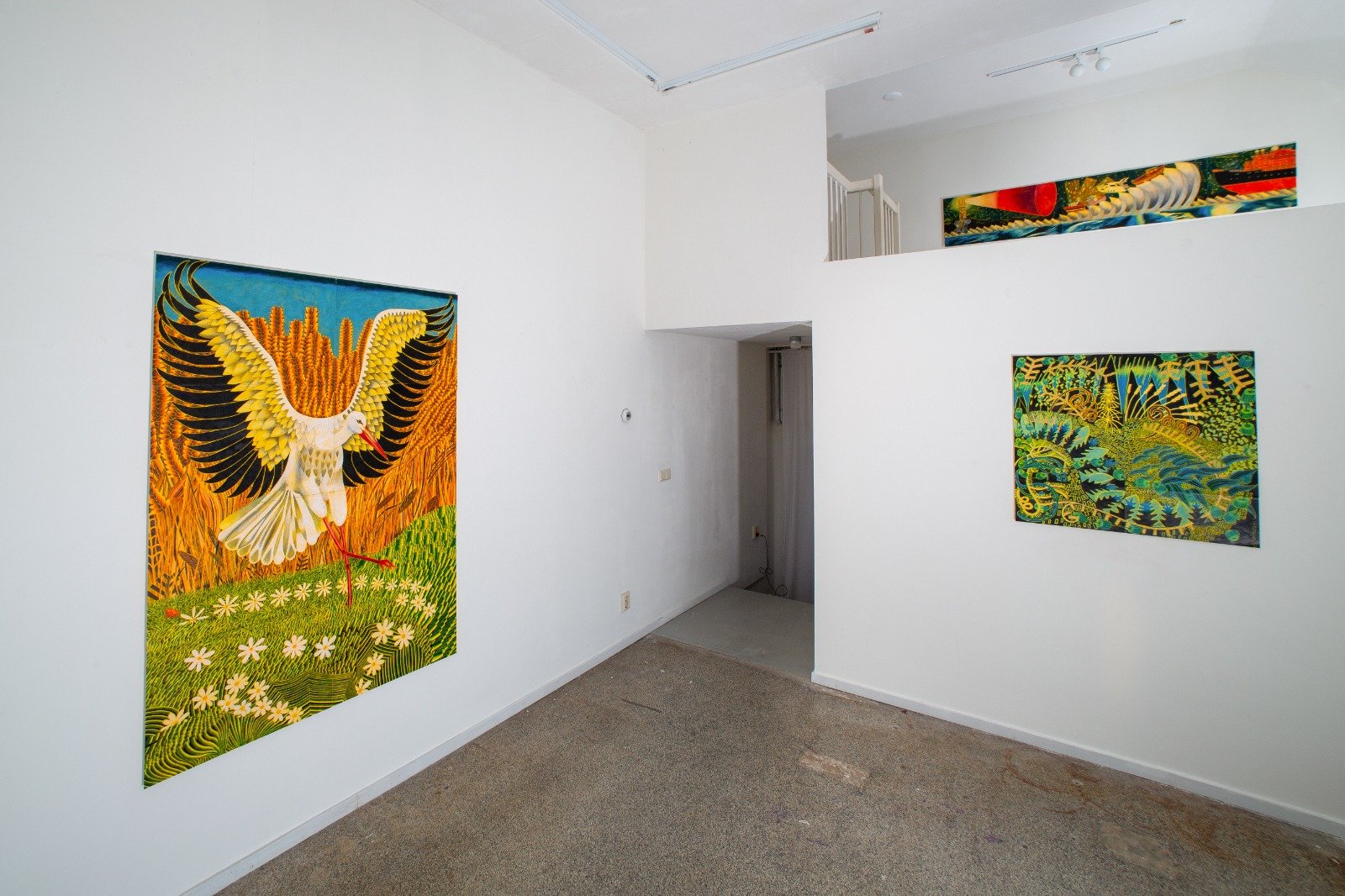
ANTSONG | Maxim Santalov
online catalogue
28.03 - 05.05 2024
Opening
Thursday March 28th from 5 - 8 pm
No Man’s Art Gallery is honoured to present ANTSONG, Maxim Santalov’s third solo exhibition with the gallery. Extending to both gallery spaces, ANTSONG shows the artist’s large body of intricately composed geometrical drawings that form a narrative of a rhythmic trail, moving through the planetary mesocosms of Santalov’s worlds. He reconstructs childlike reveries of the past, searching for their elements and atmospheres in the future.
“My work is my own insectarium, filled with vanishing species and unidentifiable creatures,” Santalov poses. Through his signature technique, he highlights the juxtaposition of the modern and the rural, the adult and the childlike, the harsh and the soft - while creating a need for motion, for a search and a pathway, amongst wandering insects, the dripping waters, falling stars and the explosive fires.
Prickling past the surface of his cultural memory, Santalov builds pheromonal bridges ‒ just as those blossomed by his ant-characters ‒ to connect various themes emerging within the landscape of Russian art history to his unique integration of realism and surrealism. Touching the array of values and principles embedded in movements such as Constructivism and Suprematism, as well as his own Ävangraphics. Santalov masters the rigidity of minimal shapes and their carved-out dimensionality along with a contrasting intensity and vibrancy of his colour palette. In his self-taught practice, the artist moves across from concealment directly into mapping, marking, and reeking storytelling. “At first glance, it may seem as if my drawings are devoid of air, but look more closely. The work is marked with scratches and ripples which impose shape and texture. Space binds together the elements of composition,” Santalov explains.
As symbols of symbiotic relationships, the techniques used by the artist are left within their own capsules of existence, communicating with each other and the viewer as the trails left behind. The yellow acrylic under the layers of wax crayon and pencil markings remain visible, tying the echoing niches of Santalov’s drawing environment to his methodology. As such, the artist simultaneously enchants with an arthropodic cosmos and leaves space for narratives of our own fabrication, memory, and emotion.
The exhibition extends to both gallery locations: Willem de Zwijgerlaan 327 and Bos en Lommerweg 88 and runs until May 5th 2024. For more information or inquiries please contact info@nomansart.com
Photos Tommy Smits
Heat Wave | Marilyn Sonneveld
No Man’s Art Gallery is honoured to open Heat Wave, the third solo exhibition by Marilyn Sonneveld at the gallery. Through a vivid interplay of color and form, Sonneveld’s oil paintings and glass objects express intimate narratives that communicate universal notions around the body, touching upon (self)acceptance, vulnerability and sexuality. Last summer, the artist began painting with glass, focusing on herself and her own body for the first time. When the Sun Comes Up, a large scale glass installation exhibited at the Kunsthal in Rotterdam, showed the transformative journey of Sonneveld’s own physicality in anticipation of impending motherhood. For Heat Wave, the artist takes it a step further and delves deeper inwards, revealing a shift towards abstraction.

suckle and squeeze | Curated by Afra Eisma
online catalogue
Nadie BorGgreve | Julia Dahee hong | Afra Eisma
Alejandra LÓpez Martínez | Marnix van Uum
22.11 - 23.12 2023
Opening
Wednesday November 22nd from 4 - 6 pm
Location: NMAG Kiosk, Willem de Zwijgerlaan, 327, Amsterdam
In the midst of winter’s solace, and the need for i-love-you’s, No Man’s Art Gallery presents the group exhibition suckle and squeeze. This friendship, this friendly-ship, that vessel in which I camouflage. Their arms warm to hold me, boundaries bound anew as my body is boarded. I’m melted into a confusing mixture; home. Outside it’s no different, in a circle – our arms one. ‘Do not remove your lovely leopard spots’, she said. We squeezed milk in each other's mouth as they came out.
Photos by Neeltje de Vries
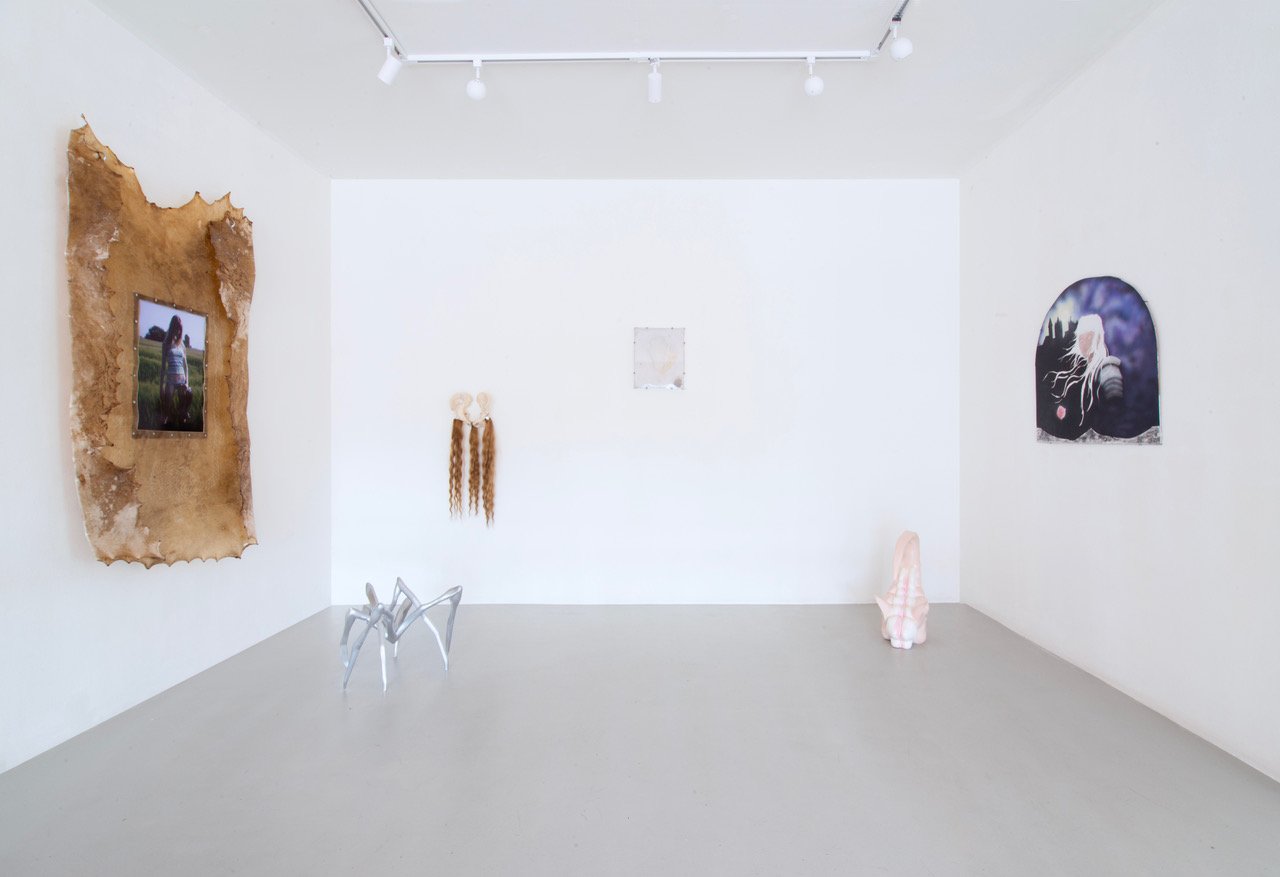
The Wormhole Echoes | Curated by Megan Irusta Cornet
online catalogue
Anna Vosse Carpaij | Lotus Rosalina Hebbing
Matei Dragomir | Obbe van der Weide
Toran Macrae Wolstencroft
22.11 - 23.12 2023
Opening
Wednesday November 22nd from 4 - 6 pm
Location: NMAG, Bos en Lommerweg, 88, Amsterdam
jiuba art space presents Wormhole Echoes. In Roman mythology, Janus, the god with two heads, embodies the dual nature of holding conflicting ideas. A symbol of beginnings and endings, doorways, openings and time; the plurality of openings highlighting the freedom of choice. Wormhole Echoes is an exploration beyond the confines of our chosen perspectives, echoing duality and it inspires us to seek a deeper understanding of the universe and our place within it.
jiuba art space is an is an offshoot of No Man’s Art Gallery, providing a space for spontaneous, joyful and experimental programming on an informal basis with young and emerging artists. As a mostly online space, jiuba will function as an accessible art marketplace that will have occasional physical expressions such as this show.
Photos by Neeltje de Vries
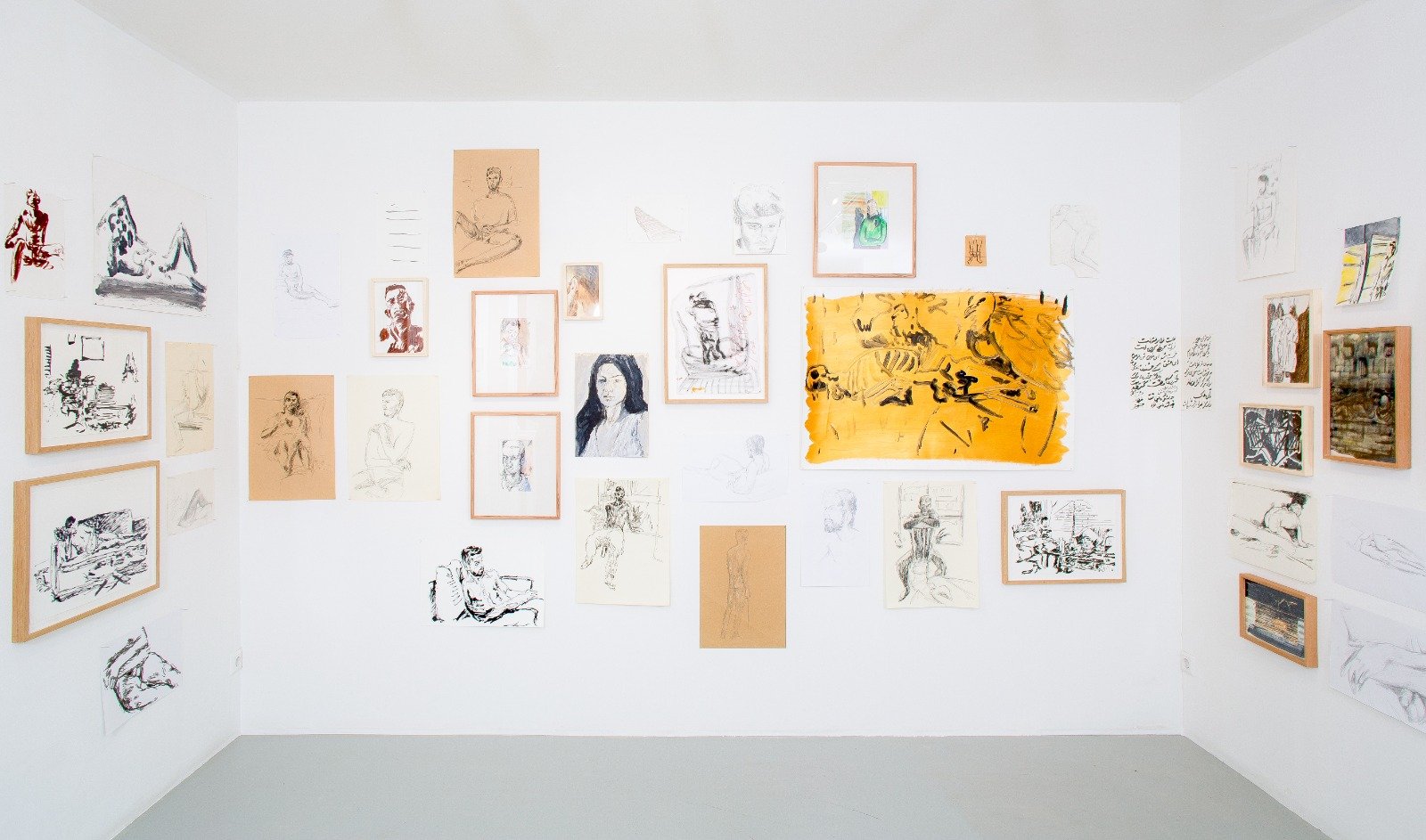
When Hell Breaks Loose I’ll Tell You Your Legs Were Always On My Mind | Sam Samiee
Listen back to the artist talk with artist Sam Samiee and director/curator Lih-Lan Wong
NMAG Storage Sessions I
08.09 - 29.10. 2023
No Man’s Art Gallery proudly presents When Hell Breaks Loose I’ll Tell You Your Legs Were Always On My Mind the first solo exhibition by Sam Samiee at the gallery. Across his multifaceted career as a painter, essayist and psychoanalyst in-training, this exhibition specifically highlights the artist’s sixteen-year engagement in drawing, emphasising the prioritisation of queer aesthetics throughout vulnerabilities and crises.
The rooms of No Man’s Art Gallery show over two-hundred rarely exhibited drawings - spanning from 2008 - 2023 - that are thematically divided into landscape and flora, imaginative scenes, figuration and still life. The title of the exhibition alludes to an overarching theme throughout the artist's artistic and research-based endeavours: voicing a poetic eroticism or playfulness in the light of crises.
Samiee refers to his practice as post-cinematic. Central to his practice are installations embedded within the architecture of the exhibition space. The way they are edited relate to the process of playing with semantics. An example of this is seen in relation to his models, friends and conversants, revealing a deep connection of shared moments and dialogue that influenced sensual, political and relational elements guided by the artist's long involvement in psychoanalytic settings and thinking.
While Samiee separates and engages independently with drawing as a rationalist enterprise of measuring and recording the real world, his other endeavour, poetry and deconstruction of language, intertwines as subject matter of the drawings. Drawing and visual arts are put to work to materialise notions, concepts and abstract constellations that have seemingly lost their touch with materiality. Finding life-driven forces within situations that are deadening; finding a playfulness at the moment of drawing still life, machines and objects of everyday life; envisioning familiar and unfamiliar landscapes of mountains and lowlands, and collecting thoughts and ideas for a future view. Through the unique installation of the drawing archive, new connections appear between nodal points of the works.
His drawings breathe life into verses from poetry, figures from world mythology, and his own lines, avoiding mere literary illustration. An abstract scene of a lover's embrace is interlaced with a written fragment of Mohammad Reza Sharjarian's "A Lover's Plight," a Persian song calling on lovers to pour their hearts into their cups like tulips blushing. Samiee's recurring exploration of the connection between a verse of poetry and drawing or painting such as in his use of the promethean motif, leads to fresh interpretations and interconnectedness among these semantic points.
Amid over two hundred drawings we find scenes of mourning, death, the crucifixion and Iran-Iraq war tragedies yet always with the presence of the sanctuary that is beauty. The drawings invite access to the subtext of Samiee’s oeuvre, as amongst the chaos it is the beautiful thighs, chests, the Mountains Zagros Ranges and the blossoming orchid branch that offer solace.
Seen from a chronological point of view, and if compared with the exhibiting trajectory of the artist, one is able to observe how Samiee challenges literary hegemony within his culture and others by infusing architecture, physicality, color, and line into a playful discourse. His work exposes and puts on trial ideologies that regulate bodies, allowing both himself and viewers to confront the material reality of his subjects. In his more recent drawings, an embrace of the decorative and the poetic become increasingly visible.
When Hell Breaks Loose I'll Tell You Your Legs Were Always On My Mind reveals a decade of the backstage of the artist practice, research, obsessions, tests and notes which hold together a wide range of emotions, fantasies, and ideas that Samiee has relied on or will return to in the future of his ongoing explorations.
The opening is followed by NMAG’s 5 Year Anniversary Party from 9pm onwards. Join the celebration at Bos & Lommerweg 88 with cocktails and music late into the night.
Public Programme:
Artist Talk | Sam Samiee in conversation with Lih-Lan Wong
When: Thursday October 26th 2023
Time: 6pm - 8pm
Location: NMAG & de bar, Bos en Lommerweg 88-90, Amsterdam
Painter, essayist and psychoanalyst in training Sam Samiee will give an artist talk in conversation with director and curator Lih-Lan Wong.
RSVP to Artist Talk (free admission)
Photos: Tommy Smits
Sam Samiee in his solo booth on Art Rotterdam 2023, by Lucas Marcus Schilder
Sam Samiee (b. 1988, IR) is a painter, essayist and psychoanalyst in training based in Amsterdam, Berlin and Tehran. He is a winner of the Royal Award for Painting in 2016 and Wolvecamp Prize in 2018 and finished the Rijksakademie residency in 2015 and ArtEZ University of Arts and Design in 2013, where he was a lecturer of painting until 2020. Samiee synthesises his heavy research on art history, Persian poetry and psychoanalytic theories into a studio practice that employs painting in multiple registers. The characteristic of his installations as extended paintings is the break from the tradition of flat painting and a return to the original question of how artists can represent the three-dimensional world in the space of painting as a metaphor for a set of ideas. He employs a range of painterly attitudes from oil paintings to iPad paintings, figuration, abstraction, the break of the rectangular frame and usage of text among other methods. Recently Samiee’s work focuses on a period of painting that parted ways from avant-garde, with the emphasis on decorative modes of work, of artists such as Matisse and Bonnard.
Graphic Design: Peter van den Hoogen (Coup)

jiuba art space presents: Atari | Summer Show
Online Catalogue
Anico mostert | Anna van der Ploeg | Cihad Caner | Donglai Meng | Esther van der Heijden & Nosh neneh | kelvin Dijk | Merijn KaVelaars | Safira Taylor | Sam Samiee | Sisse Holst Pedersen | Tommy Smits
Atari
A group exhibition by jiuba art space, hosted at No Man’s Art Gallery
Curated by Sophie Huijbregts
21 July - 27 August 2023
No Man’s Art Gallery is proud to present Atari, a group exhibition that brings together 12 artists whose work inhabits a state of atari: a moment suspended in time, in which the next move must be made. Atari invites us to visit a series of crossroads, touching on topics of interconnectedness and competition, precarity and growth.
In the ancient game of Go, the concept of atari refers to a situation in which a stone is left with only one remaining liberty, or one empty intersection adjacent to the stone. It occurs when a stone’s liberties are reduced to one, caused by the position of the opponent’s stones - meaning the player is faced with the imminent loss of their stone and territory. Therefore, their next move directly and consciously impacts the further path of the game. They can make several strategic decisions, such as defence, counterattack and sacrifice. By recognising atari and responding appropriately, players can either secure their stones' safety or capitalise on their opponent's position to gain an advantage in the game.
Being in a state of atari requires us to hold the weight of all possible paths forward in a single moment: it is a state of contemplation. This is beautifully illustrated in works such as those by Anico Mostert and Donglai Meng. They are meditations, showing us hope and fear and highlighting the multifaceted nature of the human response to risk. At the same time risk can be seen as a catalyst for change, as we can recognise in the works by Sisse Holst Pedersen and Esther van der Heijden. They fuse resilience with fragility, communicating on interconnectedness and growth.
Atari entails the imminent loss or potential gain of territory. This tension evokes a sense of vulnerability, speaking to the role of physical space in the construction of identity and ideas of belonging. In Studies in Cartography, Sam Samiee investigates the power structures at play in the seemingly neutral practice of mapping, drawing attention to the violence underlying this act of capture through imagemaking. It works to render places and peoples legible, defining sets of hierarchies and relationships through which authority can be exerted. If mapping defines territory to impose structures of power, the transgression of those boundaries can be seen as a threat to that same power. Cihad Caner delves further into the construction of the “other” in relation to processes of migration, illustrating how movement through territory puts pressure on ideas of the self. He focuses on water as a driving ecological and political force, as well as a space of flux and uncertainty. Flows of people give rise to anxieties around belonging, their mobility eroding false notions of permanence and stability.
As the moment in which a path must be chosen, atari is also a state of suspension and uncertainty. Kelvin Dijk’s work grapples with the interplay between migration and identity on a personal level, addressing internal feelings of displacement. Through the exploration of (visual) culture and lore, he attempts to connect different localities and create new modes of cultural belonging. A similar act of anchoring oneself in the face of uncertainty can be found in Anna van der Ploeg’s abstractions of Cape Town’s “missing” posters. They are highly localised communications, as an anonymous author sends out a cry for help to those sharing an urban landscape. These strategies can be seen as acts of tracing, of rendering visible networks and connections across space and time. Similarly, Tommy Smits’ works are a testimony to one of many possible paths taken. They embody a series of uncertainties, a chain reaction of decisions made by chance, memorialising each one as fossils in stone.
If the situation at hand is dealt with strategically, atari represents the possibility for gain or growth. Living Monuments of the Deep, a collaborative project between Esther van der Heijden and Nosh Neneh, makes a case for applying such contemplation and awareness to our relationship with the natural world. The works seek to embody the vulnerability of endangered oceanic species, and invite us to cherish the vast interconnectedness of the world we inhabit. In a similar vein, Safira Taylor combines personal histories with fluid interpretations of the vulnerability, growth and interdependence which characterise many organic processes. This cyclical nature can be recognised in Merijn Kavelaar’s 4Flux, which revisits canvasses from past creative processes to fuel new artistic growth.
Atari marks the launch of jiuba art space, a new (online) space for experimentation and play. jiuba is an offshoot of No Man’s Art Gallery, providing a space for spontaneous, joyful and experimental programming on an informal basis with young and emerging artists. As a mostly online space, jiuba will function as an accessible art marketplace that will have occasional physical expressions such as this show.
Atari will be on show from July 22nd until August 27th. The exhibition extends across both gallery locations: No Man’s Art Gallery KIOSK (Willem de Zwijgerlaan 327), open Wednesday through Saturday, 12 - 5pm. No Man’s Art Gallery & de bar (Bos en Lommerweg 88): open daily, 12 - 5pm.
Programme:
Guided tour with curator Sophie Huijbregts and artists
Location: No Man’s Art Gallery KIOSK, Willem de Zwijgerlaan 327
When: Thursday, August 24th
Time: 6 - 10 PM
Photos: Peter Tijhuis
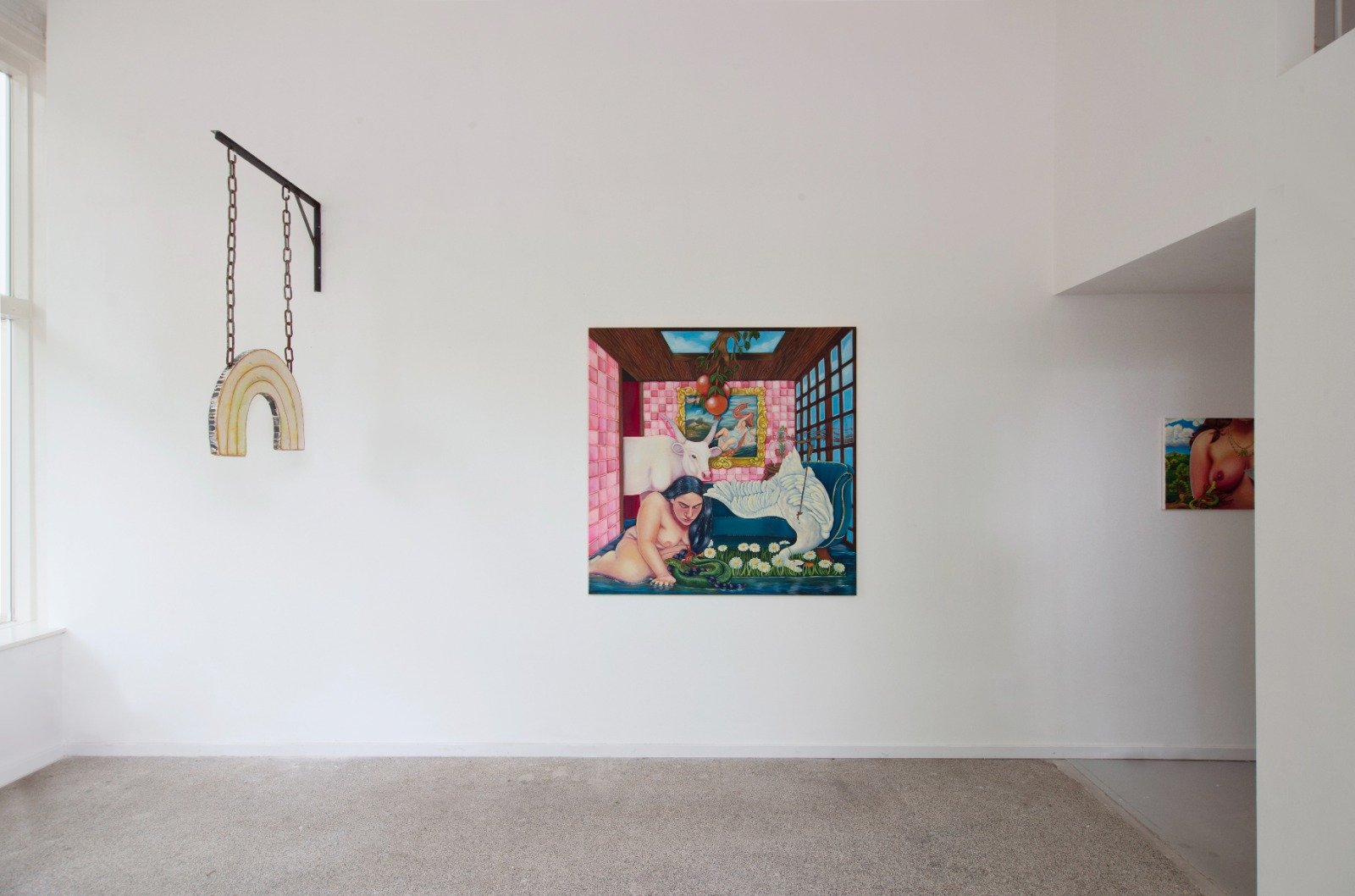
Las estrellas me iluminan al revés | Group Show
Online Catalogue
José Eduardo Barajas | Wendy Cabrera Rubio | Alejandro Galván | Alan Hernández | Alejandra España | Chavis Mármol |
Carlos Martínez González | Ileana Moreno |
RojoNegro (Noé Martínez Flores & María Sosa) |
Rodrigo Red Sandoval | María Sosa | María Vez
Las estrellas me iluminan al revés
June 2 - July 15 2023
Opening Friday June 2nd 4 - 7 PM at both gallery locations
No Man’s Art Gallery is honoured to participate in Amsterdam Art Week with the exhibition “Las estrellas me iluminan al revés”, featuring a diverse collection of works by emerging Mexican artists. The group show is an extension of the gallery’s tenth international pop-up gallery in Mexico City and opens June 2nd at both gallery locations in Amsterdam.
“Las estrellas me iluminan al revés,” includes works by José Eduardo Barajas, Wendy Cabrera Rubio, Alejandro Galván, Alan Hernández, Alejandra España, Chavis Mármol, Carlos Martínez González, Ileana Moreno, RojoNegro (Noé Martínez Flores & María Sosa), Rodrigo Red Sandoval, María Sosa and María Vez.
“Las estrellas me iluminan al revés” invites twelve artists to explore the inevitability of spirituality as a strategy to cope with the darker forces of life. Each work attempts to touch the realms of duality, magic or healing; relating to itself while at the same time being charged by external sources that are of more obscure nature.
The exhibition title, roughly translated as “the stars shine on me backwards,” takes its inspiration from the largest painting in the show by Alejandro Galván. The painting references the lyrics of Alfredo Guttiérez's "El Solitario," a renowned cumbia song portraying the unfortunate life of a desolate drunkard, to whom misfortune has become a constant companion. His melancholic existence is felt as if the stars have illuminated him in reverse. Having given up on life, the man preserves a sense of pride by attributing his misfortune to a reversed starlu.
All of the works in the exhibition carry a similar charge of an elusive dark energy, each time conjured by another force: ancestors, symbols, mythical gods, astronomy, rituals or witchcraft. They prolong the natural movement and oral histories of magic that tie the intricate Hispanic, Indigenous, and African cultures of Central America and beyond.
“Las estrellas me iluminan al revés” opens on June 2nd at 4pm and runs until 16 July 2023 on both gallery locations: Willem de Zwijgerlaan 327 and Bos & Lommerweg 88, Amsterdam.
Photos: Neeltje de Vries
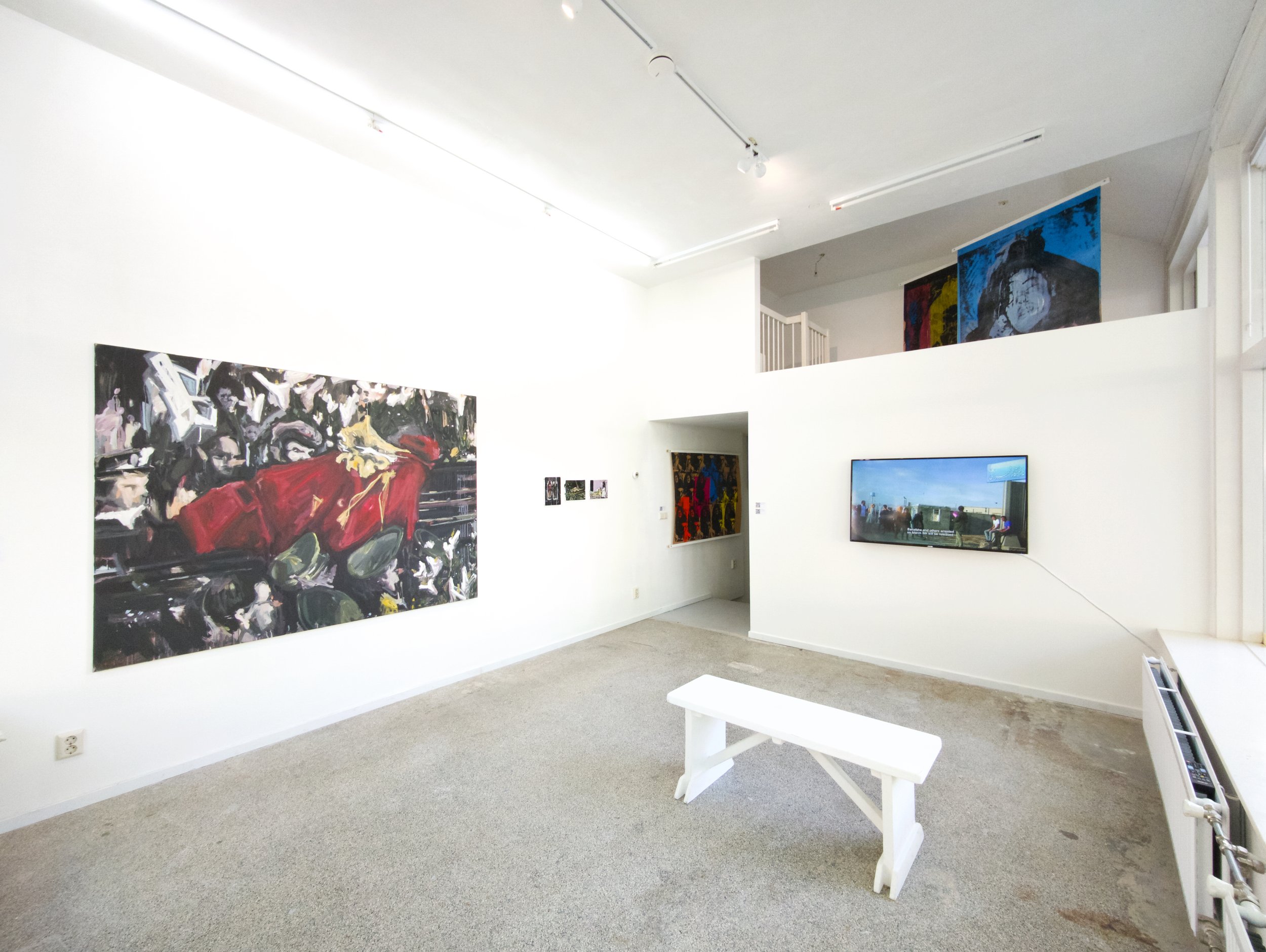
ONCE THERE WAS (N)ONE | Curated by Fereshte Moosavi
Online Catalogue
Khosrow Hassanzadeh
Mina Keshavarz
Sanaz Sohrabi
Ramtin Zad
ONCE THERE WAS (N)ONE
Opening Tuesday 25 April 2023 from 5 - 8PM
25 April - 16 May 2023
Curated by Fereshte Moosavi
Amid times of ongoing cruelty, normalized violence, and never-ending war, this exhibition presents a number of artworks that counter the historical forgetfulness caused by such conflicts. Each artwork creates a monumental presence for the erased, oppressed, or marginalized beings and things. This is realized by combining the power of factual narratives with fictional tales that are founded on actual documentations, family archives as well as imaginary situations. The artworks include painting, drawing, sculpture, print, video and documentary by Khosrow Hassanzadeh, Mina Keshavarz, Sanaz Sohrabi and Ramtin Zad.
The Art of Living in Danger (2020) is a documentary by Mina Keshavarz that revolves around a monologue that the artist has written to her grandmother, Nuri, who she’s never met. Pressured by the traditional marriage at a young age, Nuri commits suicide at the age of thirty-five when pregnant with her eighth child. Made on the fiftieth anniversary of Nuri’s death, this film is an act of remembrance and a homage to Keshavarz’s grandmother as one of the many women whose life is affected by domestic violence. In the meantime, by following a group of female lawyers and activists in their campaign for criminalisation of domestic violence, Keshavarz documents the ongoing fight for gender equality and for ending normalized violence in Iran. With a similar approach, Khosrow Hassanzadeh’s Faheshe (2001) is a series of silk screen prints portraying a number of women who were victims of a chain murders in the city of Mashahd, north east of Iran over twenty years ago. By employing police documentations to print large, colorful and repetitive portraits of these women, not only Hassanzadeh challenges the ‘distorted ideology behind the criminal’s fundamentalist motivation’, but also, he creates a monumental appearance for these women as an act of remembrance.
These works are set against the backdrop of politically charged historical references that set a reminder of the bitterness of dominant states’ powers. Ramtin Zad’s series of paintings and drawings titled Last Ceremony (2018-2022) brings together a more dramatic and expressive presentation of the momentum of death, intertwined with political and fictional figures. His short video Smile Parade (2018) is an anti-monumental work in which he paints a clown portrait over every single face of the North-Koren and Russian armies while marching at an unknown special event. In continuation of questioning the long-established moral principles, counter-monuments are a way to reflect on the monuments’ message or lack thereof to reread history. Sanaz Sohrabi’s video art The Glory, the Human, and the Mother; a Cartography (2017) sets out on a journey to different locations of the former soviet union to search for three monuments that were demolished, altered or repurposed. Moving between the archival materials and documentations from the sites of the statuses we hear the artist's narration about the events that surround these monuments.
Image: The Glory, the Human, and the Mother: a Cartography, 2017, (film still), Sanaz Sohrabi, Video with sound, 17:35 minutes

SPECTRUM | Jamal Nxedlana
Press:
- Weekendtips van Mitchell Esajas: SPECTRUM by Jamal Nxedlana, Het Parool, 2023
- Elle Decoration, Mexico, 2024
SPECTRUM
Opening Saturday March 11 / 5 - 8 PM
11 March - 16 April 2023
Artist Talk with Jamal Nxedlana
Thursday April 6th / 6 - 8 PM
RSVP (free admission)
No Man’s Art Gallery is honoured to present SPECTRUM, the second solo exhibition by Jamal Nxedlana at the gallery. The exhibition showcases a new series of images that continues his exploration of topics such as race, masculinity, post-colonialism and consumer culture, with a particular focus on the representation of the black body in fashion photography. Nxedlana is a visual artist and cultural organizer who is recognized for establishing initiatives and projects that support the South African arts community, including Bubblegum Club, a digital platform and culture agency that promotes innovative work and emerging cultural workers.
His first solo exhibition at No Man's Art Gallery, AVATAR, celebrated the creativity of Johannesburg's cultural scene, using their work and personal style as statements of mystery and beauty. Nxedlana created a mythology in which new gods and spirits emerge from a moment in the city’s history (2016-2019) where Nxedlana felt in sync with his contemporaries. While his subsequent global exhibitions garnered attention, the lens through which his work was viewed failed to recognize its multifaceted nature. SPECTRUM examines black portraiture and the artist's path towards abstraction of the black body, presenting a complex series of photographs that resists any singular perspective on black identity.
In SPECTRUM, Nxedlana continues to refine a visual language that incorporates and reflects on objects that are ubiquitous to his context, such as the monobloc chair. It functions as a symbol in itself, but it also appears in dialogue with the artist, recognising the chair as contextually problematic; its provenance suggestive of the unsustainable relationship between the African continent and the rest of the world. “A dumping ground” for cheap products, plastic, clothes; what the world doesn’t seem to want or need anymore. Simultaneously, the omnipresence of the chair has caused it to become part of the visual culture of the artist. The chair reflects the multiplicity of meanings and values encountered along the route of limitlessness and abstraction. A contraction that turns one object into a mindful discussion on identity and questions a tangible encapsulation of the Black experience. “The chair is a way to speak to multiplicity”.
Experimental manipulations with translucent perspex create a prism effect that further informs of the dimensionality and separational nature of the work.. The perspex reflects the shapes of the city of Johannesburg and further entangles the bodies that hold it up. The shape mimics some of the properties of the monobloc chair and enters a symbolic space that allows it to extract abstraction and expression from the deconstructed bodies and objects. The careful combination of these elements provides presented scenes with a wonderfully sharp sculptural quality. Overlapping, layered, and intangible, Nxedlana brings together different symbolic elements and plays with their potential in a way that results in an patchwork organism that can be at any point spotlighted and broken apart into limbs.
Location: NMAG KIOSK, Willem de Zwijgerlaan 327 and NMAG, Bos & Lommerweg 88 (this exhibition extends to both gallery locations)
Photos: Neeltje de Vries
Jamal Nxedlana (b. 1985, South Africa) is a visual artist and cultural organiser living and working in Johannesburg, South Africa. He is the founder of a number of independent organisations that support the South African arts community among which is Bubblegum Club, a digital platform and culture agency showcasing innovative new work and creating opportunities for emerging cultural workers. He is also a founding member of CUSS Group, a Johannesburg-based artist collective that has been exploring the hybrid culture of post-colonial South Africa over the past decade. As a solo artist, his practice addresses the portrayal of the black body in fashion photography while exploring themes of race, masculinity, post-colonialism and consumer culture.
Jamal Nxedlana has exhibited in galleries, institutions and independent spaces internationally. Most recently, his images were featured in the collective shows The New Black Vanguard curated by Antwaun Sargent and Orlando curated by Tilda Swinton.
Jamal Nxedlana by Senay Berhe

Lejano de todas partes | Alejandro Galván
online catalogue
Lejano de todas partes
Opening Saturday September 3rd / 6PM - late
4 September - 16 October 2022
No Man’s Art Gallery is honoured to present Lejano de Todas Partes (far from everywhere), the first solo exhibition by Alejandro Galván (1990, MX). Lejano de Todas Partes follows an intensive residency period of the artist in Amsterdam. The gallery invited Galván to join the residency programme after a series of studio visits in Mexico City earlier this year.
Alejandro Galván is a painter who lives and works in Nezahualcóyotl (Neza), one of the most populated and dense areas of Mexico City. Neza is part of the State of Mexico, an area that comprises several municipalities on the outskirts of the centre of Mexico's capital. It has a complex history of governmental neglect, violence and marginalisation and at the same time houses a proud community with a strong sense of togetherness, the warm home and heart of the working class. These dualities are visualised in the artist’s large scale paintings of watercolour, ink, gouache and charcoal on wooden panels. Rich pictorial scenes reference cityscapes that include pre-hispanic culture and Mexican mythology combined with Catholic imagery, manga inspired figures together with medieval bestiaries and newspaper coverage of disturbing scenes next to intimate portraits of the artist’s family, female figures important to him and his neighbours.
Each painting is honoured with a Quinametzin, an Aztec titan that appears as a beast or figure and symbolises a particular place, its energy and its people. In Coyotl (2022), it is the proud coyote with its piercing gaze surrounded by the white tops of the mountains of El Nevado de Toluca. Female members of the underground Neza-based punk band Los Congolones are depicted as strong and powerful contemporary Mexica (Aztec) warriors on the streets the artist took daily on his way to the subway station of Pantitlán. This terminus is an important junction of el barrio where large crowds cross paths.
In Coyotl (2022) Galván evokes the pride of his home town, by visualising communal resistance and creativity despite unruly grounds. At the heart of the painting a young innocent girl is seated amongst bougainville flowers that have symbolic value in the Mexican feminist movement. The concrete hill that surrounds her is an accidental monument that once started as a communal dumping ground for dead animals. To block the stench of rotting flesh, the dumping ground was covered in concrete and a fertile land grew on the excess of organic material. The transitional power of death to creativity is emphasised by the presence of Mictlantecuhtli, god of death, gatekeeper of the underworld in ancient Tenochtitlan on which ruins today's subway station of Pantitlán is built.
The intricate pencil drawings centre around the concept of the Quinceañera, a rite of passage celebrated amongst all social classes in Mexico and throughout Latin America dating back to pre-hispanic times. It marks a girl's 15th birthday, the transition from childhood to womanhood. El Sombras (2022) and Quinceañera (2022) are set in the infamous Iztapalapa. Only inhabited for half a century, the area has now grown into one of the most densely populated peripheral municipalities, claiming mountainous territory like parasites. The drawings both honour the quinceañera and emphasise the traditional gender roles that are imposed on a young woman in a society where machismo rules and womanhood is envisioned through the man’s gaze, either being objectified or labelled with the sole purpose of being a mother.
The diptych Las Estrellas Me Iluminan Al Reves (2022) builds on a passage from Bernardo Esquinca’s novel ‘Carne de Ataúd’, set in the largest dump of Neza: Bordo de Xochiaca. The dump is enclosed by shacks held together by discarded banners of political parties. It is a place the artist often visited for its soccer field, which is located right in its centre. A devil masked eagle, with black chicken feet as claws, a floating serpent’s head, standing on a trash belt. The transformation of the Mexican coat of arms is a metaphorical display of black magic, a reverted energy of sorts. Under the wings of the Quinametzin eagle the famous Alfredo Guttierez sings El Solitario about a drunk man that drinks to forget, hoping for a new beginning, feeling that in life the stars have illuminated him in reverse:
Vivo tomando porque es el trago es pa’los machos
Un desamor me puede causar la muerte
Y si el mar se convirtiera en aguardiente
En el me ahogara para morirme borracho
The triptych Río de la Compañía Mateo 14:22-33 (2022) is set in a similar environment as Las Estrellas Me Iluminan Al Revés (2022). The river borders Neza, Chimalhuacan and San Lorenzo. None of the municipalities bordering the canal govern this area, which has made this no man’s land a place where animals, trash and bodies are dumped. In his childhood Galván crossed the bridge from Neza to Chimalhuacan every weekend to play with his cousins. The loving memories of his childhood are merged with the smell of trash and clouds of dust from unpaved roads. Only through reading the newspapers he learned to know its darker side. Río de la Compañía Mateo 14:22-33 (2022) shows a procession, towards what or whom is unknown, but the act itself demonstrates a sense of hope and belief. Taken from a biblical scene (Matthew 14:22-33) Galván honours the people of the area by letting them walk on water. Río de la Compañía Mateo 14:22-33 (2022) shows sacrality is everyday life, a miracle of the common people, a metaphorical image of human agency.
The opening of Lejano de todas partes coincides with No Man’s Art Gallery’s 4 year anniversary party, the official afterparty of the opening of the cultural season. The exhibition extends to both gallery locations: NMAG Kiosk, Willem de Zwijgerlaan 327 and NMAG Bos en Lommerweg 88
Photos: Neeltje de Vries
Alejandro Galván (1990, MX) is a painter who lives and works in Nezahualcóyotl, the most populated and dense area of Mexico City. He graduated from La Esmeralda, Mexico City’s most prestigious art academy in Fine Arts in 2016. Galván won the Young Mexican Prize 2020 promoted by the UK Mexican Art Society in London, England.Recent exhibitions include “Diálogo abierto: San Carlos/La Esmeralda”, The National Center of Arts (CENART); the Vasconcelos Library: the Pablo Goebel Fine Arts Gallery; Ecatepec Contemporary Art Museum (MArCE); Salón ACME. Galván is currently part of the FONCA ́s Young Creators program.

QUEEN’S SUBSTANCE | Group Show
WENDY CABRERA RUBIO | AFRA EISMA | ALAN HERNANDEZ
SAM SAMIEE | HEND SAMIR | Buhlebezwe siwani
online catalogue
Graphic design: Cengiz Mengüç
As part of Amsterdam Art Weekend, No Man’s Art Gallery is thrilled to present Queen’s Substance a group show that includes the works of Afra Eisma (NL), Alan Hernandez (MX), Hend Samir (EG), Buhlebezwe Siwani (SA), Sam Samiee (IR) and Wendy Cabrera Rubio (MX).
In a beehive, the carefully balanced power dynamics depend on a single substance, exerted by the Queen Bee. This Queen’s Substance is licked from her body by her worker bees, who in their turn pass it along to the rest of the hive. As the Queen ages the substance is spread too thinly. Steadily and inevitably her society crumbles….
Opening: Thursday May 12th
Time: 5 - 9PM
Location: No Man’s Art Gallery KIOSK, Willem de Zwijgerlaan 327
13 May - 25 June 2022
Photos: Neeltje de Vries
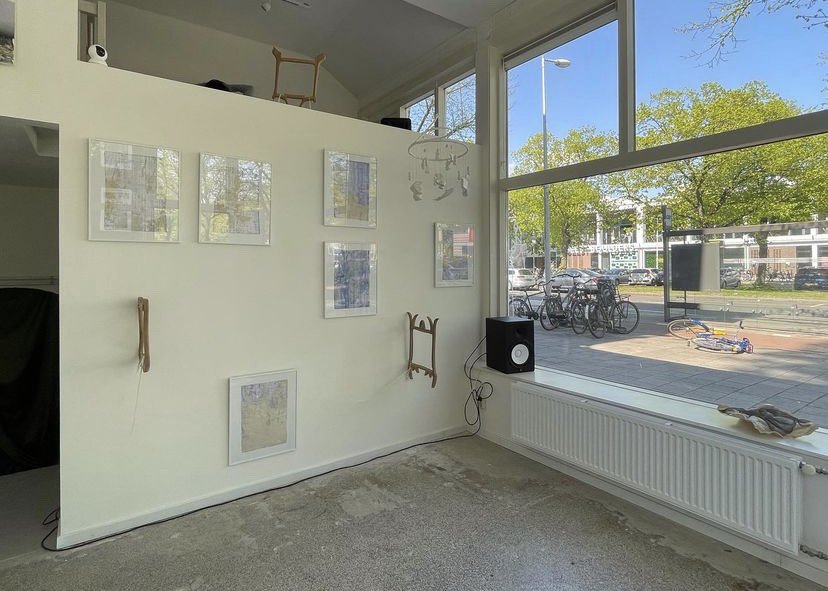
open: source space | POP-UP
open: source space takes over NMAG KIOSK for a pop-up show of friends that join forces in creating an exhibition, in search for a more democratic manner of representation within the field of arts. Creating a landscape of relational elements that bind each other together. With focus on communal space as leading factor.
Alongside the exhibition, the program exists out of live performance, music and a custom made menu by close friends.
Friday 22nd of April opening 5 - 10PM
Saturday 23rd of April dining
Book dinner via DM on Instagram of open:source space: @o.s.space. Max. 24 spots available
Sunday 24rd of April finissage 6 - 10PM
*open:source space will be held at NMAG KIOSK, Willem de Zwijgerlaan 327
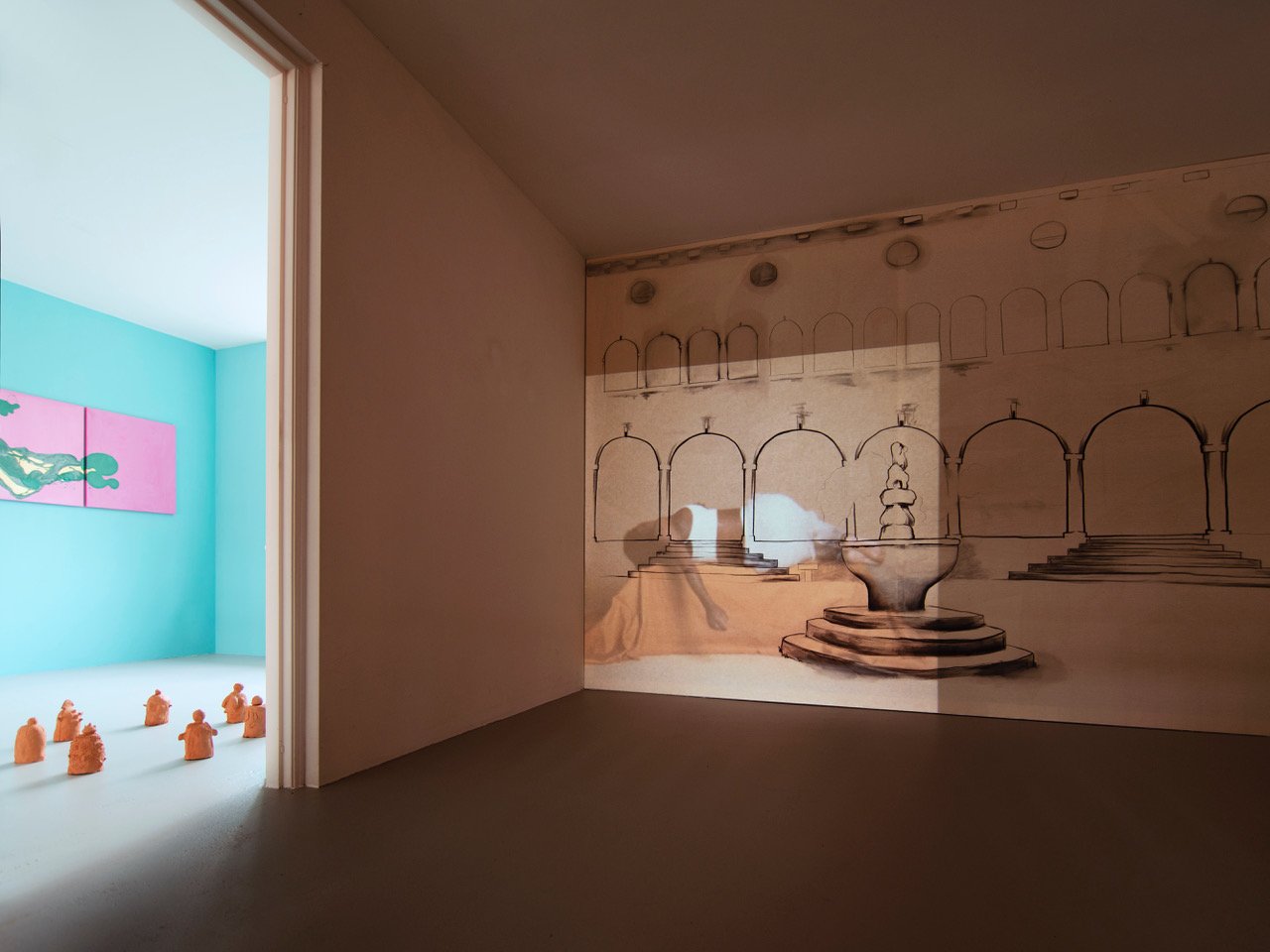
Impilo Inegama | Buhlebezwe Siwani
06.02 - 27.03 2022
No Man’s Art Gallery is honored to present Impilo inegama, the second solo exhibition of Buhlebezwe Siwani (1987, ZA) at the gallery.
In Impilo inegama (loosely translated: Life has a name), Siwani addresses how Black motherhood is not viewed in a tender manner as one would view the process of becoming a mother, primarily because Black women’s bodies and fertility have not always belonged to themselves.
“When we hold conversations on and about slavery, we are focused on the bodies that make a voyage, rarely do these conversations touch on women who were kept as slaves whose sole purpose was to bear children who could work as slaves themselves.” (Siwani) A new series of soap paintings reflects on the experience of motherhood for these enslaved mothers and the voyage of the foetus within the mother’s body. Their titles Mdlezana translated from isiXhosa mean new mother, as this will be the only phase of motherhood these mothers get to experience before their babies are taken away from them.
In the video Ulishiyele bani ibele (2022), directly translated from isiZulu meaning “who did you leave the breast for?” We see the artist, herself carrying a child, performing repetitive rhythmic movements. Her voice recites the poem The Slave Mother (1854) by Francis Ellen Watkins Harper:
He is not hers, although she bore
For him a mother’s pains;
He is not hers, although her blood
Is coursing through his veins!
In both Ulishiyele bani ibele and Mdlezana we witness the unbearable loss; - the loss of a child, of self, of motherhood, of one’s body, but Siwani also shows us an incredible strength. A vigorous force that is materialised in ceramic sculptures. In Umdali and OoMama abadala the artist honours the creator, the life giver. This strength carried by not one but a group of women; a cycle of ceramics is placed close to the ground, rooted to earth. The hand of Siwani has left behind its traces, suggestions of mark making, taking ownership over one’s own body, one’s own womanhood and one’s own fertility.
Press: “De bittere smaak van zwart moederschap” Lucette ter Borg in NRC Newspaper, March 2022
Opening hours:
Wednesday, Thursday and Friday : 12.00 - 17.00h or by appointment (call 06-3755 0132). This exhibition extends to both gallery locations in Amsterdam: Bos en Lommerweg 88-90 (mezzanine) and Willem de Zwijgerlaan 327.
Photos: Neeltje de Vries
Buhlebezwe Siwani is a visual artist working predominantly in performance and installation. Siwani completed her BAFA(Hons) at the Wits School of Arts in Johannesburg in 2011 and her MFA at the Michealis School of Fine Arts in 2015. Siwani’s work interrogates the patriarchal framing of the black female body and black female experience within the South African context. Siwani’s art practice is strongly correlated with her practice as iSangoma, a spiritual healer that works within the space of the dead and the living.
Siwani was awarded the Standard Bank Young Artist Award in 2021 and nominated for the Theodora Niemeijer Prize in the same year. Past exhibitions include Sonsbeek 20-24, Arnhem, El Espacio 23, Miami, USA; Materiality, Iziko National Gallery, Cape Town, SA; Being There, Foundation Louis Vuitton, Paris, FR; Curitiba Biennial 2019, BR; Tell Freedom, Kunsthal KAdE, Amersfoort, NL; Documenta 14, Athens, GR, Kassel, DE; Africa Raccontare un Mondo, PAC Museum, Milan, IT; Deep Memory, Kalmar Art Museum, Kalmar, SE; Busuku benzolo, Labor Zero Labor, Triangle Arts, Marseilles, FR; Reparations, Theater Spektakel, Zurich, CH.

DIONYSIA | Group Show
Afra Eisma | Abel Hartooni | Anastasia Kiseleva | Lena Kuzmich
Xavier Robles de Medina | Marijke Vasey
online catalogue
“Come with me” it whispers, oozing nectar across the brim of each bright green leaf.
In the holy woods of Stimuli they celebrate. Decorum, loose ends, abundance and decay. In disparate togetherness. In continuous metamorphosis. They wake up in a dream and enter a space of transgression
No Man’s Art Gallery is honored to present DIONYSIA, a group show that inaugurates the opening of the gallery’s second location in Amsterdam, Bos & Lommer. No Man’s Art Gallery KIOSK is located on the Willem de Zwijgerlaan 327. DIONYSIA will be on show at both locations.
Exhibition runs from 12 November - 19 December 2021
Press:
“Nieuwe Locatie No Man’s Art Gallery oogt als een theatrale etalage”, Edo Dijksterhuis, Het Parool
Photos: Sonia Mangiapane
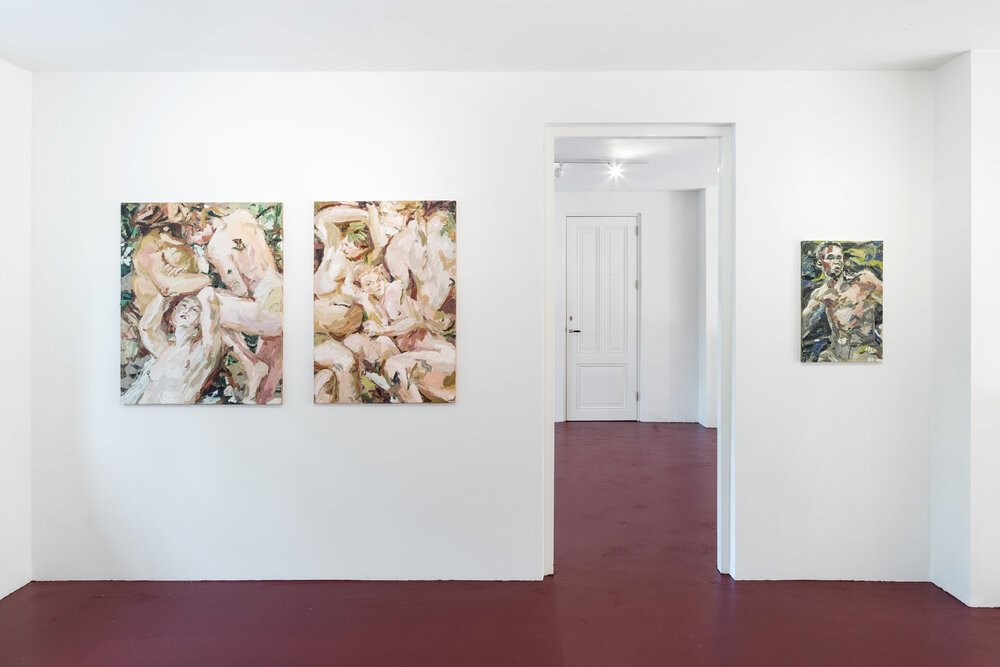
TWISTER | Mia Chaplin
online catalogue
4 September - 7 November 2021
No Man’s Art Gallery is honored to present TWISTER, Mia Chaplin’s second solo exhibition at the gallery. The works are all created in Amsterdam where she has been working as NMAG Artist in Residence over the past summer month.
TWISTER enters a body of work that oscillates between the abstract and figurative in which Chaplin explores the crooked and imperfect nature of intimate relationships. In rich impasto oil paintings and sculptures, with the immediacy of prominent brush strokes and expressive color palettes, she searches for the vivid tension between the soft and the violent, the familiar and the estranged. When it comes to passionate love, danger always lurks.
Endless kissing scenes of young love, the silent devastation after a perfect storm, an abstracted scene of two fighting dogs frozen in a deadly battle painted in fleshy pinks, reds in blues. Saliva exchanges in fights and embraces. We see bodies intertwined, wrapped, curled inwards in scenes that hint at the sensual and emotional richness of the classical baroque paintings of Rubens. Are we witnessing an act of intimacy or one of fending off?
It is the ambiguity between the works that Chaplin carefully highlights; by juxtaposing this diverse selection Chaplin makes us second guess what we see: “It's both beauty and destruction; the one who is there to love and protect also is the one that violently hurts and betrays. This body of work in general is an attempt to anxiously grapple for some kind of control. It reflects the desire to trust, to be safe and vulnerable alongside the fear of being betrayed, deceived and misled.” (Chaplin)
Photos: Sonia Mangiapane
Mia Chaplin in her studio by Jonathan Kope
Mia Chaplin (b.1990 South Africa) is a South African artist based in Cape Town. Her work is situated between painting and sculpture, with her impasto oil paintings and painted papier-mâché/plaster of Paris sculptures forming the basis of her practice. Chaplin uses materiality, colour, texture and visual motifs symbolically to address themes of identity, femininity and the body.
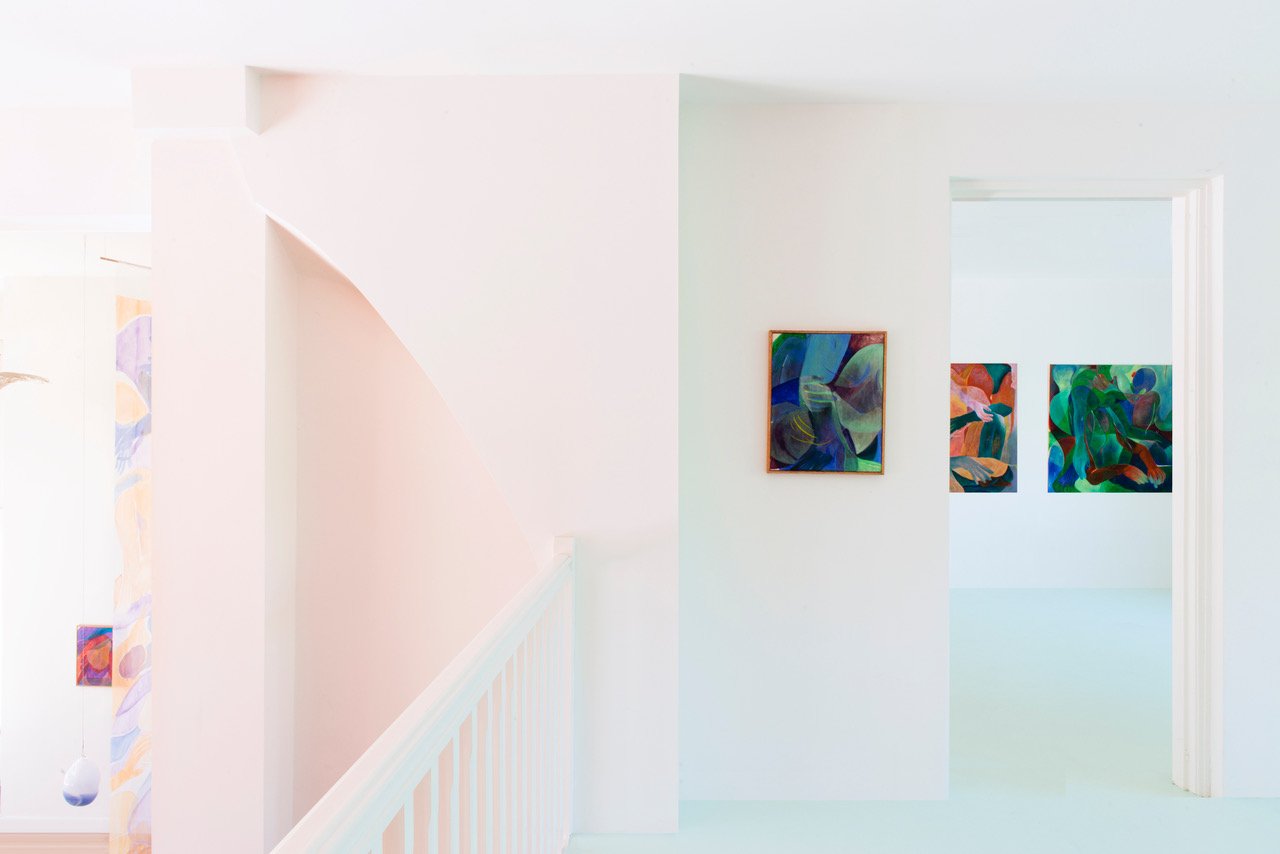
Everything is better when I’m with me | Marilyn Sonneveld
online catalogue
19 June - 19 August 2021
NMAG is honored to present “Everything is better when I’m with me” the second solo exhibition by Marilyn Sonneveld (1990, NL) at the gallery. Sonneveld will show a new series of oil paintings and glass objects made in the past year.
“Everything is better when I’m with me” conveys a personal narrative, one that takes us inwards, in which Sonneveld explores the vulnerabilities and insecurities of herself and her artist-hood. The year of self isolation made her studio her center and pushed Sonneveld to explore her own limits and focus solely on her autonomous practice. In the paintings we see genderless and faceless figures taking on introverted and intimate postures. They are alone but not lonely. “The paintings touch upon a sense of desire, gut feeling and fantasies that one carries within, but is not always in touch with. To me they represent a journey of self acceptance, in my autonomous practice, in my ability to dive into painting even with the self doubt. Once you find that inner connection through intimacy, in the broadest sense of the word - everything gets better.” (Sonneveld)
In the postures we recognize a touch of the toe while leaning backwards, wrapping one’s body with arms and legs, sitting cross-legged and face down, fiddling with hands; all of them carry with them an emotion, a time and place. Figures in glass, zooming in and taking out, playing with organic shapes, brought to life by Sonneveld’s vivid use of colour. “The figures might be introvert but the colors counter with lots of expression and presence. The colors allow me to be totally free while painting, to work in the moment and think of nothing, as nothing else exist.” (Sonneveld) This enjoyment; the loss of time, insecurity, self doubt or better said: the inevitable presence of those feelings but the enjoyment despite them might be exactly what “Everything is better when I’m with me” wants to share with us.
Everything is better when I’m with me” will be on show from June 19th till 22nd of August 2021. For more information, please contact info@nomansart.com
This exhibition is kindly made possible by AFK
Photos: Neeltje de Vries
Marilyn Sonneveld in her studio. Photo Lisette van Hoogenhuyze
Slow Cure | Sisse Holst Pedersen & Bertrand Peyrot
online catalogue
09.04 - 23.05 2021
Opening weekend: 9, 10 and 11 April 2021
No Man’s Art Gallery is honoured to reopen the gallery with Slow Cure a duo exhibition by Sisse Holst Pedersen (DK) and Bertrand Peyrot (FR). Both artists have created new pieces for the exhibition.
For Slow Cure Holst Pedersen presents a series of new and old sculptures, together showing an intimate and instinctive interaction between the artist and the objects. A shiny blue arch corporeally enfolded by its matte black counter form, enacting a slow sensual choreography in Parasite, 2020 and Corner Snake (2019) a foetal-like form that in a very slow pace seems to spoon its own pedestal. Many pieces hold a golden round shape, carefully caressed into their nests. The simplicity of a ball-shape, that which fits exactly in the warmth of one's palm. All pieces reveal countless traces and fingerprints of Holst Pedersen’s hands. One can sense a primal human need in the pieces: a longing for physical touch, that has become even more sensible in a present that forces distance upon us. “I let my entire body affect the clay while in return the clay affects my body. My work can be considered as a plea for a more sensory engagement.” (Holst Pedersen)
The instinctive interaction between Holst Pedersen’s sculptures and their surroundings extend to Bertrand Peyrot’s oxidized metal paintings. Their presence enriches the sensory and tactile experience of the sculptures, who, in return, seem to invite the visitor to direct their attention back to the plates. Large quadrilateral metal surfaces appear to have been taken over by a slow process of oxidation. Emergent colours and contrasts create ambiguity in what has been controlled by the artist and what was surrendered to nature’s course. The strong and still impressions conceal the ongoing process of oxidation that will change the painting’s image over time.
Slow Cure will be on show from 9 April - 23 May 2021 at Bos en Lommerweg 88/90. For more information please contact: Safira Taylor info[at]nomansart.com
To book a time slot please call or Whatsapp 31 6 3755 0132
Photos: Neeltje de Vries

When cotton catches fire | Arash Fakhim
ONLine catalogue
14 December 2019 - 16 February 2020
No Man’s Art Gallery is honored to present when cotton catches fire, the first solo exhibition by Arash Fakhim (1987). Rather than being merely a collection of objects, when cotton catches fire ought to be regarded as an artist’s mind map, showing the transferal features of objects in relation to the artist and each other. The title is inspired by the theory of object-object relations formulated by philosopher Graham Harman. According to Graham, things have a depth to their being that is never fully revealed or exhausted in their dealings with other things (or human beings).* Fakhim questions the naturalness with which we characterise objects being aspects such as color, usability and smell etc. He plays with our perception of what an object is by mashing it up, changing its attributes and displacing it:
“I create new dialogues by approaching things differently than what they at first sight communicate. By misplacing and abusing them, I try to get the thingness out of things, for example taking the bagness out of bags. In this way I question the function of a thing through its substance-specificity”
For his new Pardeh series (2019) it was the Dutch suburban streetscape that caught the artist’s eye. There, in front of lace curtains, miniature Buddhas, plastic ornaments and decorative stickers adorn the windowsills of Dutch houses, a visual language that so effortlessly put all that he had been doing in reverse. These paintings are based on the shimmering projection of objects and their reflection in the window and onto the curtain. Not making any distinction towards the spatial, the flat or the material but rather creating an image wherein these aspects collide.
when cotton catches fire shows the clash of elements stacked on top of each other and compressed into a mash which Fakhim often describes as a “broodje kapsalon”**. Fakhim shows us the perspective of an outsider that questions and alters the status quo of a certain culture, material, object or thing. By working with a diaspora of things in which he himself shapes and redefines the qualities of perceptual representations, Fakhim traps them in their actual transitional state. Consciously challenging and playfully affirming a plurality of realities and directions.
* According to Graham when fire encounters cotton it “relates” to the cotton primarily by way of its flammability. All other aspects of cotton’s being – its color, usability, smell, etc. – withdraw from the fire’s relation with cotton.
** A “broodje kapsalon” is a dish consisting of fries, shoarma or döner, topped with grilled cheese and fresh salad. Often served with garlic sauce or sambal.
Photos: Chun-Han Chiang & Neeltje de Vries

Sofreh
Gijs Assmann, Niko Lee Gail Démoed, Bonno van Doorn, Mischa Doorenweerd, Daan Gielis, Maurice Gobert, Lisette van Hoogenhuyze, Bas van den Hurk, Susanne Khalil Yusef, Anastasia Kiseleva, Gijs van Lith, Hemaseh Manawi Rad, Cengiz Mengüç, Golrokh Nafisi, Ulrike Rehm, Niko Riedinger, Maria Roosen, Anđela Vidić and Manon Wertenbroek
Credits: Cengiz Mengüç
14 December 2019 - 16 February 2020
The pre- revolution films and music of Iran that my mother viewed and listened to, together with Western culture, which trickled in through the TV, formed my imagery and youth. Films, animations & music were swallowed up regularly in order to give meaning to the “inter-spatial” existence of an outsider. I think this assembly and (also referred to as) clash is still visible in my works. Whether it is interwoven in its entirety or where parts are shown as separate components in my works, the battle is visible in most cases. This is done through materials and techniques within various media. For the composition of a group show I went looking for artists to whom I feel connected, be it artistically, in the process or on a spiritual level.
“Traditionally, the Sofreh is a term for an iconic Persian fabric served as the backdrop for seasonal feasts and celebrations. Over time, the term itself has taken on a larger cultural significance: it refers to a gathering, a sharing, a place for family and friends to come together”
In this way I came naturally to a daily used Iranian word; Sofreh. One of the cultural characteristics that I have been able to inherit is the hospitality. In addition, the generosity that I would like to use artistically to furnish the space of NMAG with works by my related artist’s family & friends. An exhibition that generates gathering, using an old traditional cultural signifier.
- curated by Arash Fakhim
Photos: Chun-Han Chiang

west of where the sun goes down
05 - 29 September 2019
Since 2011 No Man’s Art Gallery has opened temporary galleries in Rotterdam, Hamburg, Mumbai, Amsterdam, Paris, Copenhagen, Cape Town, Shanghai and Tehran showing the work of many young artists in atomic shelters, warehouses, historical residences and graveyards.
Exactly one year ago, the gallery opened a permanent gallery space and bar in Bos & Lommer hosting an exhibition program influenced by the artists and networks we started collaborating with abroad.
The only way to celebrate our 1 year anniversary here in Amsterdam West is by inviting the artists that have been contributing to our international pop-up program over the past 7 years.
Photos: Dieuwke Eggink
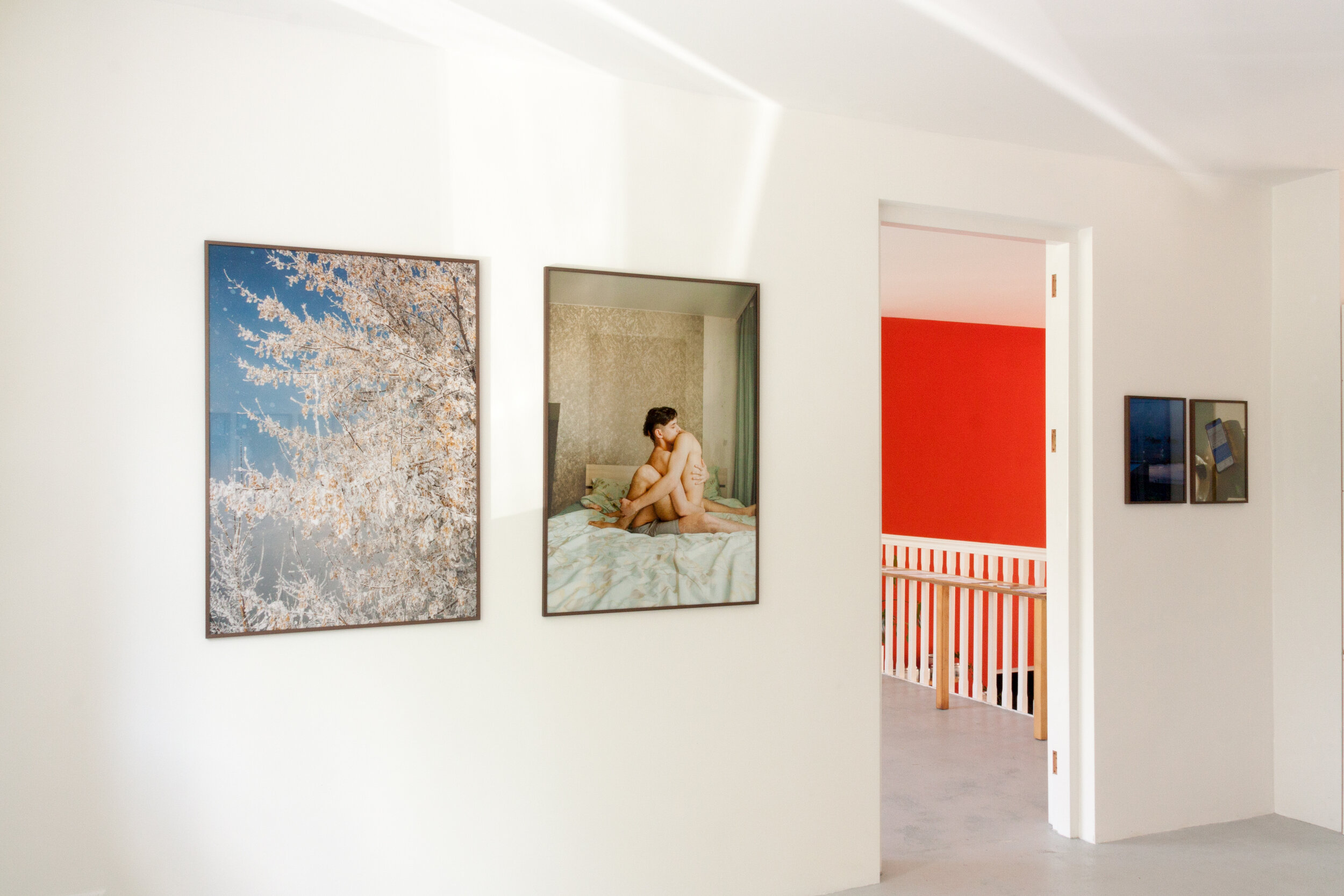
Goluboy | Desiré van den Berg
online catalogue
8 June - 18 August 2019
“Reality enters our senses as a kaleidoscopic flux of impressions”, linguist Whorf (1897-1941) once said. This flux must be sorted out in our brains and the structure of our language plays an important role in this. It is estimated that over 7000 different languages are spoken worldwide. All of these languages differ from one another and ask of different information from their speakers. The hypothesis of Linguistic Relativity questions to what extent the language we speak shapes the way we think and, consequently, view the world. If the language you speak has no word for a certain object or concept, does that mean that you’re not capable of thinking about it?
As a photographer with a BA in General Linguistics this question grasped the imagination of Desiré van den Berg, since this could imply that one not only listens but also looks in the language one was taught from birth – purely by chance. It brought her through the heart of Russia, a travel by train through frozen tundra, barren plains and bustling cities, spanning six time zones and ten thousand kilometres. All in search of goluboy – a colour that does not exist in her native tongue.In Russian, goluboy means light blue. Dark(er) blue is siniy. Unlike Dutch (or English), where light and dark blue are two shades of a single colour, in Russian they are separate, each carrying their own associations and implications. As a result, it has been found that this for example affects memory in the way that a non-native Russian speaker is less able to accurately remember the shade of perceived blue. GOLUBOY challenges us to cut our concept of blue in half and maybe even learn to ‘look’ in a different language.
“I followed the path of the Russian language from St. Petersburg, via Moscow to Vladivostok, and captured blue as I know it, all the while exploring the edges and boundaries of my perception. Changing skies and waters along my way showed me blue in all its hues and even the snow adopted a blue glow during twilight hours. It made me wonder: if programming already happens at the unconscious level of language processing, what are the consequences on conscious thinking? What is the role of our language systems in a world of growing polarisation? By using color categorisation in language as an example of the possible underlying process of intuitive thinking, I’m hoping to bring awareness to the subject of subliminal mental boundaries.” - Desiré van den Berg

Underbelly | Mia Chaplin
online catalogue
8 June - 18 August 2019
Mia Chaplin is a painter who lives and works in Cape Town and the second artist-in-residence at the gallery’s permanent space in Bos en Lommer, where she has been working on her new presentation for the past month.
Working in oil on canvas and paper, her highly expressive works are characterized by their rich impasto surfaces and visible brushstrokes. Chaplin’s most recent works emphasize a muted colour palette of pink fleshy tones and golden highlights, consisting of still life, figure studies and landscapes.
For ‘Underbelly’ Chaplin created paintings and sculptural objects, in which she explores the crooked, misshapen and imperfect nature of intimate relationships as they manifest in private environments. Chaplin is interested in gendered power structures and how identity is performed through societally-entrenched femininity. The fracturing of these intimate images suggests a feeling of disrepair or destruction. There is an attempt to garner control and autonomy, a holding together of something which keeps falling apart. ‘Underbelly’ is the urge to create a solid feeling, and the need to understand and own agency.
Since completing her BFA at the Michaelis School of Fine Art in Cape Town in 2011, Chaplin has hosted several solo exhibitions Mouth (2018) and Under a Boiling River (2017), both with WHATIFTHEWORLD. She has also recently extended her painting practice into printmaking, hosting a mini-exhibition of monotypes from the series, The Making of a Sharp Blade (2017), in collaboration with Warren Editions, Cape Town. Chaplin has completed artist residency programs at Cité Internationale Des Artes in the Marais district, Paris (2018), Nirox Arts Foundation in Johannesburg, South Africa (2016) and at OBRAS Foundation in Alentejo, Portugal (2015)
Photos: Dieuwke Eggink
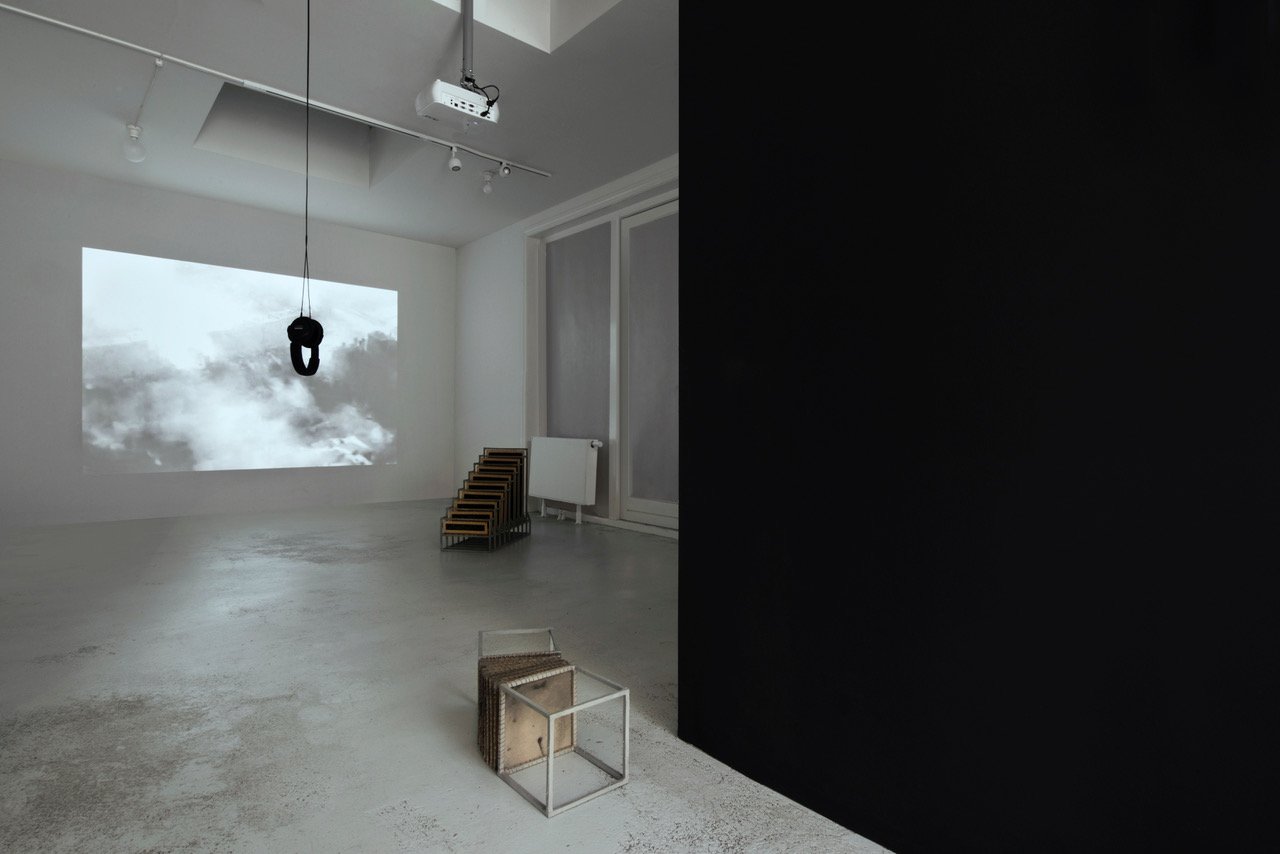
Recollection| Majid Biglari
9 March - 5 May 2019
No Man’s Art Gallery is honored to present RECOLLECTION, the first solo exhibition by Majid Biglari in Amsterdam. The in Tehran-based artist is the first artist-in-residence at the gallery’s new location in Bos & Lommer and has been working on a new series on site for the past two months.
RECOLLECTION shows his new series titled Mourning (2019) consisting of sculptures, a photographic installation, paintings and a video, which is the result of the artist’s archival collection of various global events of terror, loss and natural disasters.
Living among the ruins has become an inseparable part of life. The remains are raw, scattered and inconsistent signs of all things that no longer exist. The subdued experience of living in the new world order will not erase these facts from our daily existence, as images, news, and information are readily available to us throughout different media. We find ourselves among the ruins everywhere. The availability of information does not increase awareness or prevents the ruins, but normalizes them, while people continue living in ignorance. Ruins become reduced experiences of humans.
Majid Biglari presents five memorials, objects in which he addresses the absence of their initial traces. What is left is solely their aesthetic formal quality. Memorials, with the accumulation of their bitter memories, are becoming useless, fake bodies; structures that reproduce aestheticized versions of disasters, while they become part of it. When humanity does not take time to mourn, monuments of oblivion are produced one after the other in old and new formats. Numbers lose their expressiveness and return to their formal, abstract nature.
Majid Biglari (Iran, 1986) earned his BA in Sculpture from Tehran University of Art. He has exhibited his work in various solo and group exhibitions in amongst others at TMoCA as part of the 7th Edition of Tehran National Sculpture Biennial, Mohsen Gallery Tehran, Rogue Space New York and No Man’s Art Pop-up Gallery Tehran in 2016. Majid Biglari lives and works in Tehran.
Photos: Neeltje de Vries











